Which Conditions Can Hydrotherapy Help?
Hydrotherapy is a valuable treatment in the rehabilitative and maintenance phase of many conditions. The proven physiological and hydrodynamic properties of water promote the modification of pain and increase function, enabling the patient to rehabilitate more rapidly and safely than on land.
Find below a list of many of the conditions that can be helped through hydrotherapy. It is impossible to list all the conditions and situations that hydrotherapy and physiotherapy may help, so if you are unsure please call us to discuss on 07703 774199. Click on the conditions below or scroll down to find out more about how hydrotherapy can help.
Hydrotherapy is a valuable treatment in the rehabilitative and maintenance phase of many conditions. The proven physiological and hydrodynamic properties of water promote the modification of pain and increase function, enabling the patient to rehabilitate more rapidly and safely than on land.
Find below a list of many of the conditions that can be helped through hydrotherapy. It is impossible to list all the conditions and situations that hydrotherapy and physiotherapy may help, so if you are unsure please call us to discuss on 07703 774199.
Click on the conditions below or scroll down to find out more about how hydrotherapy can help.
Which Conditions Can Hydrotherapy Help?
Hydrotherapy is a valuable treatment in the rehabilitative and maintenance phase of many conditions. The proven physiological and hydrodynamic properties of water promote the modification of pain and increase function, enabling the patient to rehabilitate more rapidly and safely than on land.
Find below a list of many of the conditions that can be helped through hydrotherapy. It is impossible to list all the conditions and situations that hydrotherapy and physiotherapy may help, so if you are unsure please call us to discuss on 07703 774199. Click on the conditions below or scroll down to find out more about how hydrotherapy can help.
Hydrotherapy is a valuable treatment in the rehabilitative and maintenance phase of many conditions. The proven physiological and hydrodynamic properties of water promote the modification of pain and increase function, enabling the patient to rehabilitate more rapidly and safely than on land.
Find below a list of many of the conditions that can be helped through hydrotherapy. It is impossible to list all the conditions and situations that hydrotherapy and physiotherapy may help, so if you are unsure please call us to discuss on 07703 774199.
Click on the conditions below or scroll down to find out more about how hydrotherapy can help.
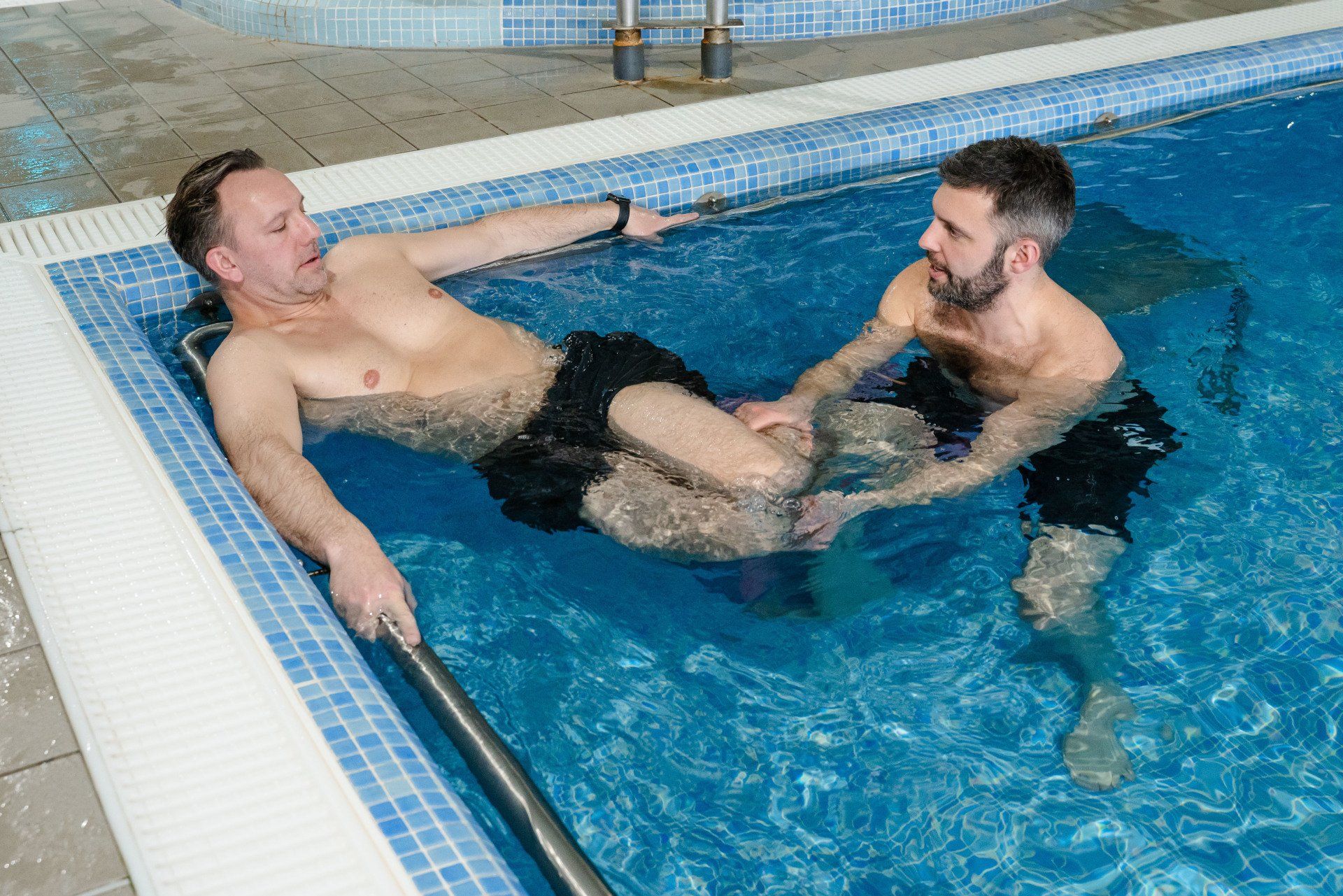
Slide title
Write your caption hereButton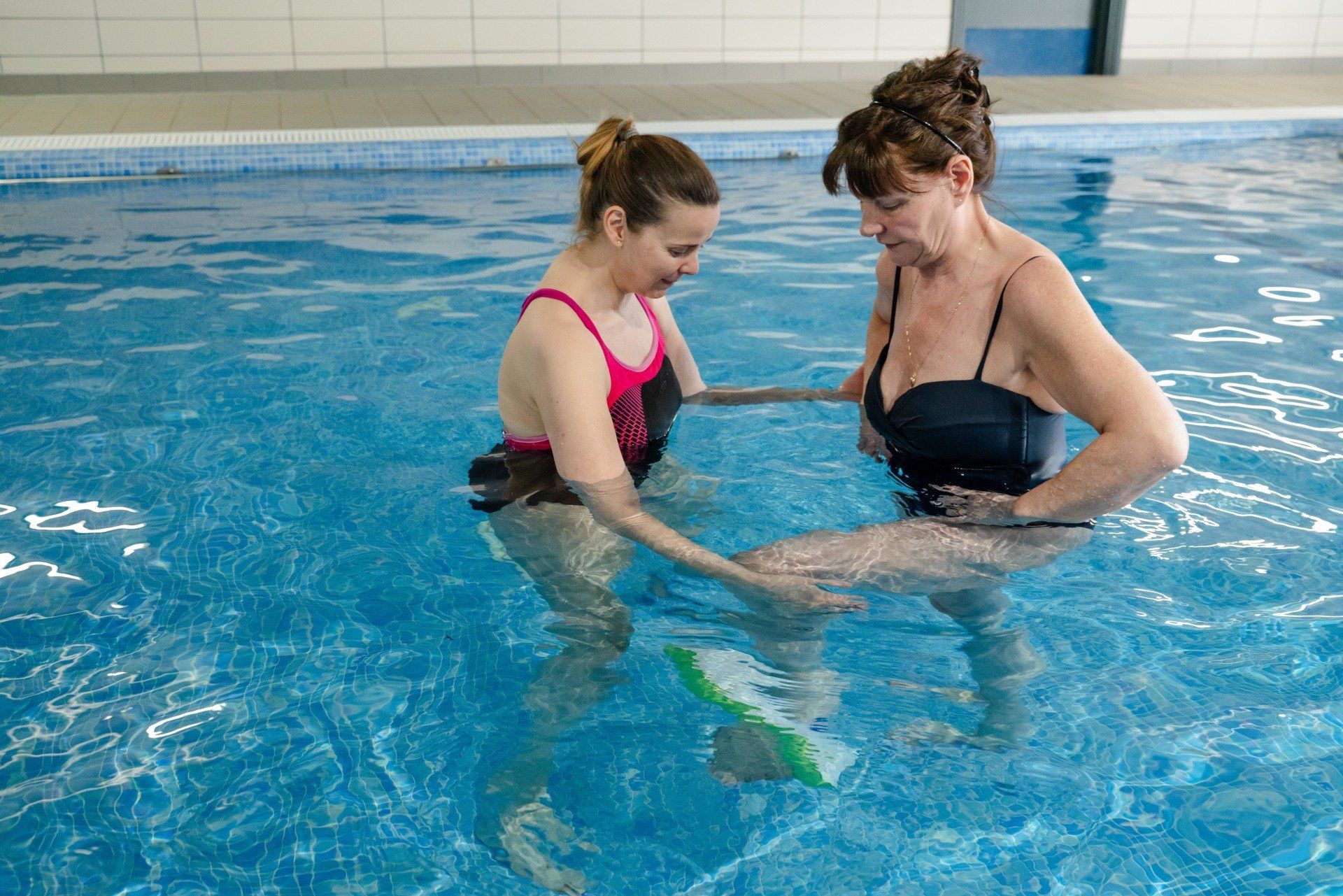
Slide title
Write your caption hereButton
Slide title
Write your caption hereButton
Slide title
Write your caption hereButton
Slide title
Write your caption hereButton
Orthopaedic Injuries
E.g. Post surgery, shoulder, knee, hip, back and ankle problems, muscle soreness, joint pain, restricted mobility and stiffness.
As physiotherapists, we work with the whole body and the musculoskeletal system, muscles, bones and joints are at the centre of our work.
Any injury to these areas can have knock on effect throughout the whole body so treatment is not just focused on the injured part but on everything else too.
Hydrotherapy is so valuable as once in the water every body system is activated and weaknesses and strengths that were not noticeable on land become apparent.
- The buoyant support of the water allows easy positioning of the body where you can work all round it and have no impedance to movement such as a treatment plinth on land.
- Graded strengthening is achieved to specific areas using the water properties and equipment.
- Manual techniques are more readily accepted due to relaxed tissues and warmth and so can be more effective than on land.
- Normal movement and function is achieved from day 1 due to pain relief and support of water so compensatory problems are reduced.

Slide title
Write your caption hereButton
Slide title
Write your caption hereButton
Slide title
Write your caption hereButton
Slide title
Write your caption hereButton
Slide title
Write your caption hereButton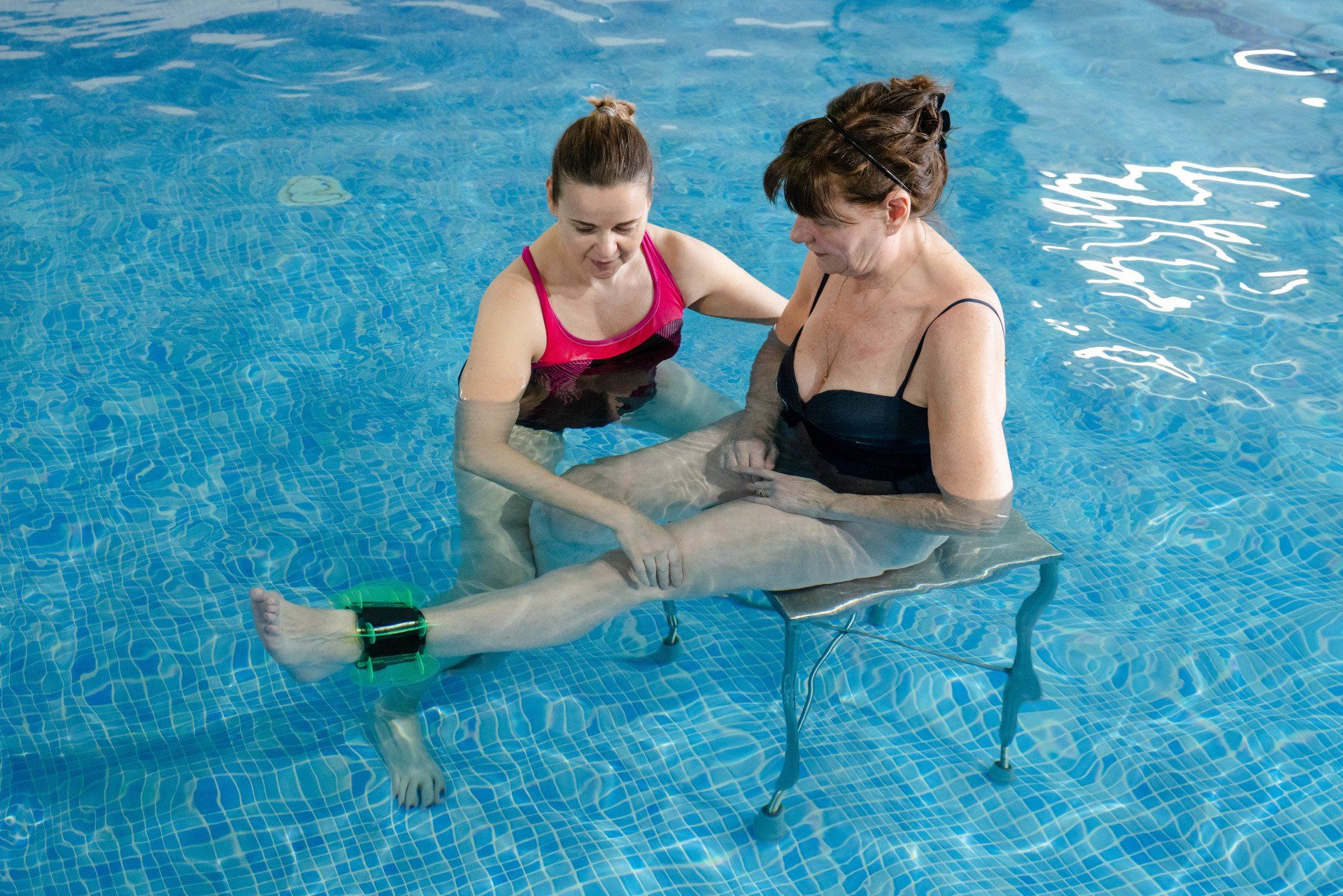
Slide title
Write your caption hereButton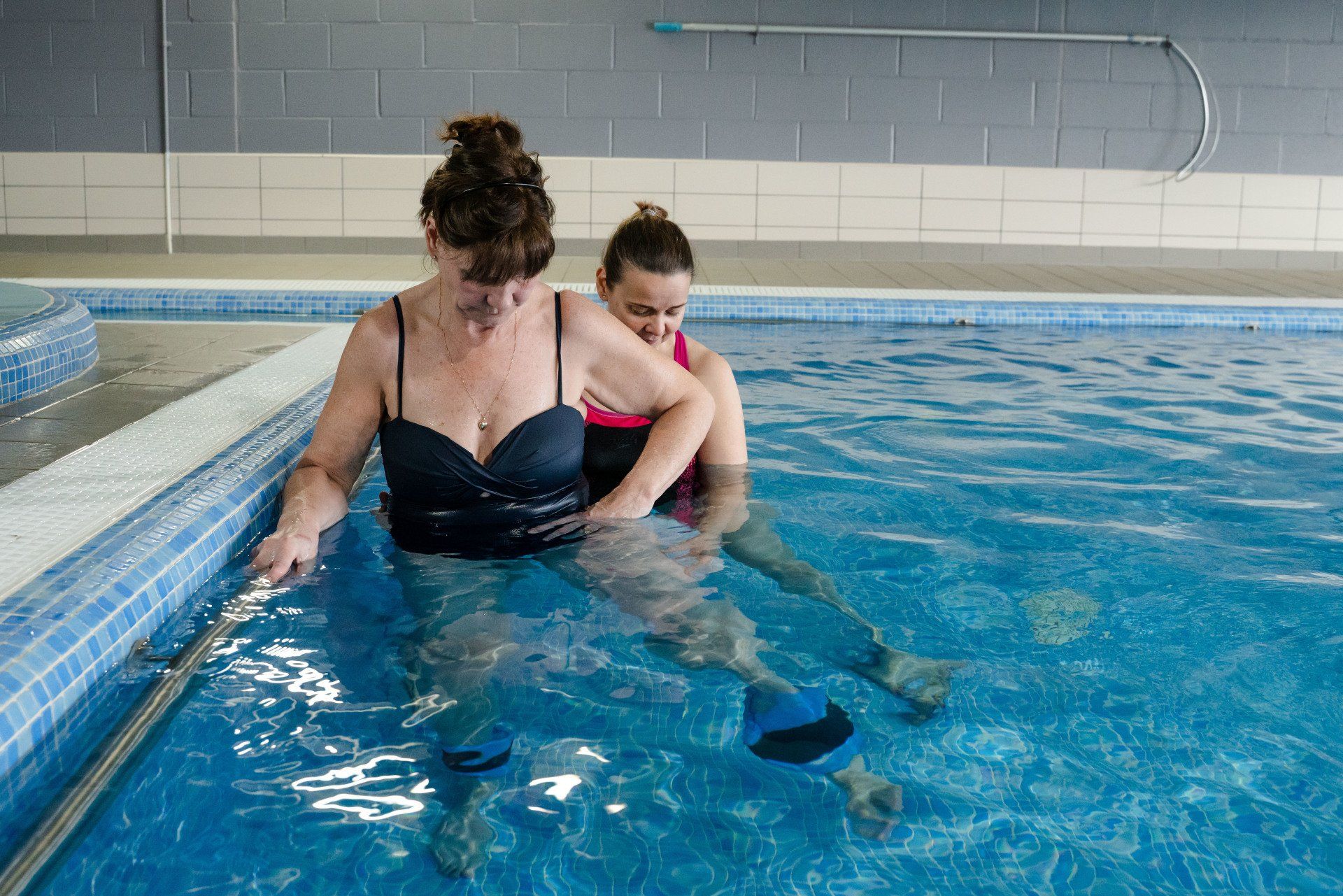
Slide title
Write your caption hereButton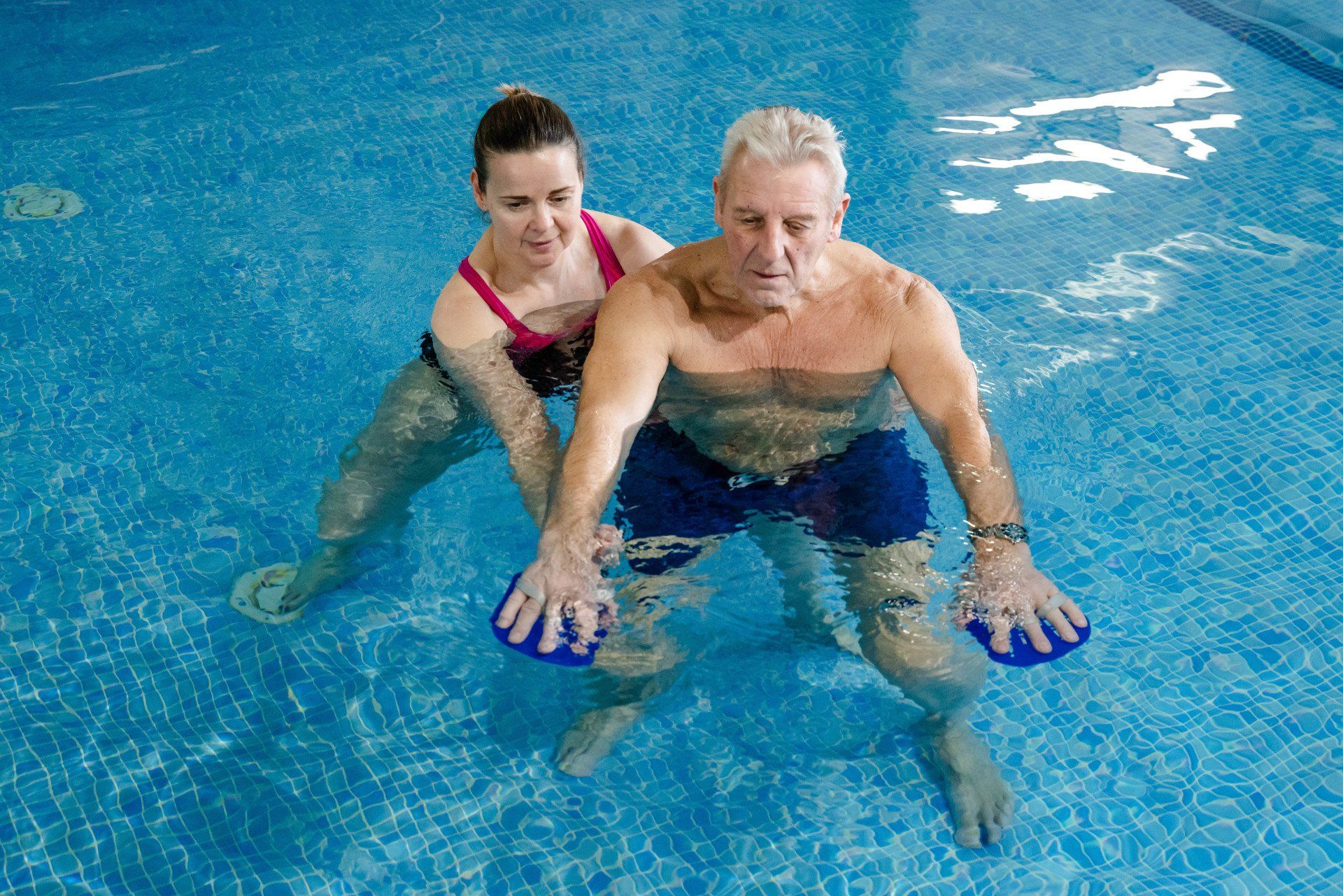
Slide title
Write your caption hereButton
Slide title
Write your caption hereButton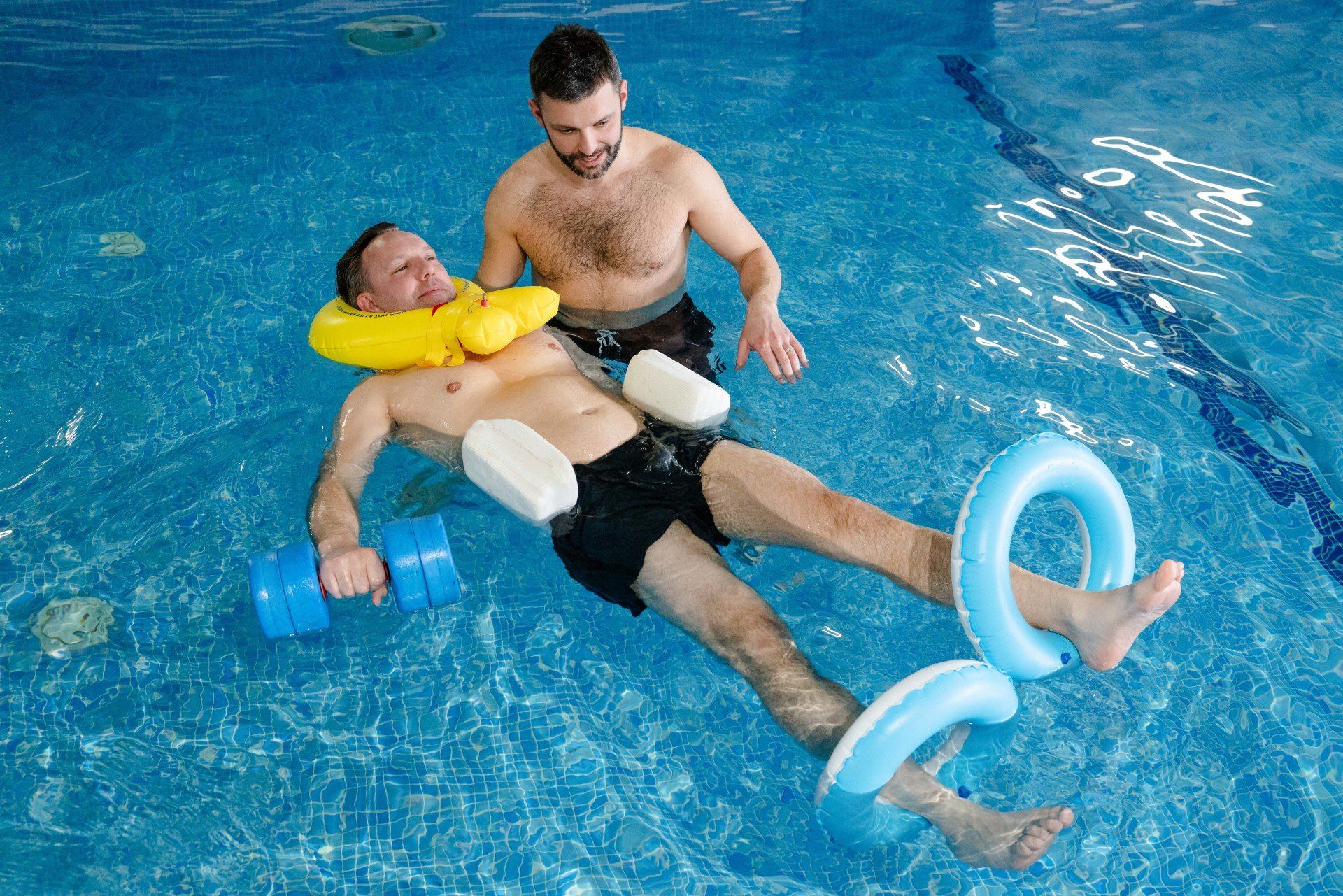
Slide title
Write your caption hereButton
Joint Replacements
E.g. Hips, knees, shoulders, ankles.
Joint replacements are a common surgical procedure, most often used to replace severely arthritic joints, thereby eliminating pain and improving function.
While they can be extremely effective, a joint replacement is only the first step in an overall process of rehabilitation, without which the results will be far less effective and there is a high likelihood of persistent problems and pain. Fully engaging in effective rehabilitation from the start is therefore essential. Unfortunately it is not uncommon for there to be pain during the recovery period.
Hydrotherapy can be a fantastic way to tackle the rehab process. (once surgical wounds are healed):
- Warmth of water helps to relax muscles making necessary joint motion less painful.
- Buoyancy offloads operated joint making the necessary exercises to regain strength and mobility much less painful.
- Hydrostatic pressure helps to reduce the post-surgical inflammation which can last many weeks.
- Early in rehab the buoyancy and drag of the water can be used to gently encourage more mobility in the operated joint.
- Water resistance can be used to build strength in the weakened muscles around the joint.
- Essential balance retraining can be undertaken with the support of the water removing any risk of falling.
Joint Replacements
E.g. Hips, knees, shoulders, ankles.
Joint replacements are a common surgical procedure, most often used to replace severely arthritic joints, thereby eliminating pain and improving function.
While they can be extremely effective, a joint replacement is only the first step in an overall process of rehabilitation, without which the results will be far less effective and there is a high likelihood of persistent problems and pain. Fully engaging in effective rehabilitation from the start is therefore essential. Unfortunately it is not uncommon for there to be pain during the recovery period.
Hydrotherapy can be a fantastic way to tackle the rehab process. (once surgical wounds are healed):
- Warmth of water helps to relax muscles making necessary joint motion less painful.
- Buoyancy offloads operated joint making the necessary exercises to regain strength and mobility much less painful.
- Hydrostatic pressure helps to reduce the post-surgical inflammation which can last many weeks.
- Early in rehab the buoyancy and drag of the water can be used to gently encourage more mobility in the operated joint.
- Water resistance can be used to build strength in the weakened muscles around the joint.
- Essential balance retraining can be undertaken with the support of the water removing any risk of falling.
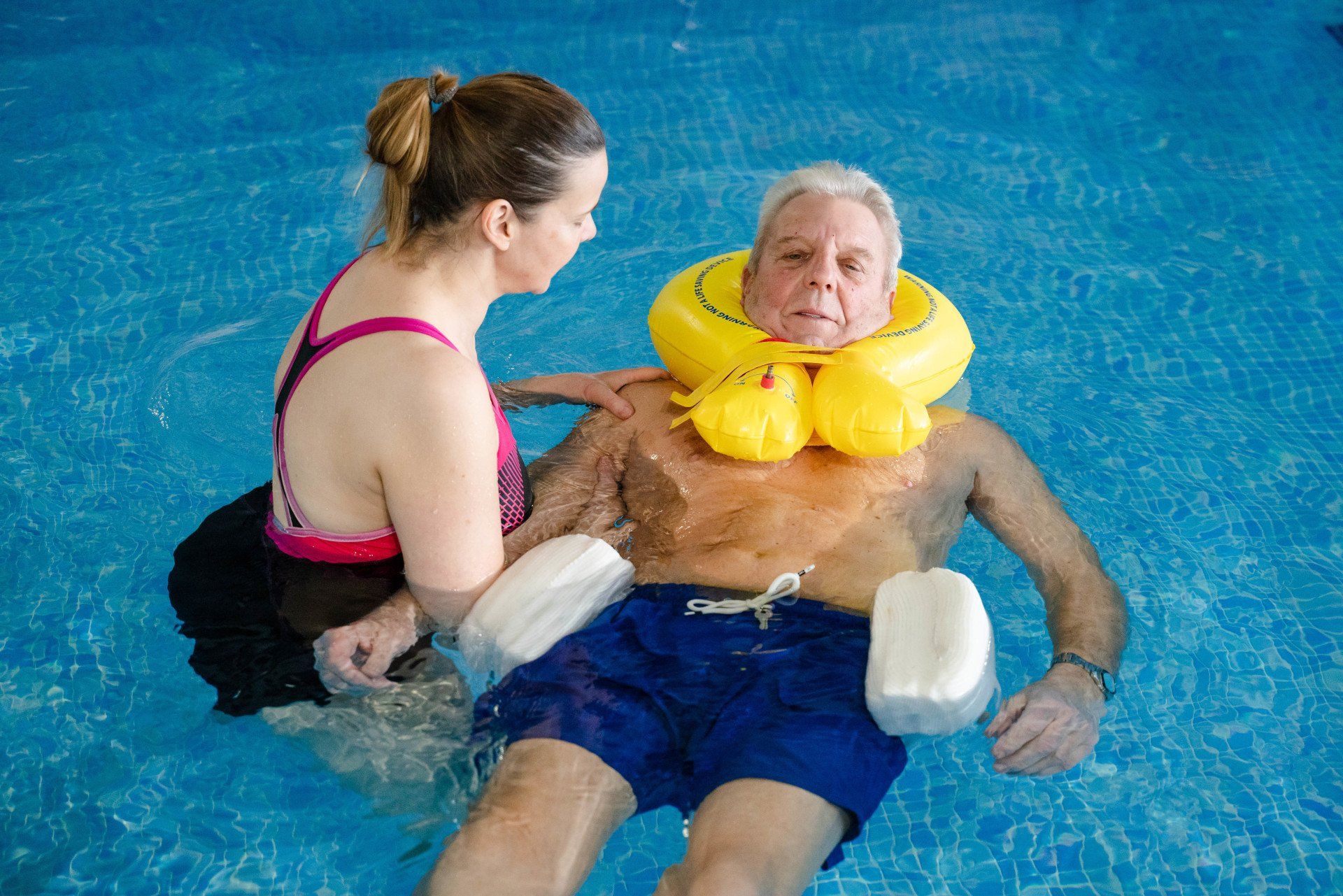
Slide title
Write your caption hereButton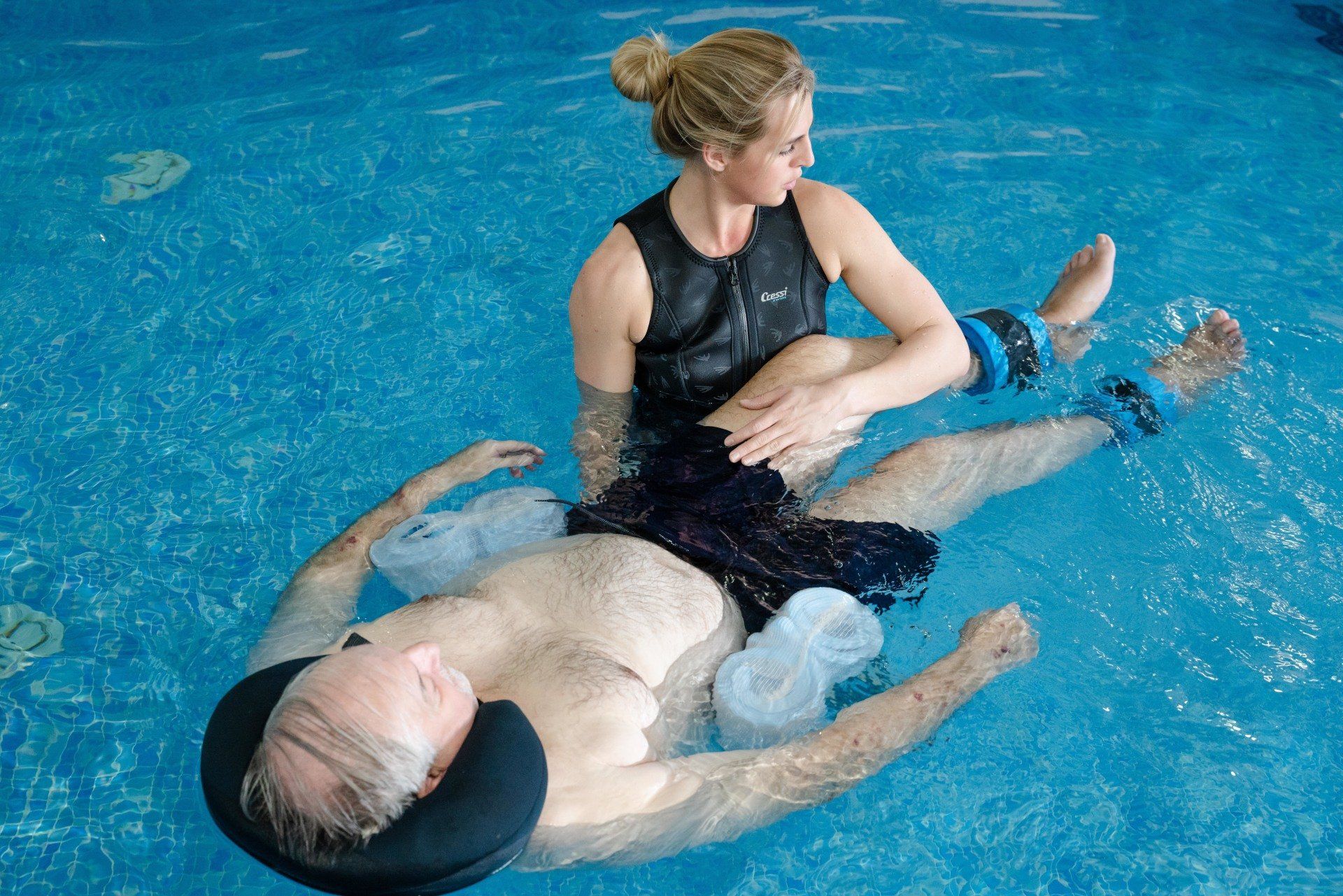
Slide title
Write your caption hereButton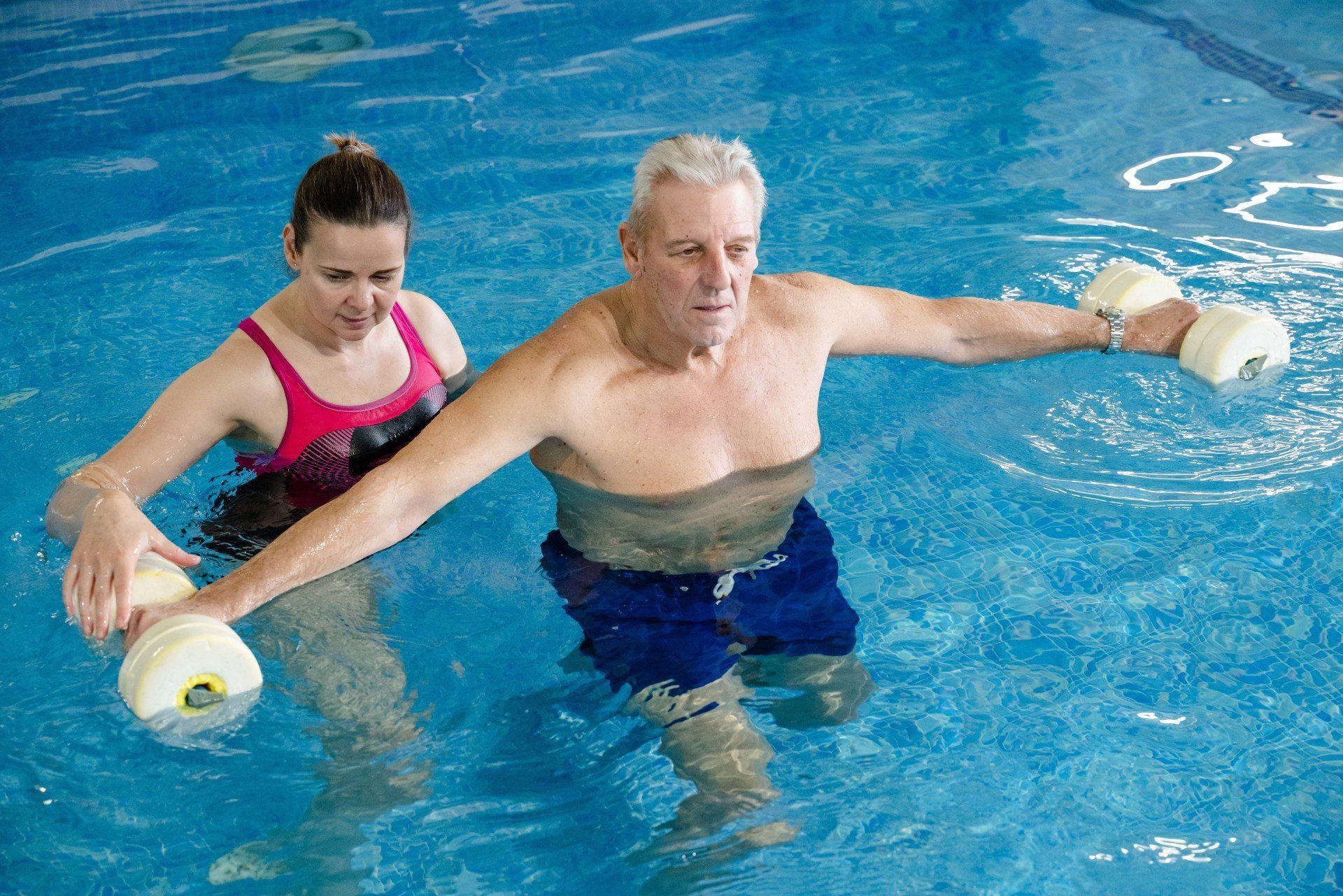
Slide title
Write your caption hereButton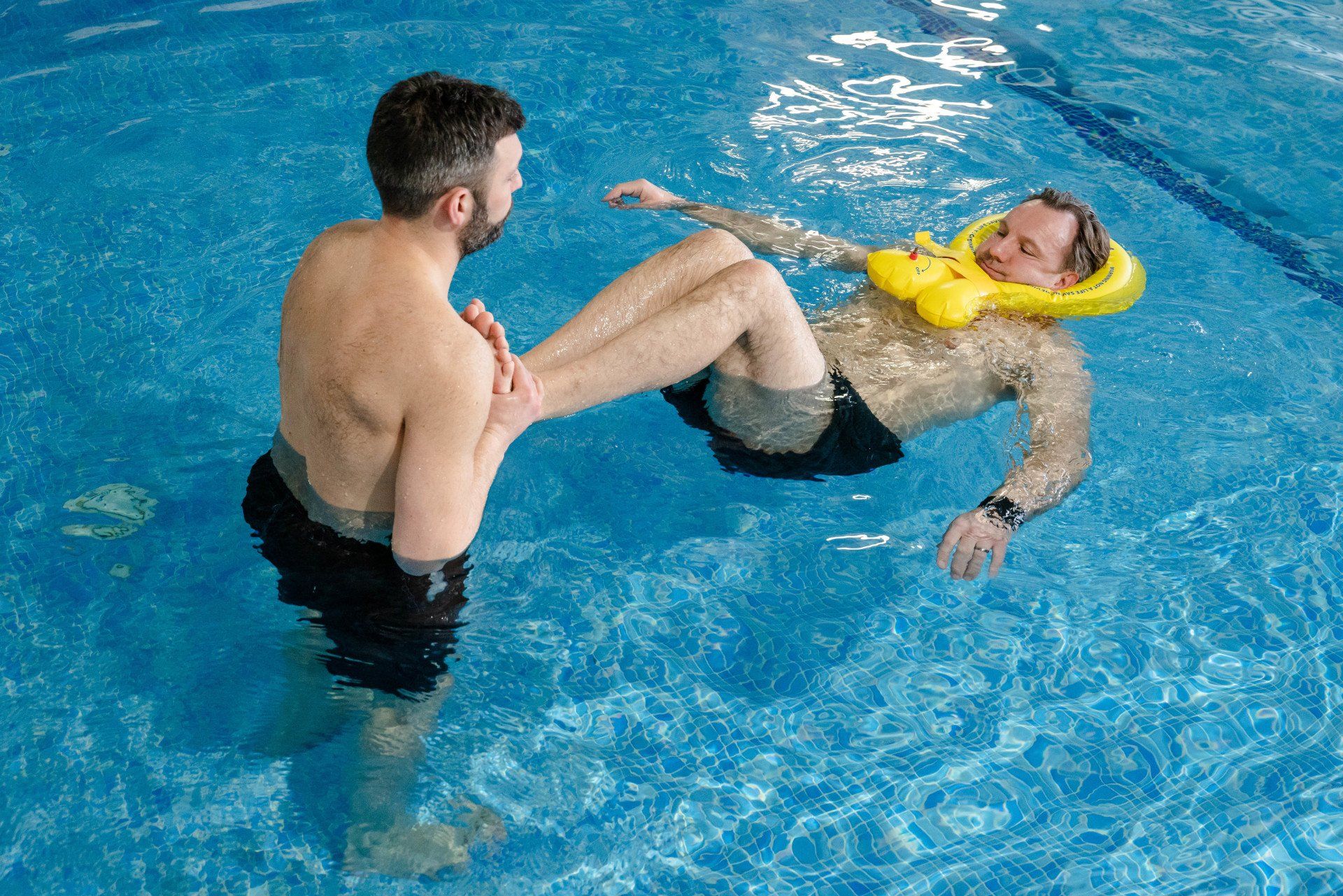
Slide title
Write your caption hereButton
Fractures, Dislocations & Trauma
E.g. Fractures (broken bones) and dislocations (disruption of joints/bone positioning).
Treatment often involves a period of immobilizations (casting), internal fixation (plates, screws or wires) or limitation of use in some way. This frequently causes problems with joint stiffness, muscle wasting and pain and even when the initial injury has repaired can result in impaired function and movement.
Hydrotherapy provides an ideal mode of rehabilitation for all these injuries:
- Hydrotherapy is ideal during the non weight bearing stage of lower limb injuries as it allows full muscle work to the affected part and rest of the body to prevent any fitness deterioration and muscle wasting. Cast covers can be worn which are fully waterproof.
- The water provides a warm supported environment, which helps to improve joint movement and function.
- The resistance of the water encourages muscle strengthening and improved balance, whilst the water pressure reduces swelling.
- Guided and assisted by a specialist hydrotherapist, exercises and therapy are specifically tailored to your injury and individual needs – pain free!
- Physiotherapy transfers and progresses the benefits gained from the water onto dry land and into everyday living. In addition, it offers specific treatment modalities that can enhance recovery and improve movement, strength and function.
Fractures, Dislocations & Trauma
E.g. Fractures (broken bones) and dislocations (disruption of joints/bone positioning).
Treatment often involves a period of immobilizations (casting), internal fixation (plates, screws or wires) or limitation of use in some way. This frequently causes problems with joint stiffness, muscle wasting and pain and even when the initial injury has repaired can result in impaired function and movement.
Hydrotherapy provides an ideal mode of rehabilitation for all these injuries:
- Hydrotherapy is ideal during the non weight bearing stage of lower limb injuries as it allows full muscle work to the affected part and rest of the body to prevent any fitness deterioration and muscle wasting. Cast covers can be worn which are fully waterproof.
- The water provides a warm supported environment, which helps to improve joint movement and function.
- The resistance of the water encourages muscle strengthening and improved balance, whilst the water pressure reduces swelling.
- Guided and assisted by a specialist hydrotherapist, exercises and therapy are specifically tailored to your injury and individual needs – pain free!
- Physiotherapy transfers and progresses the benefits gained from the water onto dry land and into everyday living. In addition, it offers specific treatment modalities that can enhance recovery and improve movement, strength and function.
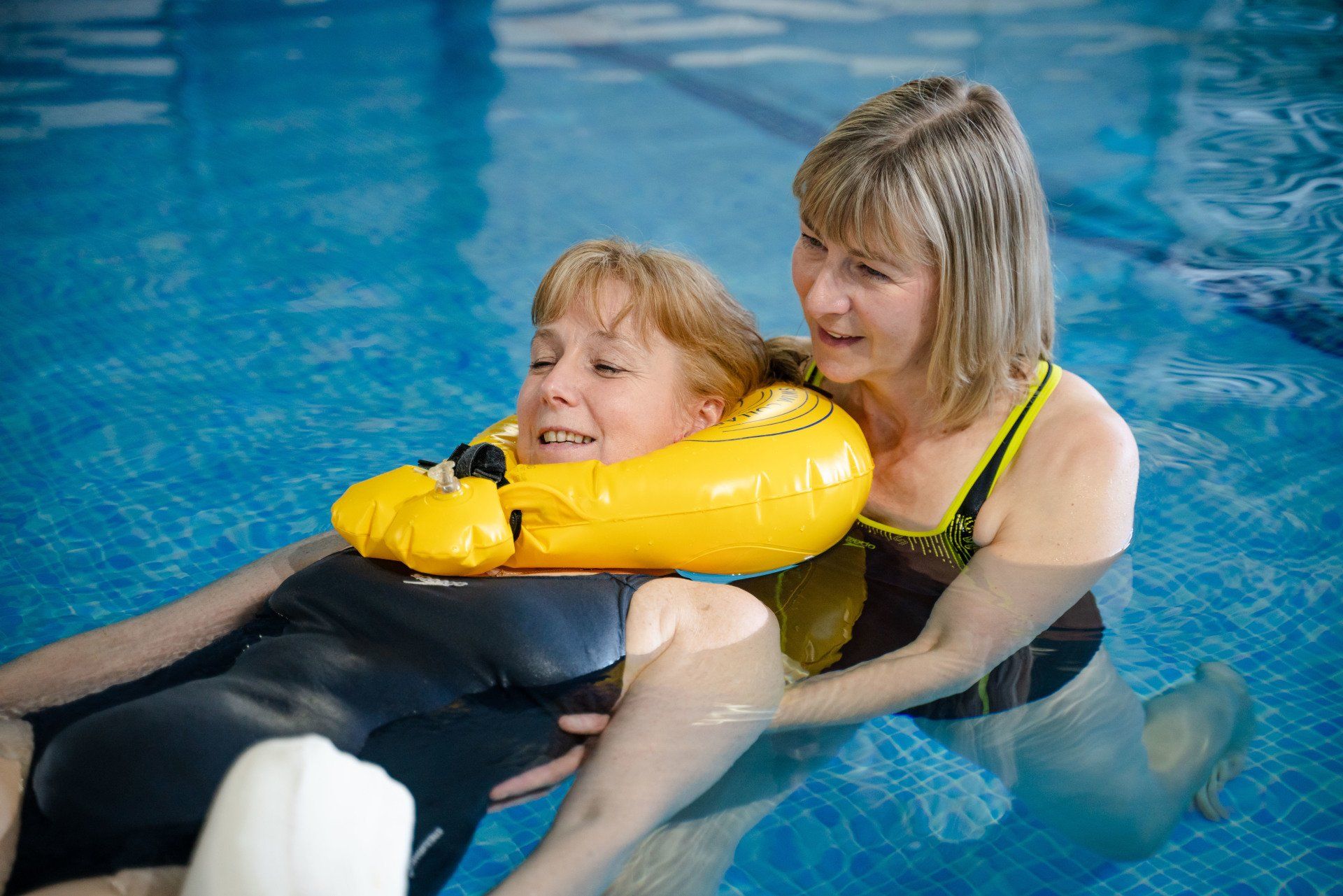
Slide title
Write your caption hereButton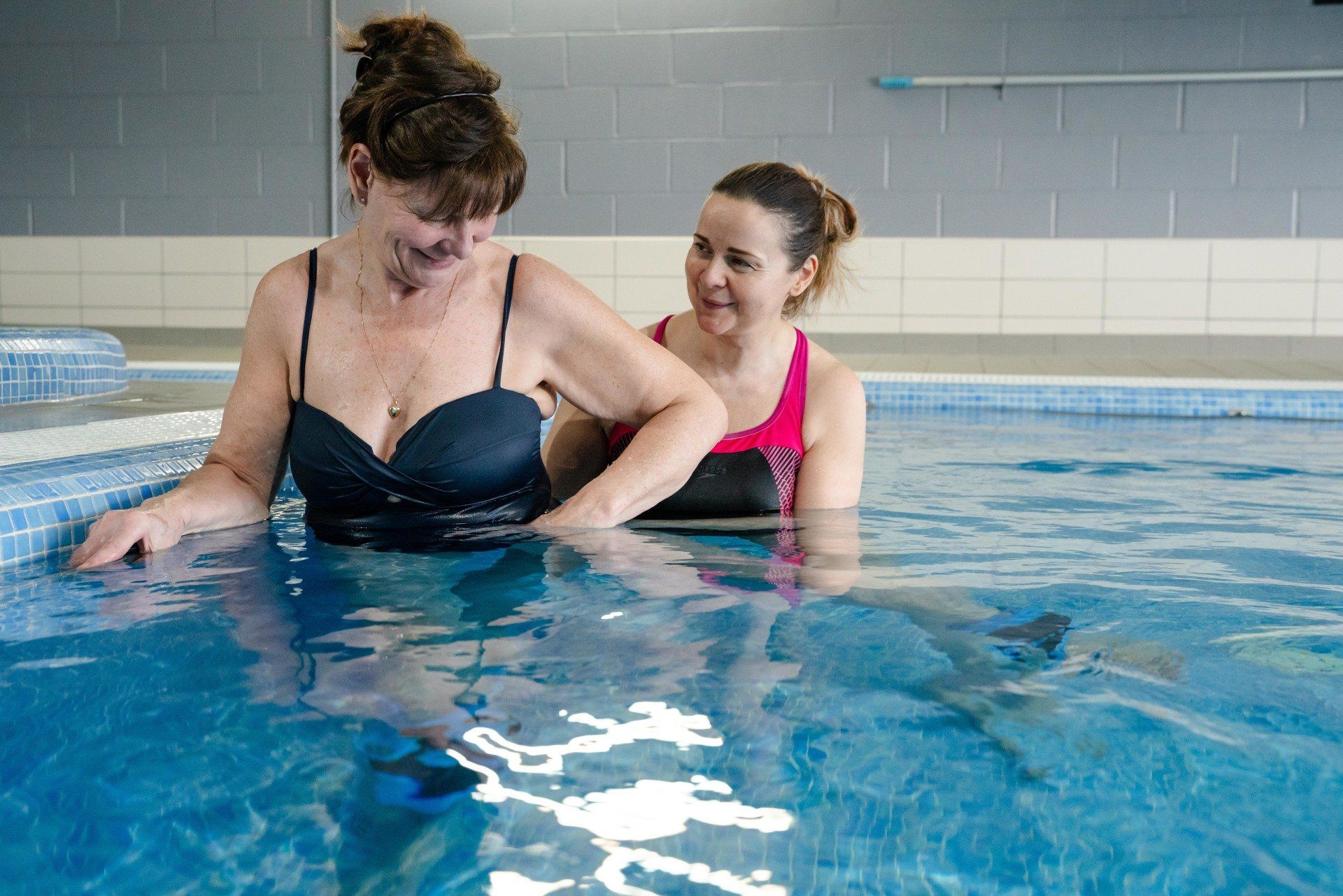
Slide title
Write your caption hereButton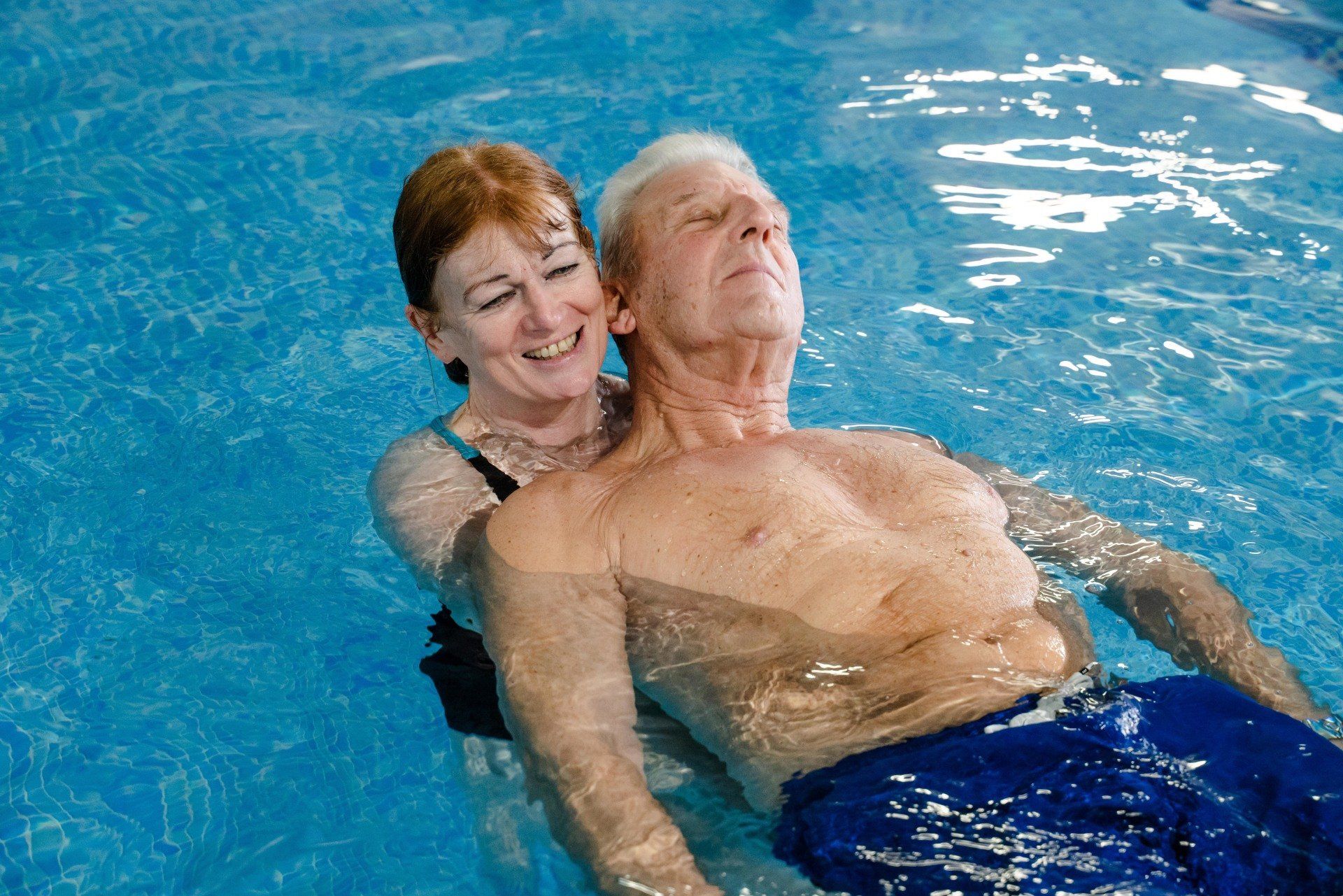
Slide title
Write your caption hereButton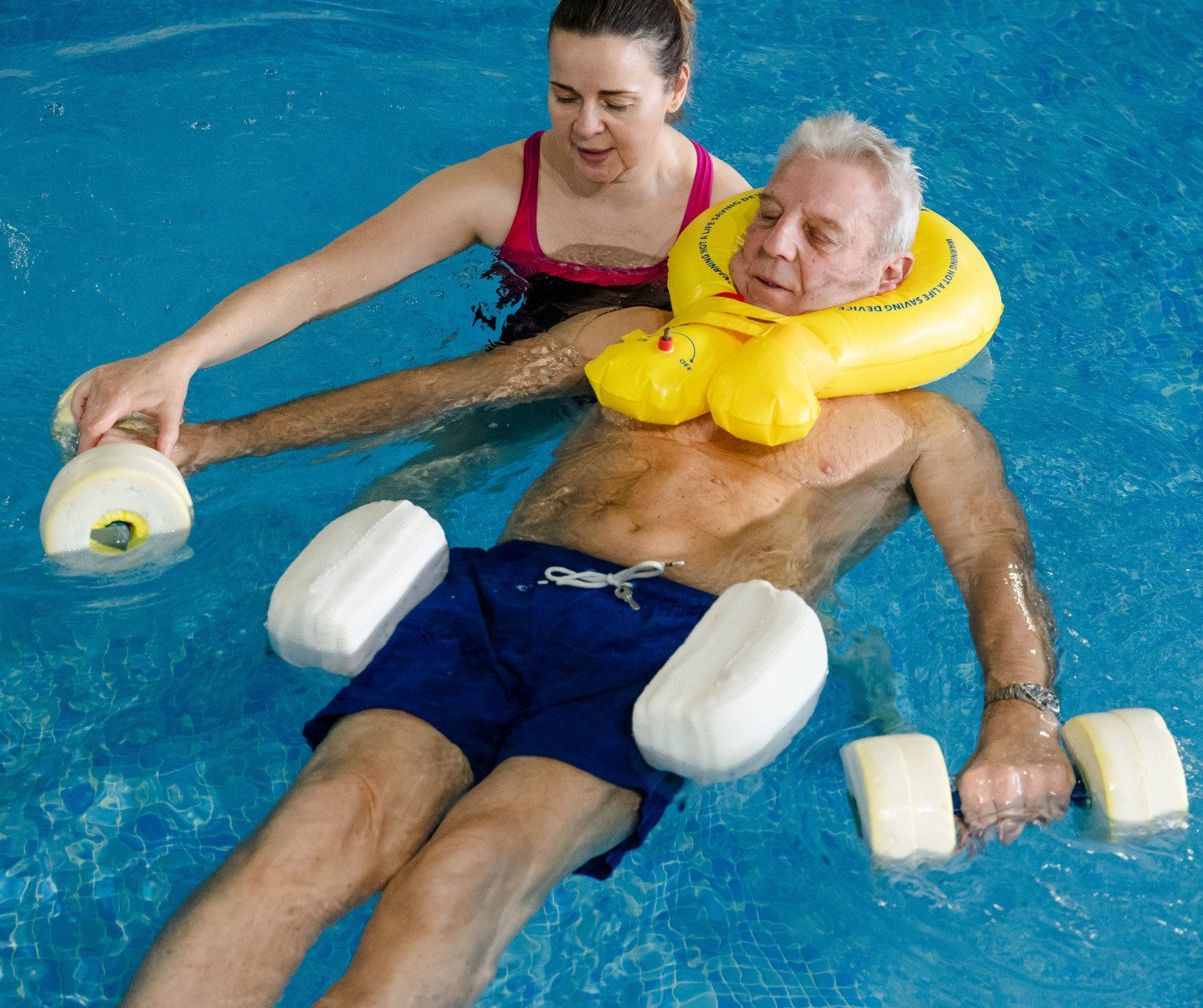
Slide title
Write your caption hereButton
Acute & Chronic Pain
E.g. Back pain, nerve pain, joint and soft tissue pain, muscle aches, crps.
Pain causes much suffering and up to 80% of population will experience pain at some point. Pain has major affect on movement, function and wellbeing and land based activities may well increase pain do due weight bearing loading effect of gravity and effort of muscle work needed to produce.
Hydrotherapy is particularly beneficial:
- Warmth of water induces relaxation to give pain relief.
- Buoyancy offloads joints leading to less pain and so easier movement.
- Supportive environment means you have no worry about falling.
- Resistance of water allows us to strengthen affected joint areas as well as the core to give you control.
- Normal functional movement can be achieved enabling corrective neurological pathways.
- The sympathetic nervous system responsible for ‘Flight or Fright’ is supressed during immersion and so reduces pain.
Acute & Chronic Pain
E.g. Back pain, nerve pain, joint and soft tissue pain, muscle aches, crps.
Pain causes much suffering and up to 80% of population will experience pain at some point. Pain has major affect on movement, function and wellbeing and land based activities may well increase pain do due weight bearing loading effect of gravity and effort of muscle work needed to produce.
Hydrotherapy is particularly beneficial:
- Warmth of water induces relaxation to give pain relief.
- Buoyancy offloads joints leading to less pain and so easier movement.
- Supportive environment means you have no worry about falling.
- Resistance of water allows us to strengthen affected joint areas as well as the core to give you control.
- Normal functional movement can be achieved enabling corrective neurological pathways.
- The sympathetic nervous system responsible for ‘Flight or Fright’ is supressed during immersion and so reduces pain.

Slide title
Write your caption hereButton
Slide title
Write your caption hereButton
Slide title
Write your caption hereButton
Slide title
Write your caption hereButton
Slide title
Write your caption hereButton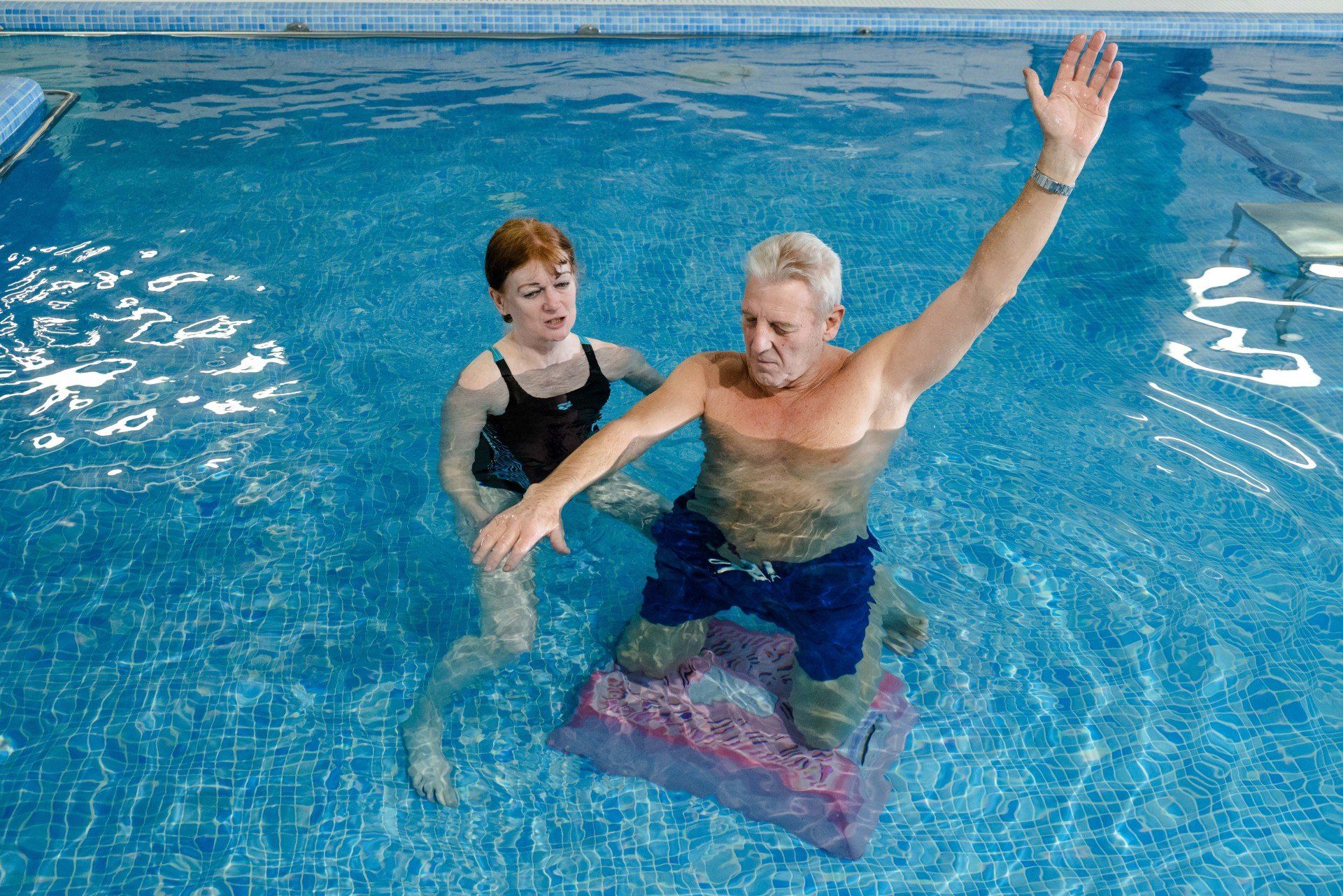
Slide title
Write your caption hereButton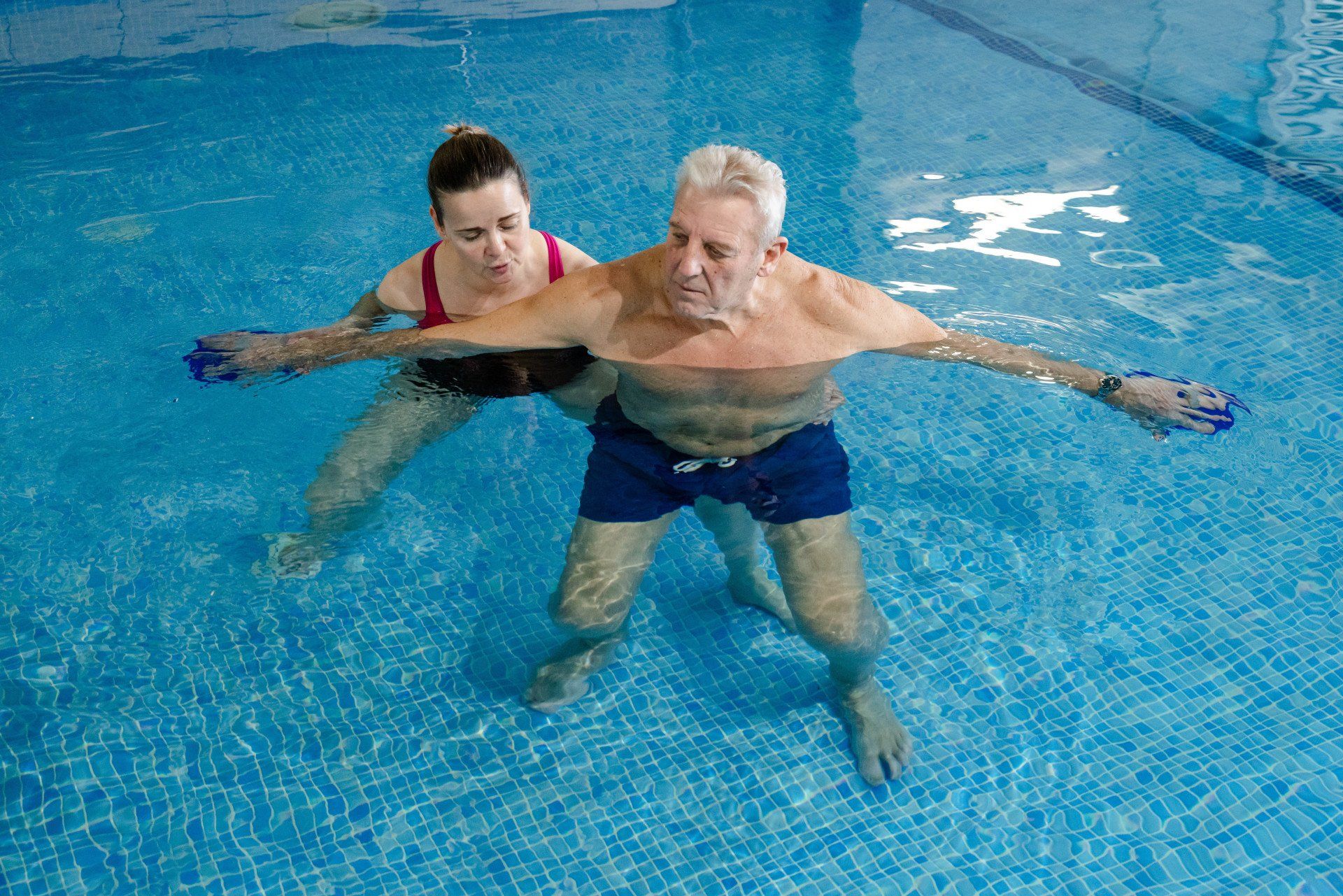
Slide title
Write your caption hereButton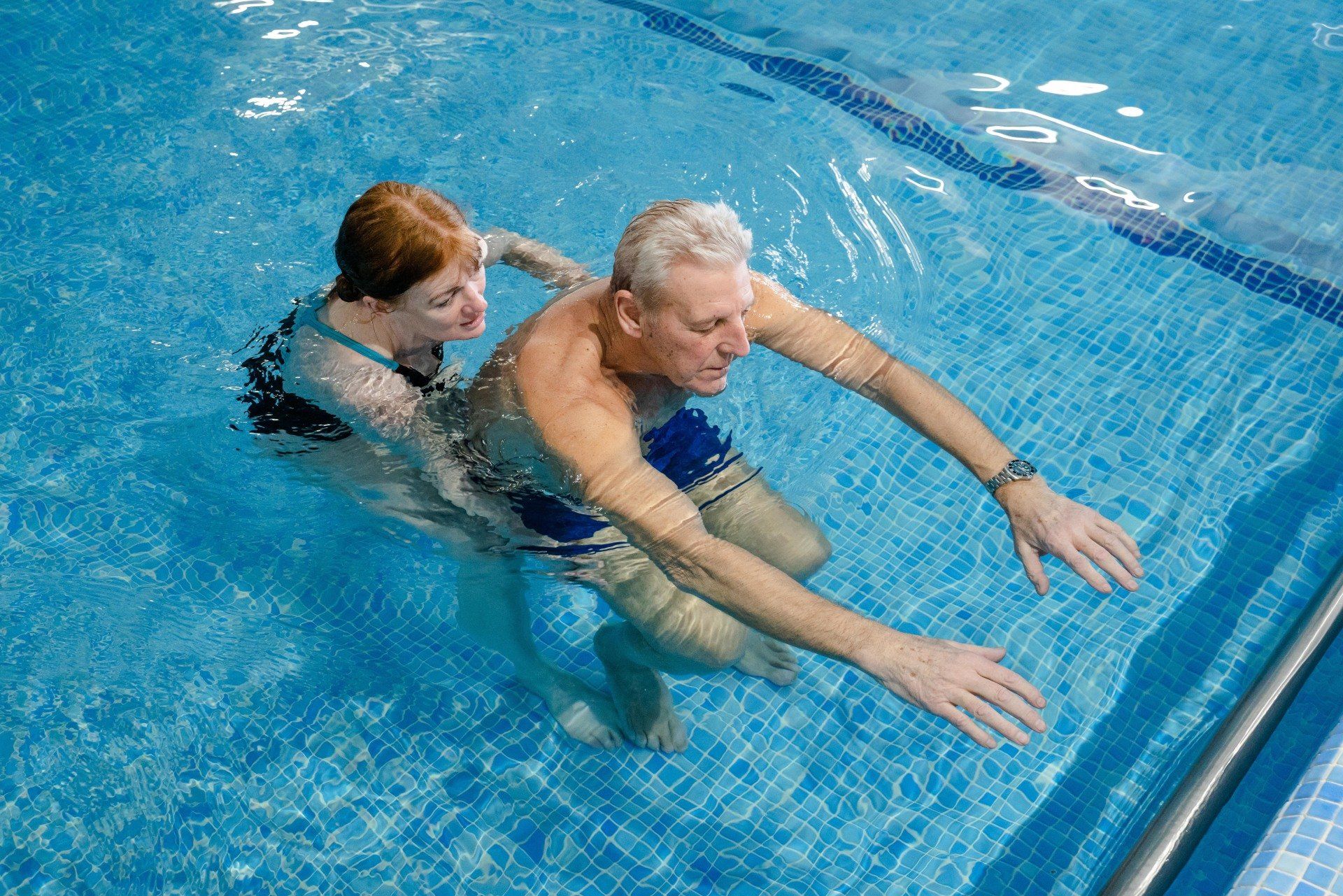
Slide title
Write your caption hereButton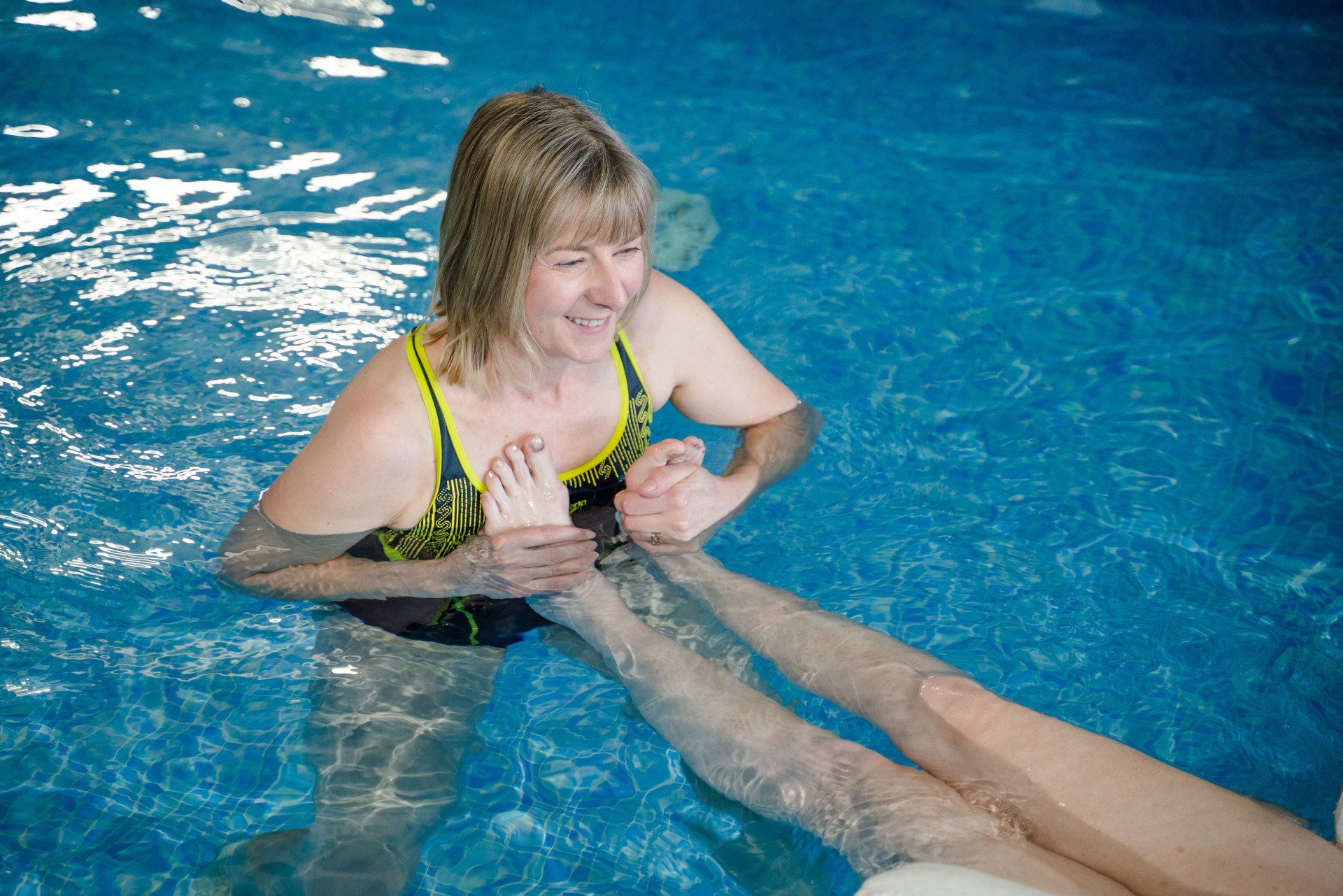
Slide title
Write your caption hereButton
Neurological Disorders
E.g. Parkinsons, Multiple Sclerosis, Cerebral Palsy, Ataxia, Motor Neurone Disease.
Many neurological conditions have alterations in tone in their muscles, flexibility, coordination and balance issues and therefore difficulties functioning on land. They can also have problems with pain and anxiety. In the water handling and mobility is easier for both therapist and patient due to the reduction in gravity.
Hydrotherapy is extremely beneficial:
- The warmth of the water encourages relaxation, reduces pain and anxiety, can reduce spasticity in muscles and enhance feelings of wellbeing.
- The buoyancy it gives assists movements that can otherwise be difficult, sometimes impossible on land e.g. standing up, walking maybe even running and jumping.
- The supportive environment provided can reduce anxiety about falling so that balance can be challenged and improve their and confidence in movement.
- By being immersed in the pool the unique hydrostatic properties of water mean that circulation improves, heart rate and breathing increase so even the most limited in mobility are getting the benefits of exercise just by being in the pool. There are also added benefits of improved kidney function and relief of pressure areas.
- Ease of movement and assistance in initiating movement from the water enables the therapist to be able to achieve more activity in the water than on land.
Neurological Disorders
E.g. Parkinsons, Multiple Sclerosis, Cerebral Palsy, Ataxia, Motor Neurone Disease.
Many neurological conditions have alterations in tone in their muscles, flexibility, coordination and balance issues and therefore difficulties functioning on land. They can also have problems with pain and anxiety. In the water handling and mobility is easier for both therapist and patient due to the reduction in gravity.
Hydrotherapy is extremely beneficial:
- The warmth of the water encourages relaxation, reduces pain and anxiety, can reduce spasticity in muscles and enhance feelings of wellbeing.
- The buoyancy it gives assists movements that can otherwise be difficult, sometimes impossible on land e.g. standing up, walking maybe even running and jumping.
- The supportive environment provided can reduce anxiety about falling so that balance can be challenged and improve their and confidence in movement.
- By being immersed in the pool the unique hydrostatic properties of water mean that circulation improves, heart rate and breathing increase so even the most limited in mobility are getting the benefits of exercise just by being in the pool. There are also added benefits of improved kidney function and relief of pressure areas.
- Ease of movement and assistance in initiating movement from the water enables the therapist to be able to achieve more activity in the water than on land.
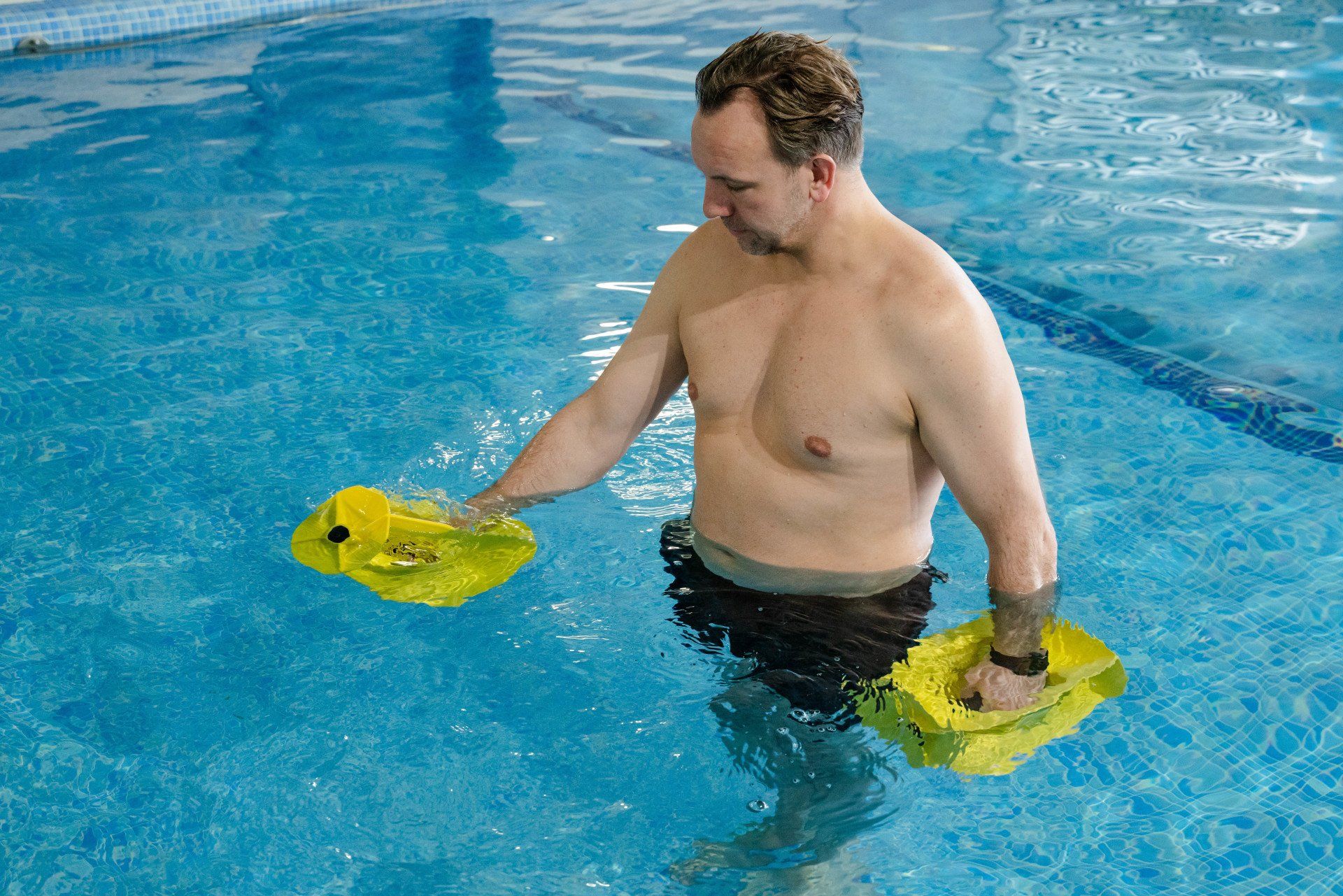
Slide title
Write your caption hereButton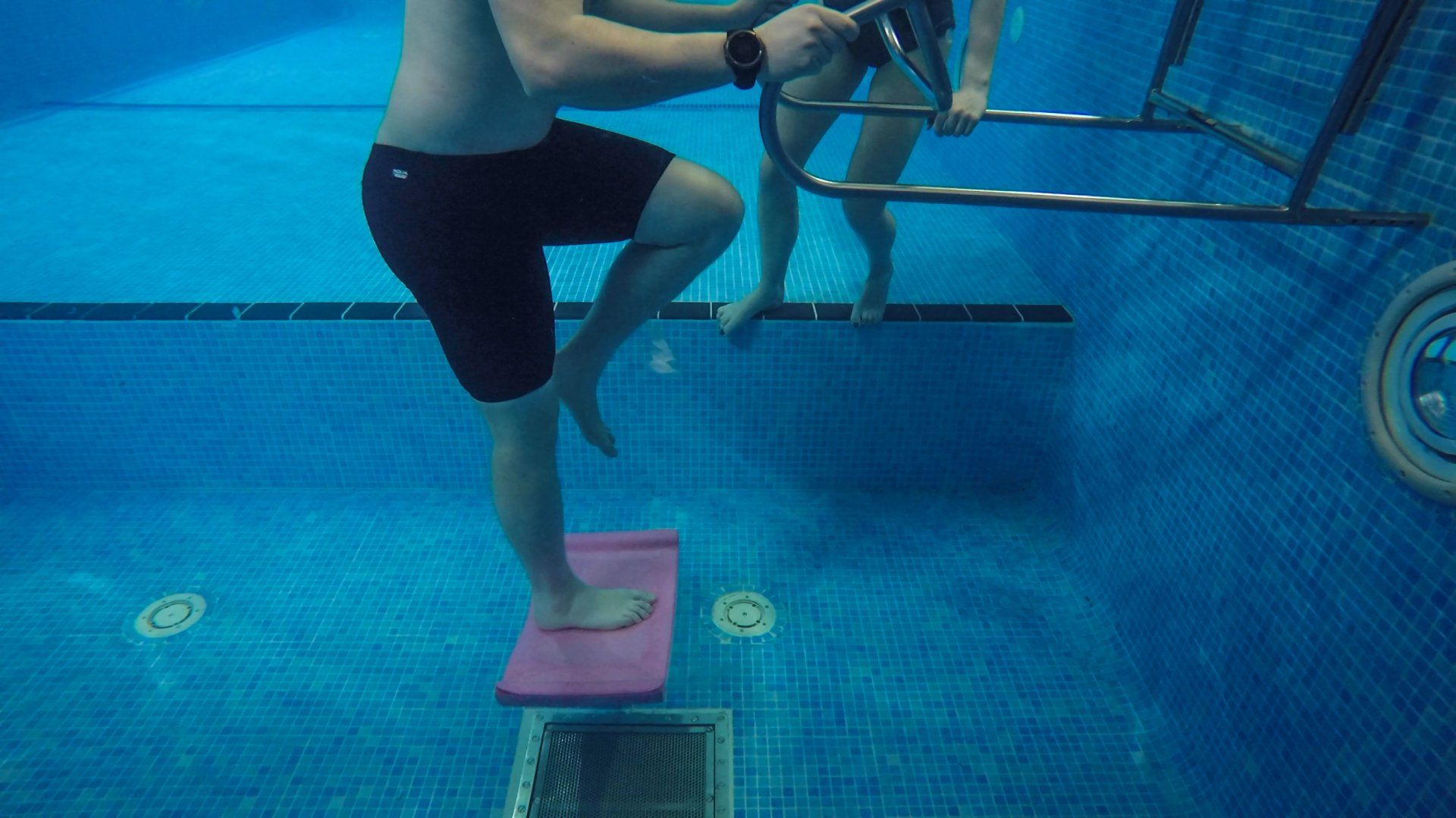
Slide title
Write your caption hereButton
Slide title
Write your caption hereButton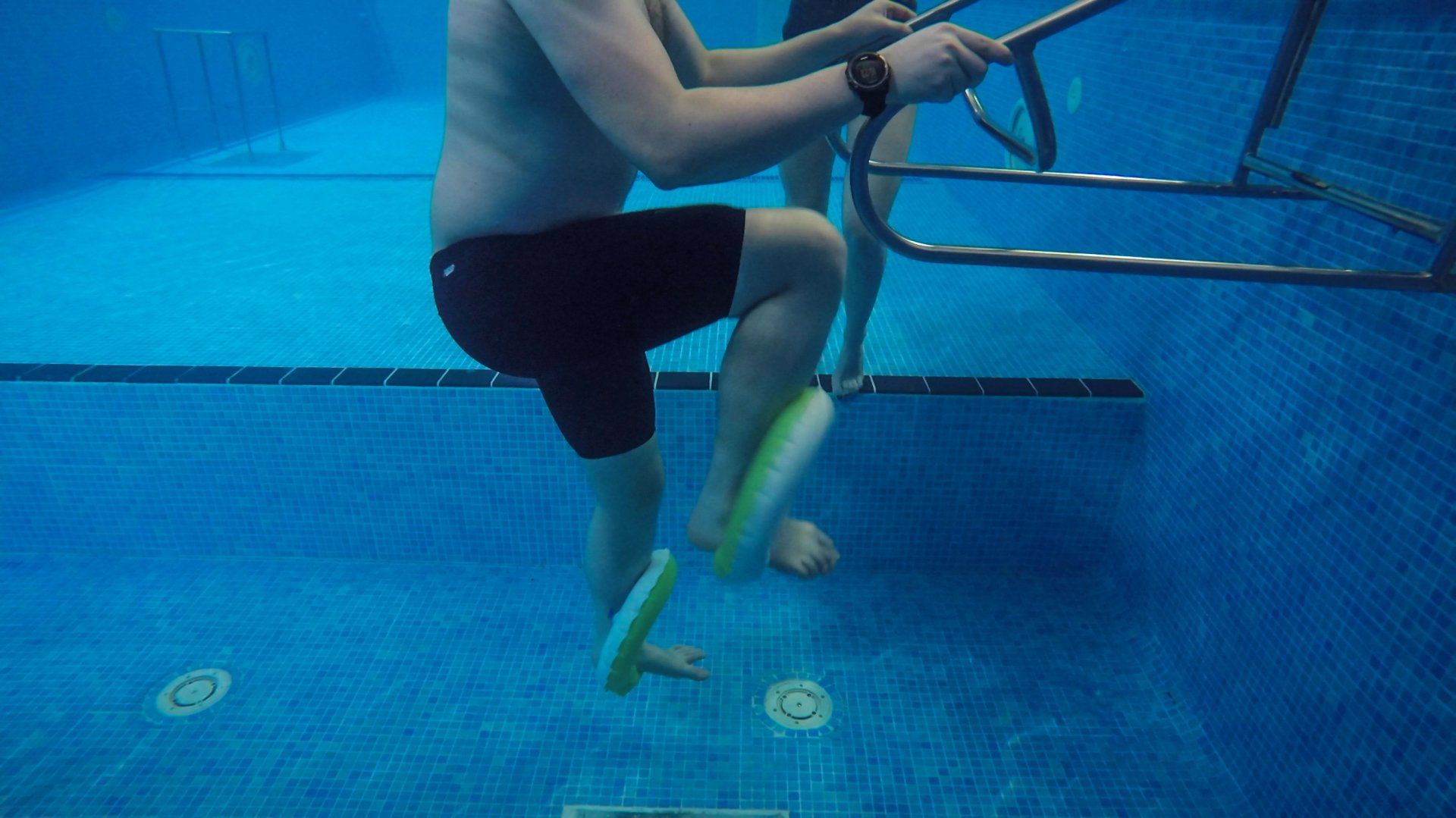
Slide title
Write your caption hereButton
Sports Related Injuries
Whether someone is a solo swimmer or runner for fitness, plays 5-a-side football with friends or is a professional athlete competing at a high level, sports injuries can lead to frustrating periods away from being able to train for and compete in sport. Variation between injuries is huge, but almost all will require a period of rest and inflammation reduction, followed by a period of rehabilitation to get back from the original injury and prevent re-occurrence. Hydrotherapy is a great environment throughout the rehab process and can be used to help regain gentle movement and reduce inflammation in the early painful stages, and then build right through to regaining full power and cardiovascular fitness at end stage rehab.
- Hydrostatic pressure helps to reduce the early stage post-injury inflammation.
- Warmth of water reduces pain, allowing quicker progress to regaining early joint mobility and soft tissue length.
- Buoyancy and drag of water can be used to help to progress quickly to full range of joints and full length of soft tissues.
- Resistance of water can be used to regain strength and power in a step-wise manner, with speed of movement and addition of pool equipment offering many levels of progression.
- Core stability can be tested and challenged in a wide variety of ways, maintaining control during the period of injury and even building better.
- Core stability than an individual had pre-injury.
Sports Related Injuries
Whether someone is a solo swimmer or runner for fitness, plays 5-a-side football with friends or is a professional athlete competing at a high level, sports injuries can lead to frustrating periods away from being able to train for and compete in sport. Variation between injuries is huge, but almost all will require a period of rest and inflammation reduction, followed by a period of rehabilitation to get back from the original injury and prevent re-occurrence. Hydrotherapy is a great environment throughout the rehab process and can be used to help regain gentle movement and reduce inflammation in the early painful stages, and then build right through to regaining full power and cardiovascular fitness at end stage rehab.
- Hydrostatic pressure helps to reduce the early stage post-injury inflammation.
- Warmth of water reduces pain, allowing quicker progress to regaining early joint mobility and soft tissue length.
- Buoyancy and drag of water can be used to help to progress quickly to full range of joints and full length of soft tissues.
- Resistance of water can be used to regain strength and power in a step-wise manner, with speed of movement and addition of pool equipment offering many levels of progression.
- Core stability can be tested and challenged in a wide variety of ways, maintaining control during the period of injury and even building better.
- Core stability than an individual had pre-injury.

Slide title
Write your caption hereButton
Slide title
Write your caption hereButton
Slide title
Write your caption hereButton
Slide title
Write your caption hereButton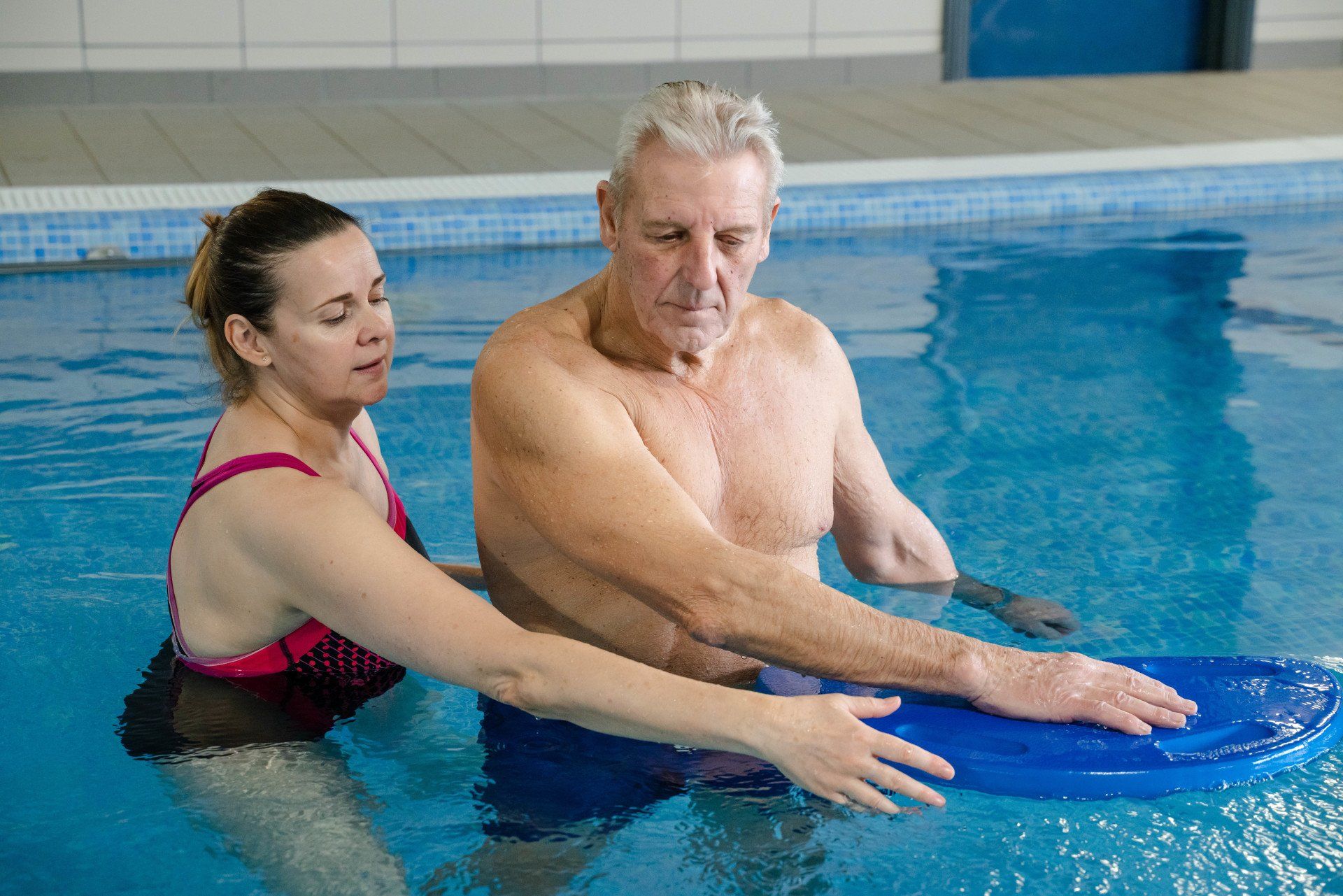
Slide title
Write your caption hereButton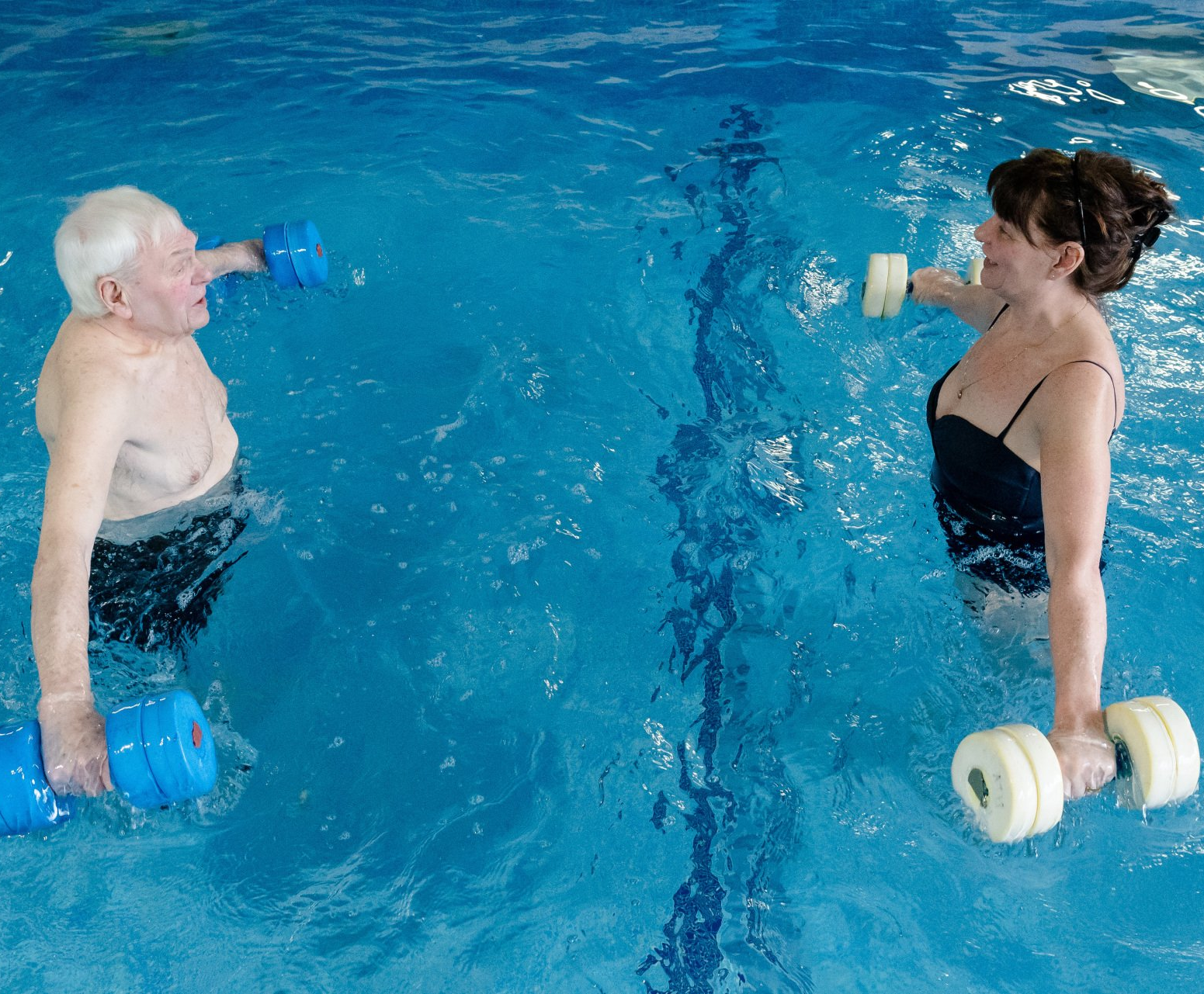
Slide title
Write your caption hereButton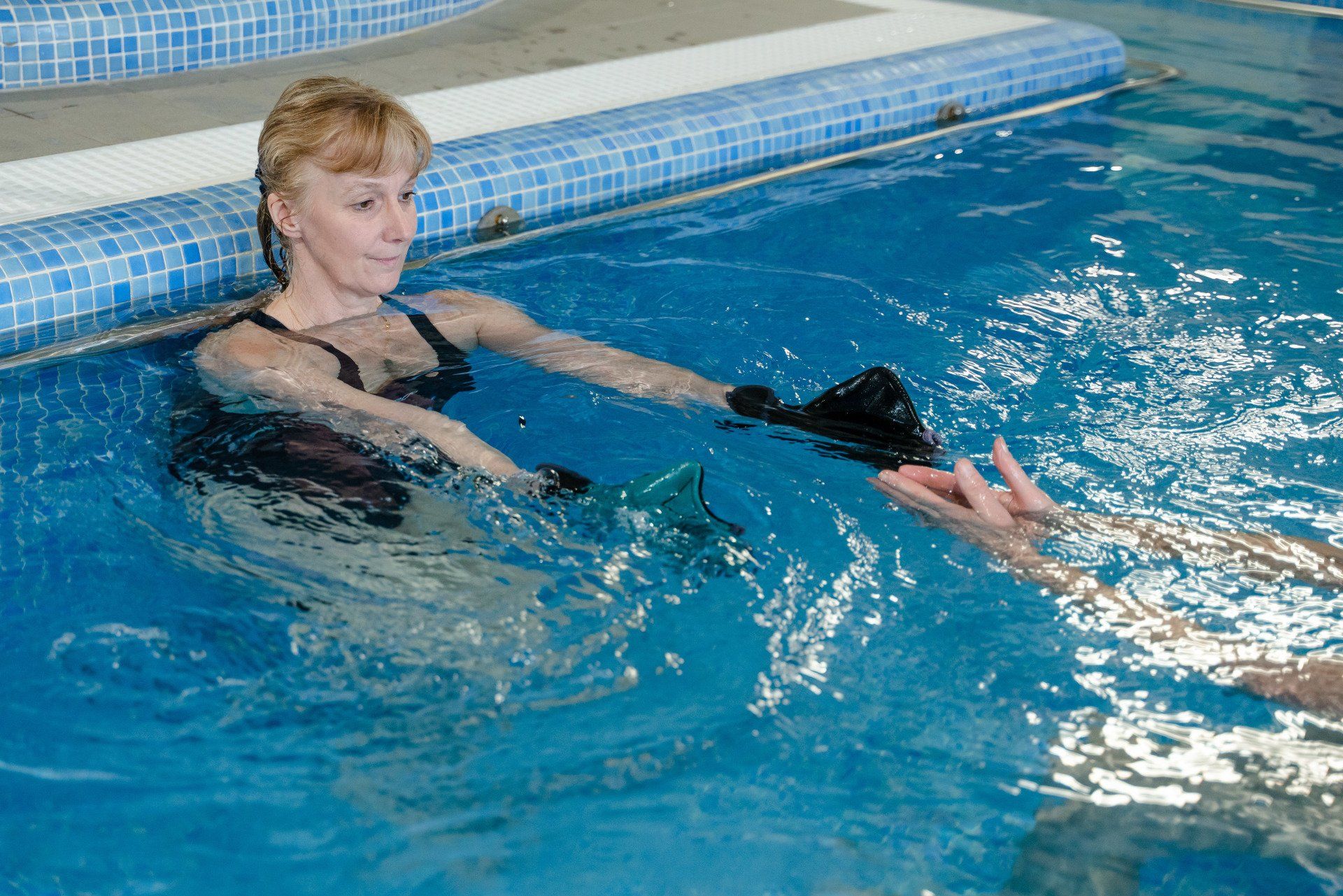
Slide title
Write your caption hereButton
Slide title
Write your caption hereButton
Osteoporosis & Arthritis
Ospteoporosis is a reduction in bone density affecting women more than men, generally developing over several years and often diagnosed after a fall with a fracture occurring either spine wrist or hip causing considerable pain. Bone density scans diagnose the condition and an exercise programme alongside diet and medication should be followed.
- Although water is seen as reduced weightbearing, the support and resistance provided by the water enables strengthening and stabilising exercises to be done promoting muscle pull on bone and so improving bone density.
- Buoyancy support from the water means there is no risk of falling.
- Pain is reduced in the water allowing movement as well as core stability improvement which offers spinal support.
Arthritis is inflammation in joints and is often aggravated by weightbearing. This leads to more pain and more dysfunction and so the cycle continues. The buoyancy from the water offloads the joints and so allows movement and strengthening to be done as well as stretches and functional movement in a pain free way.
- Warmth of water promotes relaxation, which along with buoyancy support provides pain relief.
- Graded resistance can be used to improve strength and joint support.
- Normal pain free functional movements can be achieved maintaining muscle balance and daily activities.
- Localised mobilising and stretching can target specific problem areas as well as a whole body approach to maintain posture and alignment.
Osteoporosis & Arthritis
Ospteoporosis is a reduction in bone density affecting women more than men, generally developing over several years and often diagnosed after a fall with a fracture occurring either spine wrist or hip causing considerable pain. Bone density scans diagnose the condition and an exercise programme alongside diet and medication should be followed.
- Although water is seen as reduced weightbearing, the support and resistance provided by the water enables strengthening and stabilising exercises to be done promoting muscle pull on bone and so improving bone density.
- Buoyancy support from the water means there is no risk of falling.
- Pain is reduced in the water allowing movement as well as core stability improvement which offers spinal support.
Arthritis is inflammation in joints and is often aggravated by weightbearing. This leads to more pain and more dysfunction and so the cycle continues. The buoyancy from the water offloads the joints and so allows movement and strengthening to be done as well as stretches and functional movement in a pain free way.
- Warmth of water promotes relaxation, which along with buoyancy support provides pain relief.
- Graded resistance can be used to improve strength and joint support.
- Normal pain free functional movements can be achieved maintaining muscle balance and daily activities.
- Localised mobilising and stretching can target specific problem areas as well as a whole body approach to maintain posture and alignment.

Slide title
Write your caption hereButton
Slide title
Write your caption hereButton
Slide title
Write your caption hereButton
Slide title
Write your caption hereButton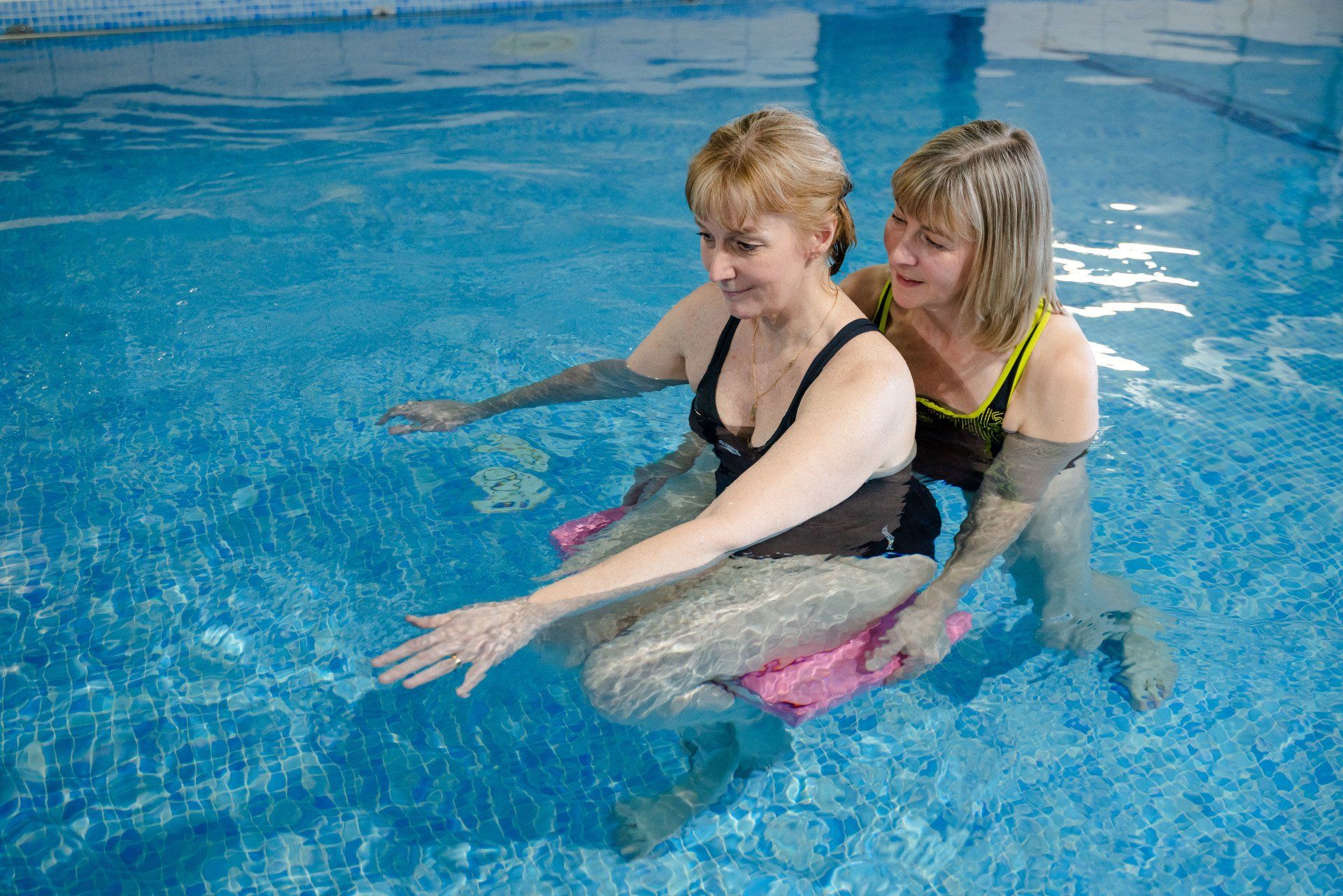
Slide title
Write your caption hereButton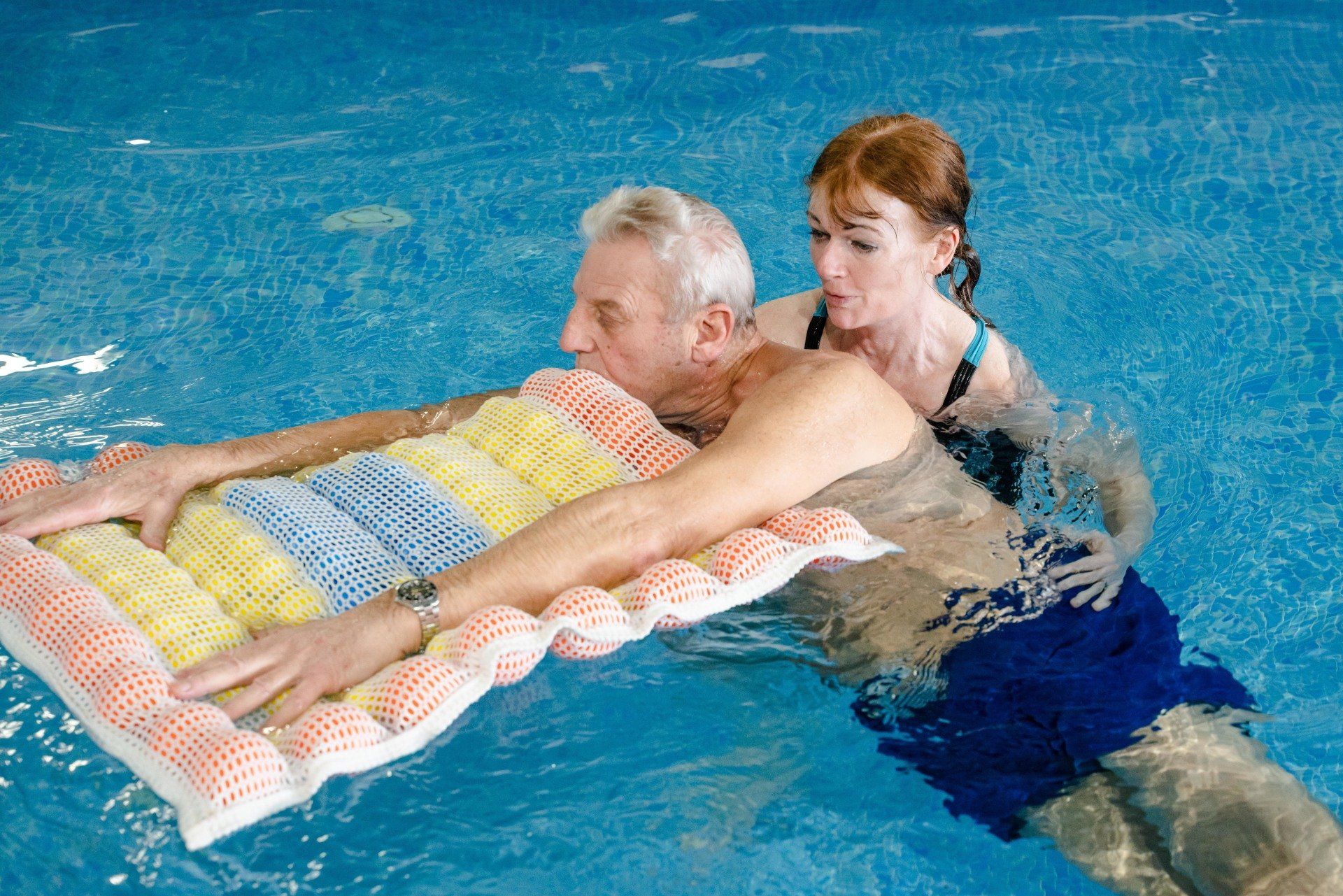
Slide title
Write your caption hereButton
Slide title
Write your caption hereButton
Spinal Cord Injury (SCI) & Peripheral Nerve Injury (PNI)
Damage to the spinal cord can cause temporary or permanent changes. The spinal cord is responsible for sending messages from the brain to all parts of the body. It also sends messages from the body to the brain. These messages help us to move our body, feel pressure and control vital functions like breathing, blood pressure, bladder and bowels. If the spinal cord sustains an injury, some or all of these messages between our brain and the rest of our body may be disrupted. The result is loss of movement and sensation from below the level of injury. Possible causes of SCI may include: trauma, disease, degeneration or blood clots in the blood supply to the spinal cord . Symptoms of spinal cord injury depend on the severity of injury and it’s location on the spinal cord.
Peripheral Nerve Injuries (PNIs)
include a variety of conditions in which one or more peripheral nerves (the links between your brain and spinal cord and the rest of your body) are damaged, leading to neurological deficits distal to the level of the lesion. Possible causes include systemic or metabolic problems (e.g. diabetes, autoimmune disease) and localised damage (e.g. as a result of trauma, compression, tumours infections and exposure to toxins)
PNIs may occur as isolated neurological conditions or more commonly, in association with soft tissue, vascular and/or skeletal damage.
Hydrotherapy is a valuable treatment:
- Warmth of the water effectively relieves pain through normalising muscle tone, promoting muscle relaxation and decreasing joint stiffness; in turn increased movement and more optimal movement patterns are achieved.
- The buoyancy of water can facilitate passive stretching, which helps to maintain muscle extensibility & joint range of motion.
- Water can provide resistance against which weak muscles can be strengthened, enhancing motor recovery of the involved limb(s) and core.
- The buoyancy of water allows the patient with restricted mobility on land to move more freely in the water & it provides a safe environment in which to practice balance, walking and stepping.
- Circulation is stimulated by exercising in the water; the hydrostatic pressure assists in lymphatic and venous blood flow, which in turn enhances cardiac functions and venous returns along with promoting body detoxification, aiding a reduction of swelling.
- Rehabilitating in the water improves people’s self-confidence, sense of wellbeing and relaxes them.
Spinal Cord Injury (SCI) & Peripheral Nerve Injury (PNI)
Damage to the spinal cord can cause temporary or permanent changes. The spinal cord is responsible for sending messages from the brain to all parts of the body. It also sends messages from the body to the brain. These messages help us to move our body, feel pressure and control vital functions like breathing, blood pressure, bladder and bowels. If the spinal cord sustains an injury, some or all of these messages between our brain and the rest of our body may be disrupted. The result is loss of movement and sensation from below the level of injury. Possible causes of SCI may include: trauma, disease, degeneration or blood clots in the blood supply to the spinal cord . Symptoms of spinal cord injury depend on the severity of injury and it’s location on the spinal cord.
Peripheral Nerve Injuries (PNIs)
include a variety of conditions in which one or more peripheral nerves (the links between your brain and spinal cord and the rest of your body) are damaged, leading to neurological deficits distal to the level of the lesion. Possible causes include systemic or metabolic problems (e.g. diabetes, autoimmune disease) and localised damage (e.g. as a result of trauma, compression, tumours infections and exposure to toxins)
PNIs may occur as isolated neurological conditions or more commonly, in association with soft tissue, vascular and/or skeletal damage.
Hydrotherapy is a valuable treatment:
- Warmth of the water effectively relieves pain through normalising muscle tone, promoting muscle relaxation and decreasing joint stiffness; in turn increased movement and more optimal movement patterns are achieved.
- The buoyancy of water can facilitate passive stretching, which helps to maintain muscle extensibility & joint range of motion.
- Water can provide resistance against which weak muscles can be strengthened, enhancing motor recovery of the involved limb(s) and core.
- The buoyancy of water allows the patient with restricted mobility on land to move more freely in the water & it provides a safe environment in which to practice balance, walking and stepping.
- Circulation is stimulated by exercising in the water; the hydrostatic pressure assists in lymphatic and venous blood flow, which in turn enhances cardiac functions and venous returns along with promoting body detoxification, aiding a reduction of swelling.
- Rehabilitating in the water improves people’s self-confidence, sense of wellbeing and relaxes them.

Slide title
Write your caption hereButton
Slide title
Write your caption hereButton
Slide title
Write your caption hereButton
Slide title
Write your caption hereButton
Slide title
Write your caption hereButton
Slide title
Write your caption hereButton
Slide title
Write your caption hereButton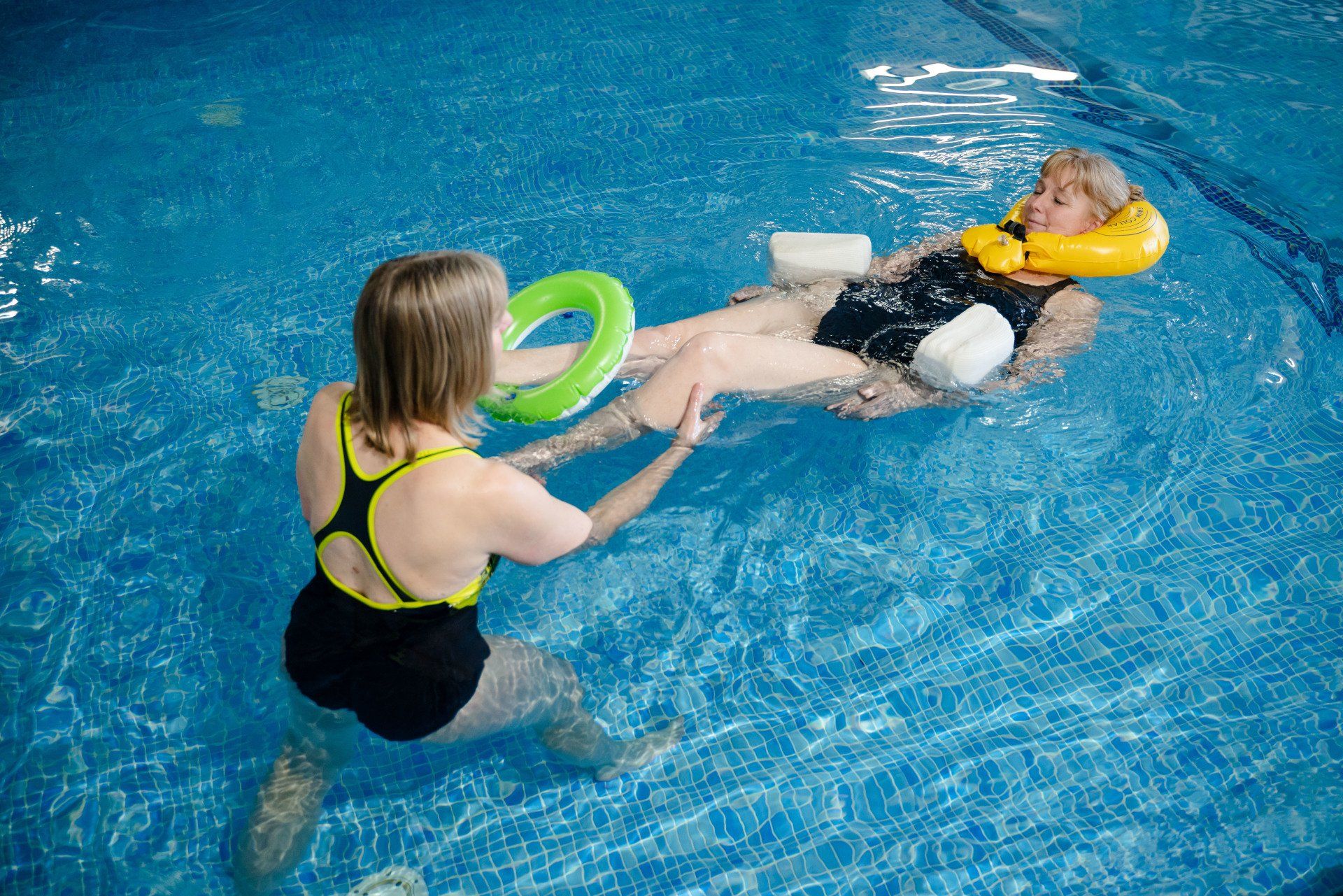
Slide title
Write your caption hereButton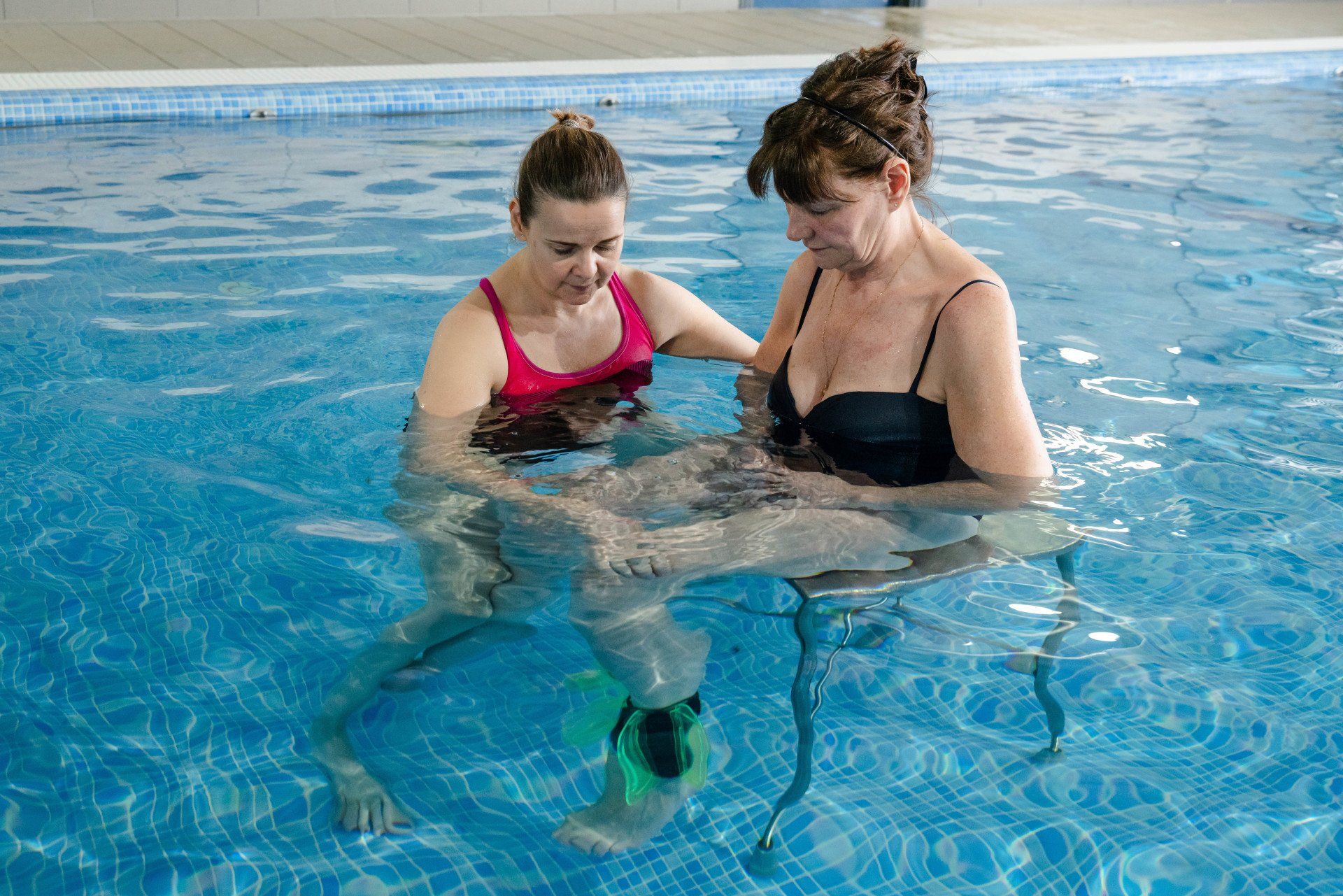
Slide title
Write your caption hereButton
Fibromyalgia
Causes widespread pain and tenderness all over the body and extreme tiredness with symptoms varying from person to person.
Finding a way to help patients feel more in control of their body rather than letting the condition control them is the key to managing life with fibromyalgia.
Research shows that the most effective treatment for fibromyalgia is physical exercise.
Hydrotherapy allows exercise in a supportive and relaxing environment enabling movements and functions that on land cause extreme pain and discomfort to be carried out.
- Warmth of water promotes relaxation, which along with buoyancy support can provide pain relief.
- Graded resistance can be used to improve exercise tolerance and control fatigue.
- Normal pain free functional movements can be achieved and provide a huge boost to mental wellbeing.
- Localised mobilising and stretching can alter joint dysfunction and muscle imbalances.
Fibromyalgia
Causes widespread pain and tenderness all over the body and extreme tiredness with symptoms varying from person to person.
Finding a way to help patients feel more in control of their body rather than letting the condition control them is the key to managing life with fibromyalgia.
Research shows that the most effective treatment for fibromyalgia is physical exercise.
Hydrotherapy allows exercise in a supportive and relaxing environment enabling movements and functions that on land cause extreme pain and discomfort to be carried out.
- Warmth of water promotes relaxation, which along with buoyancy support can provide pain relief.
- Graded resistance can be used to improve exercise tolerance and control fatigue.
- Normal pain free functional movements can be achieved and provide a huge boost to mental wellbeing.
- Localised mobilising and stretching can alter joint dysfunction and muscle imbalances.

Slide title
Write your caption hereButton
Slide title
Write your caption hereButton
Slide title
Write your caption hereButton
Slide title
Write your caption hereButton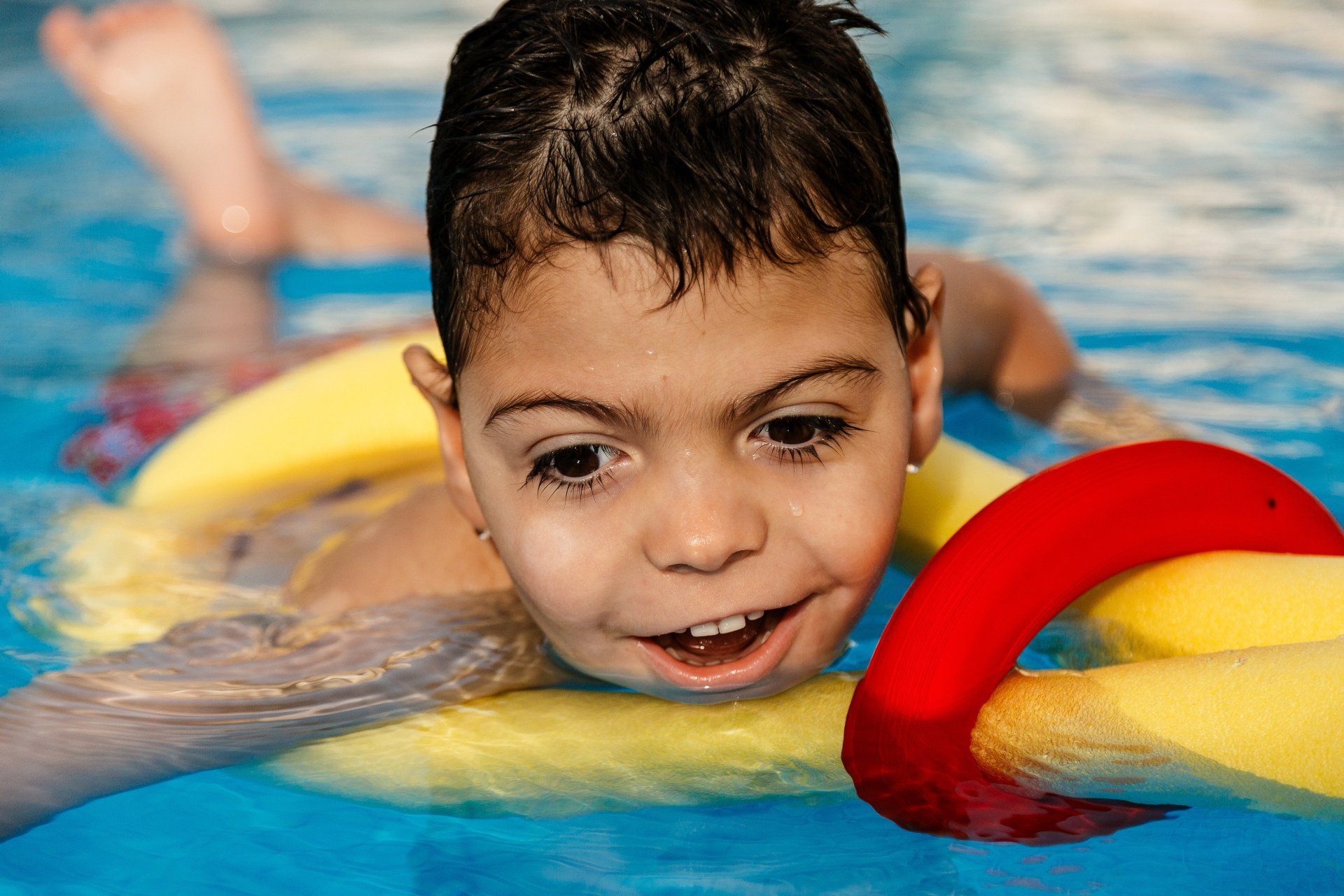
Slide title
Write your caption hereButton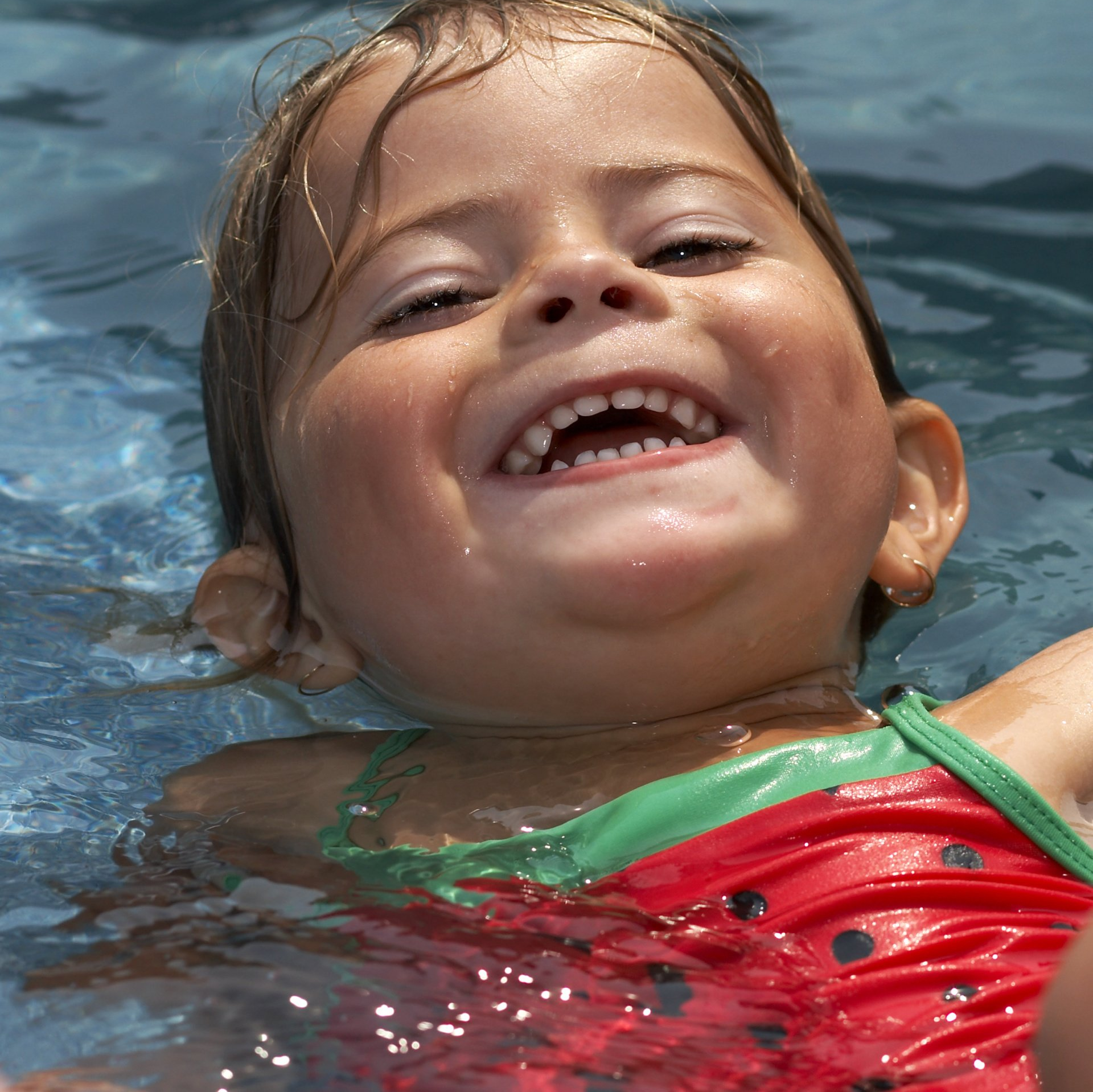
Slide title
Write your caption hereButton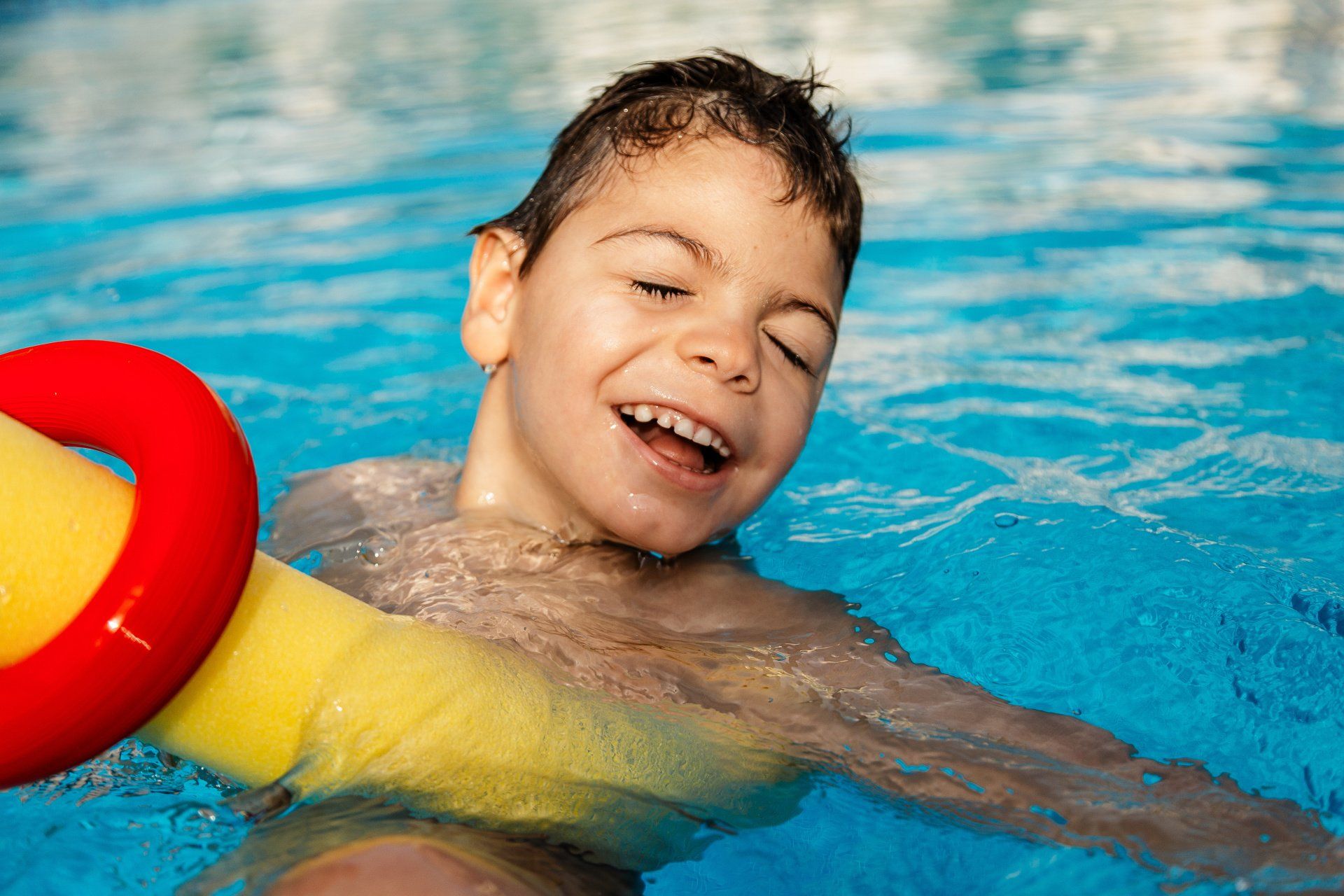
Slide title
Write your caption hereButton
Paediatric Disorders
This covers a huge variety of conditions:
E.g. neurodevelopmental delay, cerebral palsy, developmental co-ordination difficulties and dyspraxia, cerebral tumours, children with learning or behavioural difficulties, downs syndrome, genetic disorders, congenital skeletal disorders, congenital hip dislocation, scoliosis, ehlers danlos syndrome, spina bifida & childhood rheumatic diseases.
Water is a fun environment for children and one in which they can become able rather than disabled. They can take their body weight independently without the need for walking aids and move where they want to. In the younger children treatment is seen as great fun whilst working hard without realising it.
Benefits of hydro:
- Normalisation of abnormal postural tone through therapeutic warmth of the water.
- Relief of pain and muscle spasm.
- Improve and maintain joint range of motion.
- Improve and maintain muscle strength.
- Improve balance and co-ordination.
- Strengthen core stability and posture.
- Reduce pressure on load bearing joints therefore facilitating early rehabilitation of post-operative and traumatic Orthopaedic, Neurological patients.
Paediatric Disorders
This covers a huge variety of conditions:
E.g. neurodevelopmental delay, cerebral palsy, developmental co-ordination difficulties and dyspraxia, cerebral tumours, children with learning or behavioural difficulties, downs syndrome, genetic disorders, congenital skeletal disorders, congenital hip dislocation, scoliosis, ehlers danlos syndrome, spina bifida & childhood rheumatic diseases.
Water is a fun environment for children and one in which they can become able rather than disabled. They can take their body weight independently without the need for walking aids and move where they want to. In the younger children treatment is seen as great fun whilst working hard without realising it.
Benefits of hydro:
- Normalisation of abnormal postural tone through therapeutic warmth of the water.
- Relief of pain and muscle spasm.
- Improve and maintain joint range of motion.
- Improve and maintain muscle strength.
- Improve balance and co-ordination.
- Strengthen core stability and posture.
- Reduce pressure on load bearing joints therefore facilitating early rehabilitation of post-operative and traumatic Orthopaedic, Neurological patients.

Slide title
Write your caption hereButton
Slide title
Write your caption hereButton
Slide title
Write your caption hereButton
Slide title
Write your caption hereButton
Slide title
Write your caption hereButton
Slide title
Write your caption hereButton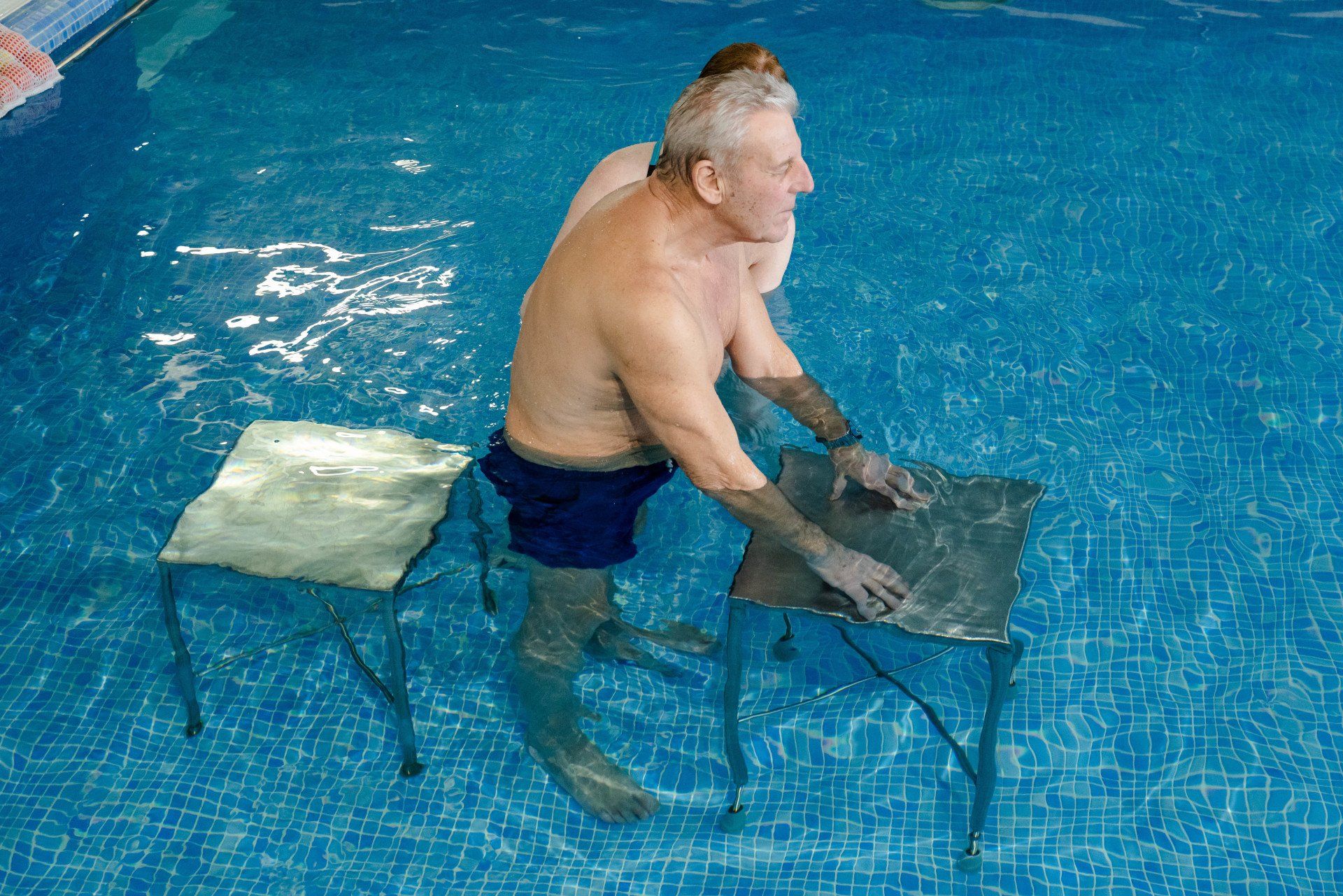
Slide title
Write your caption hereButton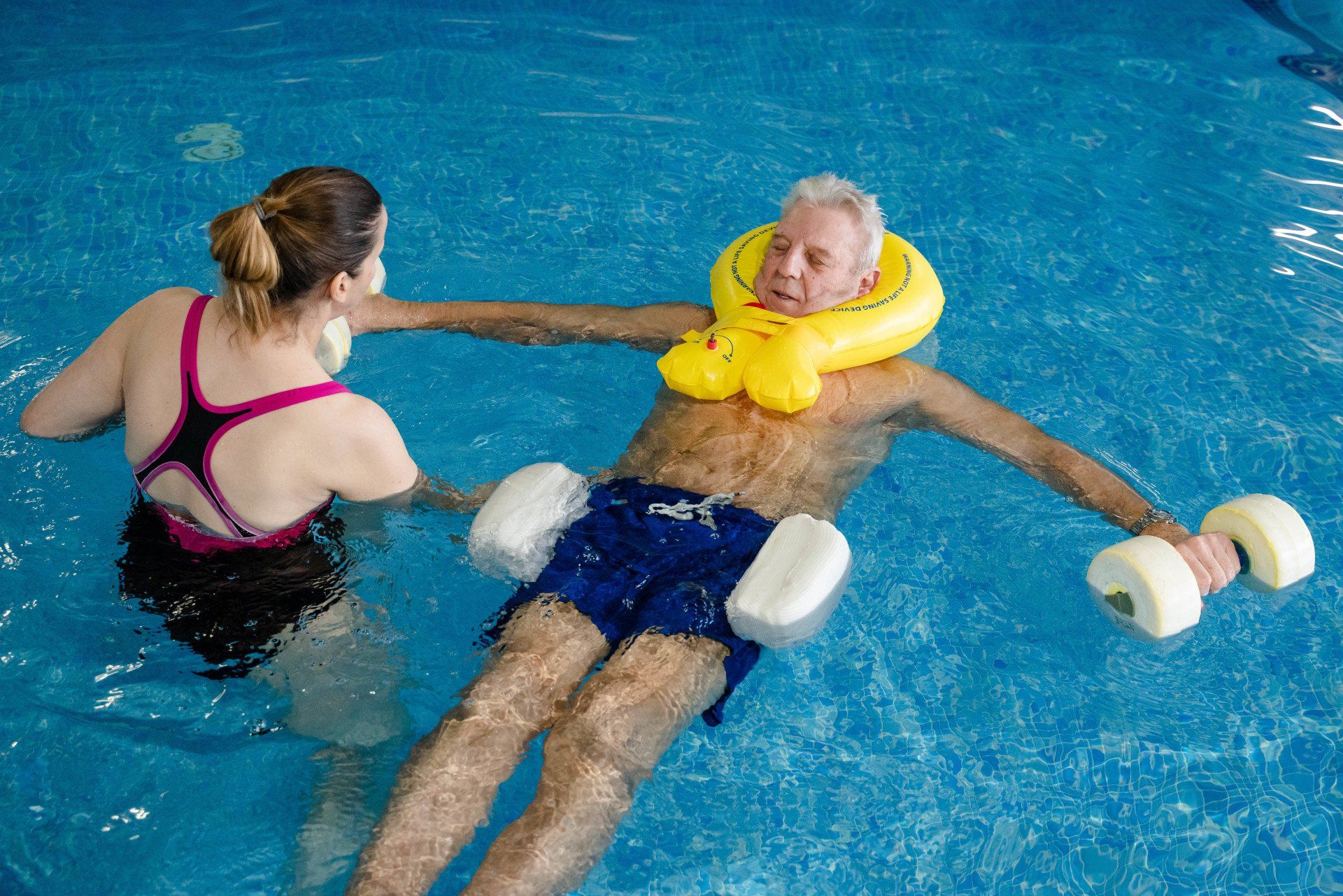
Slide title
Write your caption hereButton
Dementia & Alzheimers
There may be issues with understanding, as well as movement and balance problems. Fear and anxiety can lead to reduced and limited movement being initiated and produced on land.
Hydrotherapy can help:
- The warmth of the water encourages relaxation and reduces anxiety and gives an enhanced feeling of wellbeing and enjoyment even if understanding is limited.
- The buoyancy assists movement that can otherwise be difficult, sometimes impossible, on land e.g. standing up and walking.
- The supportive environment can reduce worries about falling so that balance can be challenged and confidence in movement gained.
- The resistance of water allows us to build up strength and many muscle groups as well as core muscles can be worked at the same time.
- Mental alertness occurs probably due to increase in circulation to the brain, so often smiles and conversation are a result of the session.
Dementia & Alzheimers
There may be issues with understanding, as well as movement and balance problems. Fear and anxiety can lead to reduced and limited movement being initiated and produced on land.
Hydrotherapy can help:
- The warmth of the water encourages relaxation and reduces anxiety and gives an enhanced feeling of wellbeing and enjoyment even if understanding is limited.
- The buoyancy assists movement that can otherwise be difficult, sometimes impossible, on land e.g. standing up and walking.
- The supportive environment can reduce worries about falling so that balance can be challenged and confidence in movement gained.
- The resistance of water allows us to build up strength and many muscle groups as well as core muscles can be worked at the same time.
- Mental alertness occurs probably due to increase in circulation to the brain, so often smiles and conversation are a result of the session.

Slide title
Write your caption hereButton
Slide title
Write your caption hereButton
Slide title
Write your caption hereButton
Slide title
Write your caption hereButton
Slide title
Write your caption hereButton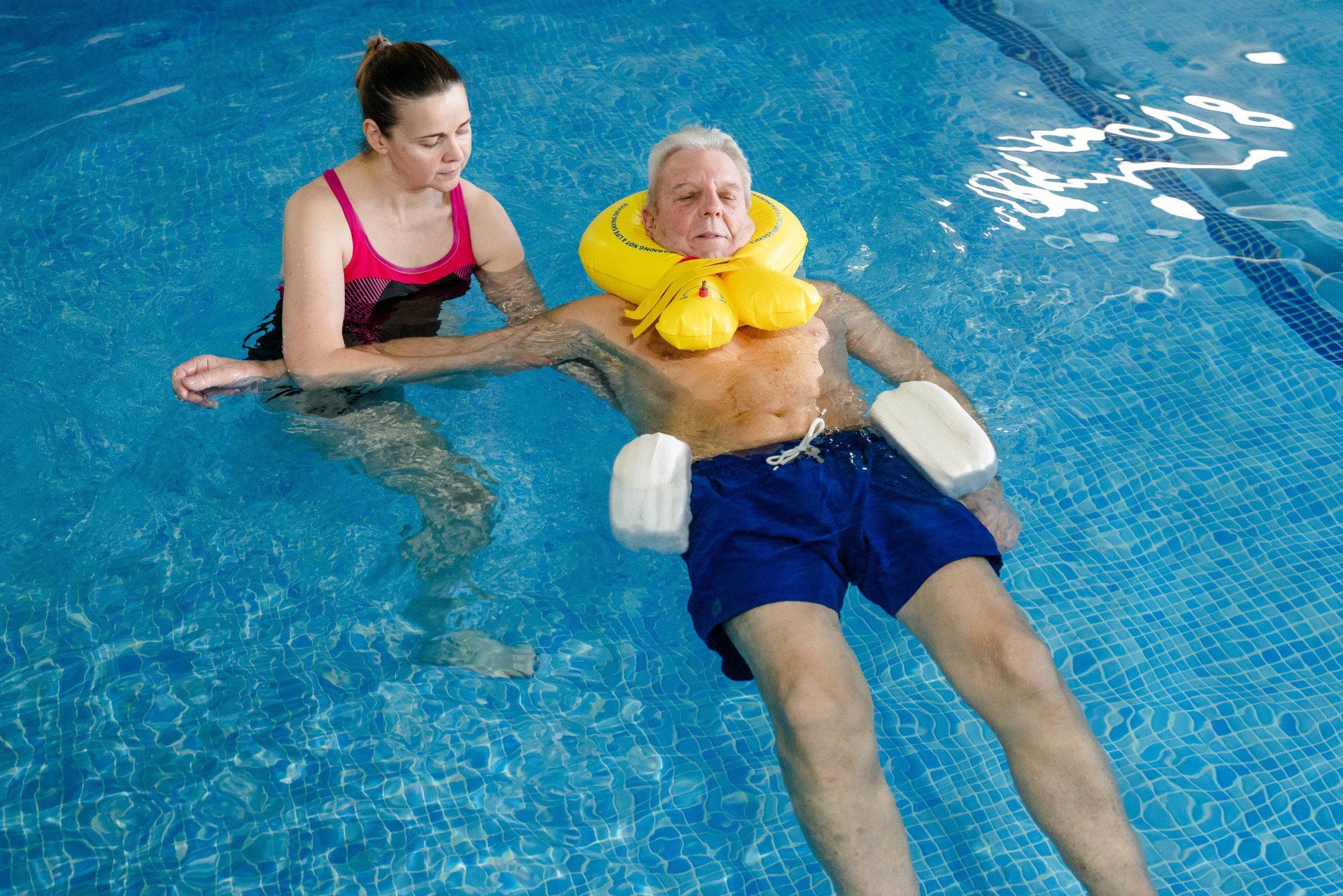
Slide title
Write your caption hereButton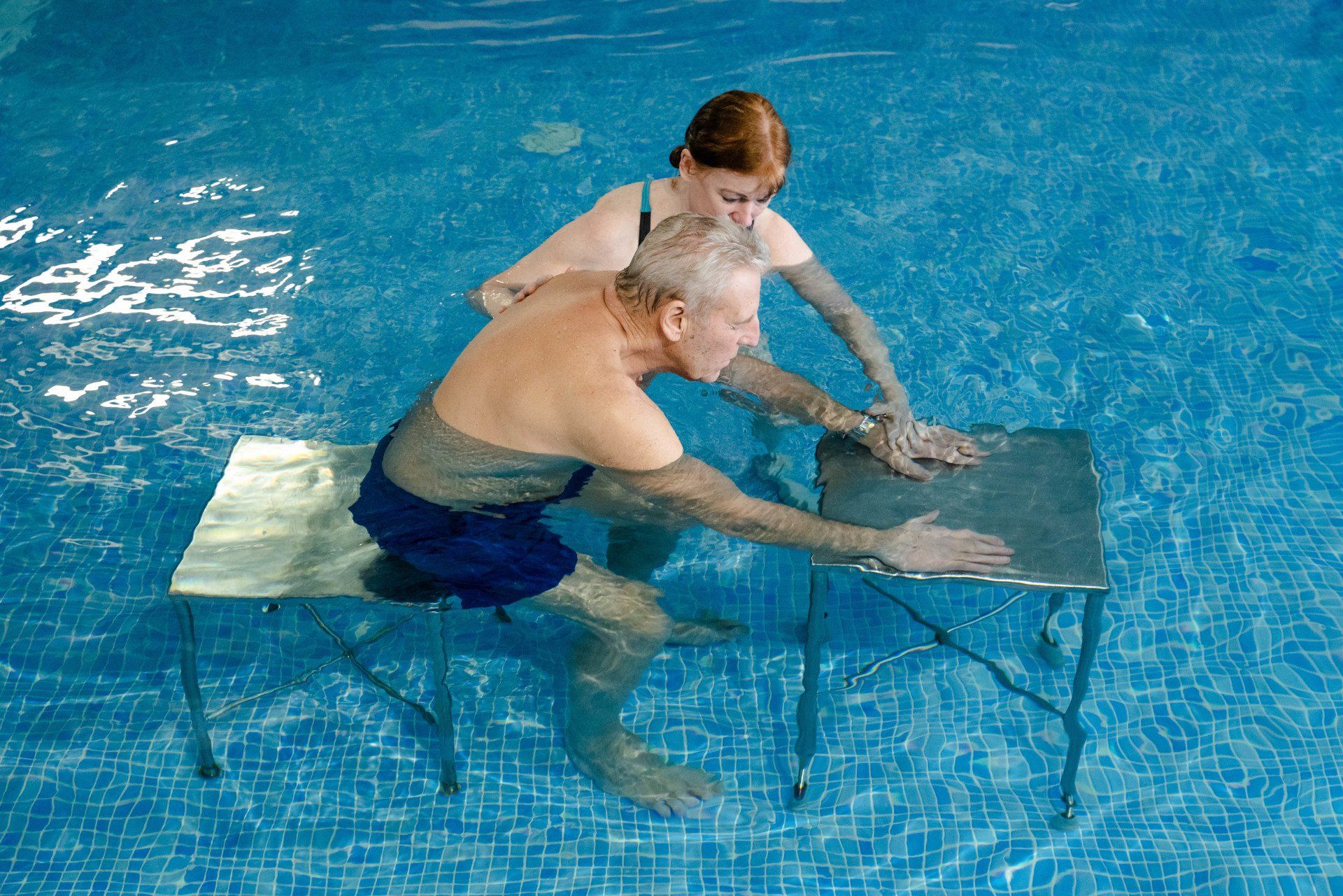
Slide title
Write your caption hereButton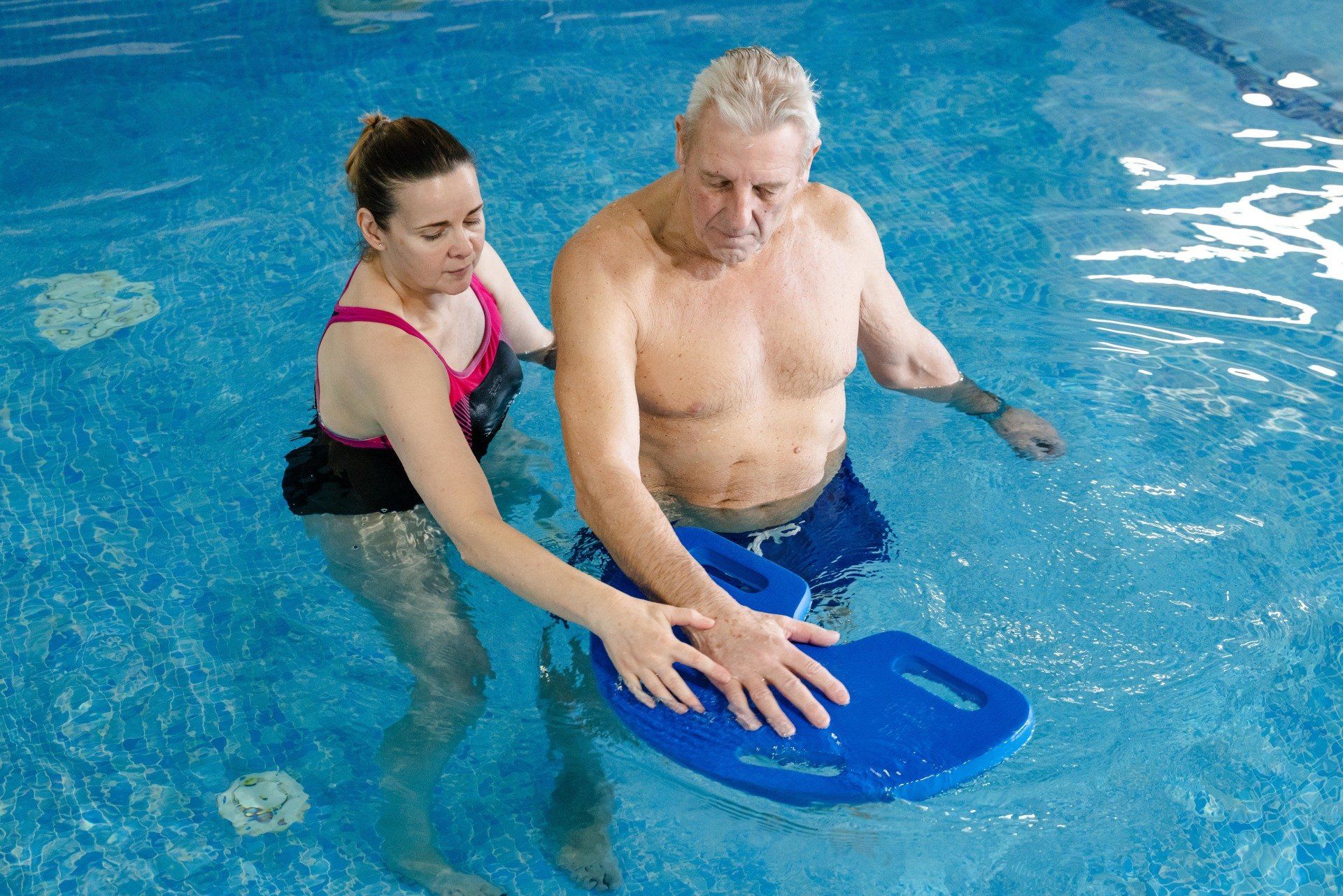
Slide title
Write your caption hereButton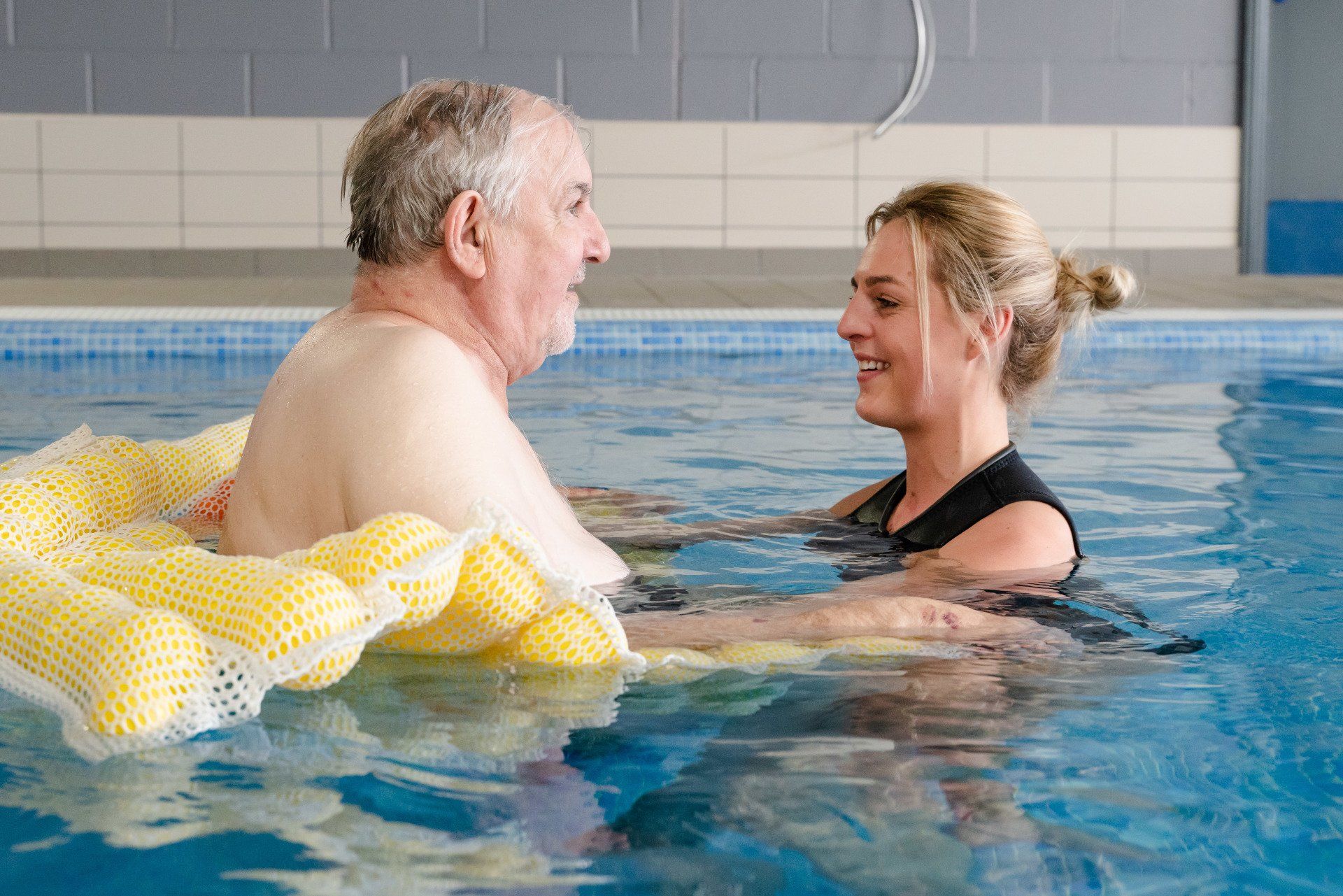
Slide title
Write your caption hereButton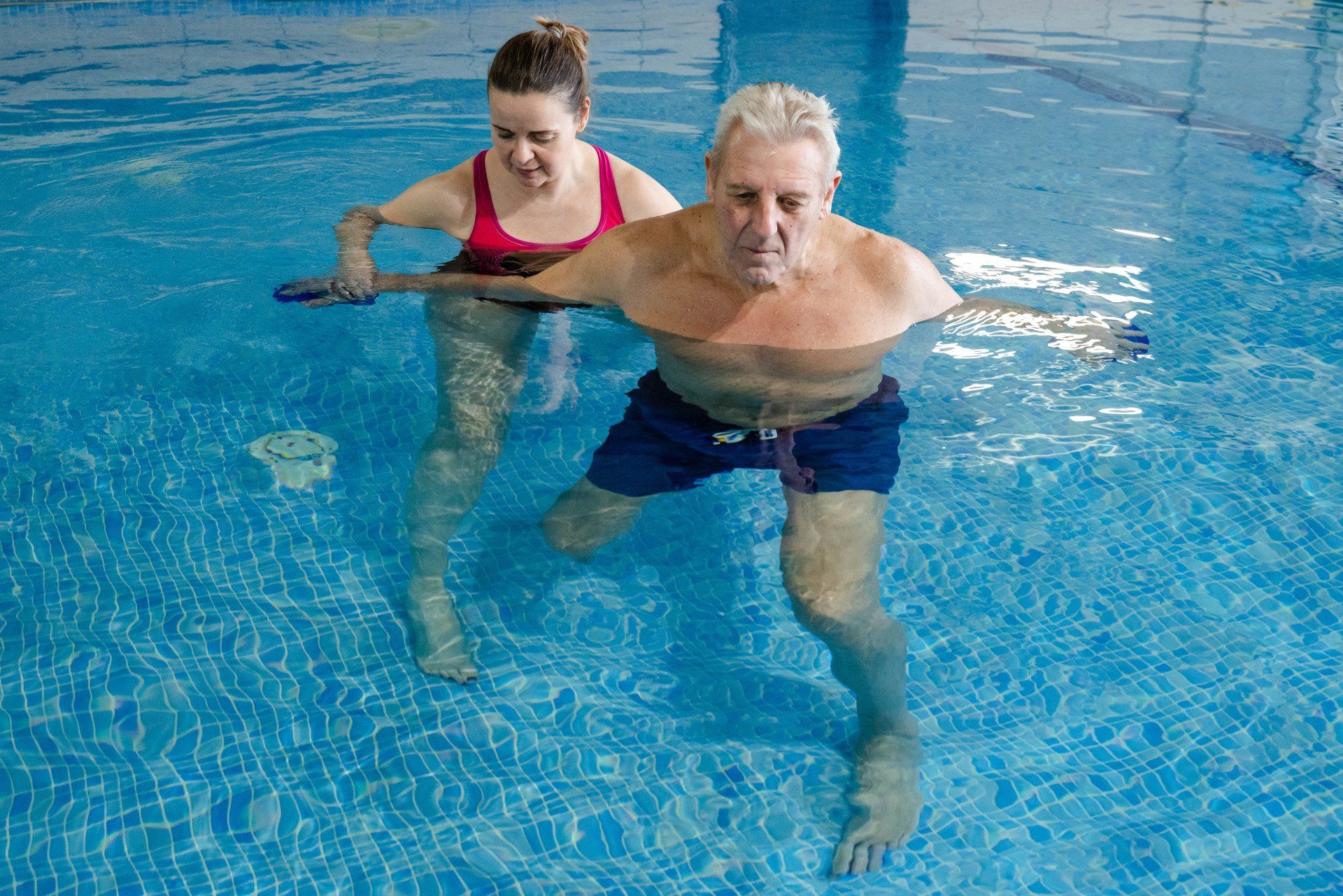
Slide title
Write your caption hereButton
Stroke & Brain Injury
Can be Traumatic or non traumatic defined as an alteration in brain function, or other evidence of brain pathology, caused by an external force or by internal factors. The results of a brain injury are a variety of problems on all levels of impairment, activity and participation. Physical rehabilitation after discharge from hospital is usually required.
The effects of a stroke or brain injury can make it more difficult to undertake everyday functional activities and can include:
- Muscle weakness
- Paralysis
- Stiffness
- Spasticity (hypertonicity)
- Flaccidity (floppy muscles)
- Changes in sensation
- Reduced stamina
- Contractures of muscles/soft tissues
- Altered awareness the body’s position and movement
- Reduced balance
Hydrotherapy is a valuable treatment in the rehabilitative and maintenance phase. Often patients are able to perform activities in the pool that they are unable to perform on dry land.
The benefits of hydrotherapy are as follows:
- Decreased stiffness in turn increases both the quality and range of motion in muscles and joints, which consequently improves balance.
- Improved motor patterns due to a reduction of pain and decreased effort to make movements in the water as opposed to on dry land.
- Weakened muscles both in the trunk and limbs can be strengthened against the resistance of water.
- Improved confidence in undertaking functional abilities whilst in the pool due to the water providing a safe environment.
- Improved cardiovascular endurance.
- Increased mood, motivation and self-esteem due to being able to exercise/function more easily in a relaxing and supportive environment.
Stroke & Brain Injury
Can be Traumatic or non traumatic defined as an alteration in brain function, or other evidence of brain pathology, caused by an external force or by internal factors. The results of a brain injury are a variety of problems on all levels of impairment, activity and participation. Physical rehabilitation after discharge from hospital is usually required.
The effects of a stroke or brain injury can make it more difficult to undertake everyday functional activities and can include:
- Muscle weakness
- Paralysis
- Stiffness
- Spasticity (hypertonicity)
- Flaccidity (floppy muscles)
- Changes in sensation
- Reduced stamina
- Contractures of muscles/soft tissues
- Altered awareness the body’s position and movement
- Reduced balance
Hydrotherapy is a valuable treatment in the rehabilitative and maintenance phase. Often patients are able to perform activities in the pool that they are unable to perform on dry land.
The benefits of hydrotherapy are as follows:
- Decreased stiffness in turn increases both the quality and range of motion in muscles and joints, which consequently improves balance.
- Improved motor patterns due to a reduction of pain and decreased effort to make movements in the water as opposed to on dry land.
- Weakened muscles both in the trunk and limbs can be strengthened against the resistance of water.
- Improved confidence in undertaking functional abilities whilst in the pool due to the water providing a safe environment.
- Improved cardiovascular endurance.
- Increased mood, motivation and self-esteem due to being able to exercise/function more easily in a relaxing and supportive environment.

Slide title
Write your caption hereButton
Slide title
Write your caption hereButton
Slide title
Write your caption hereButton
Slide title
Write your caption hereButton
Slide title
Write your caption hereButton
Slide title
Write your caption hereButton
Slide title
Write your caption hereButton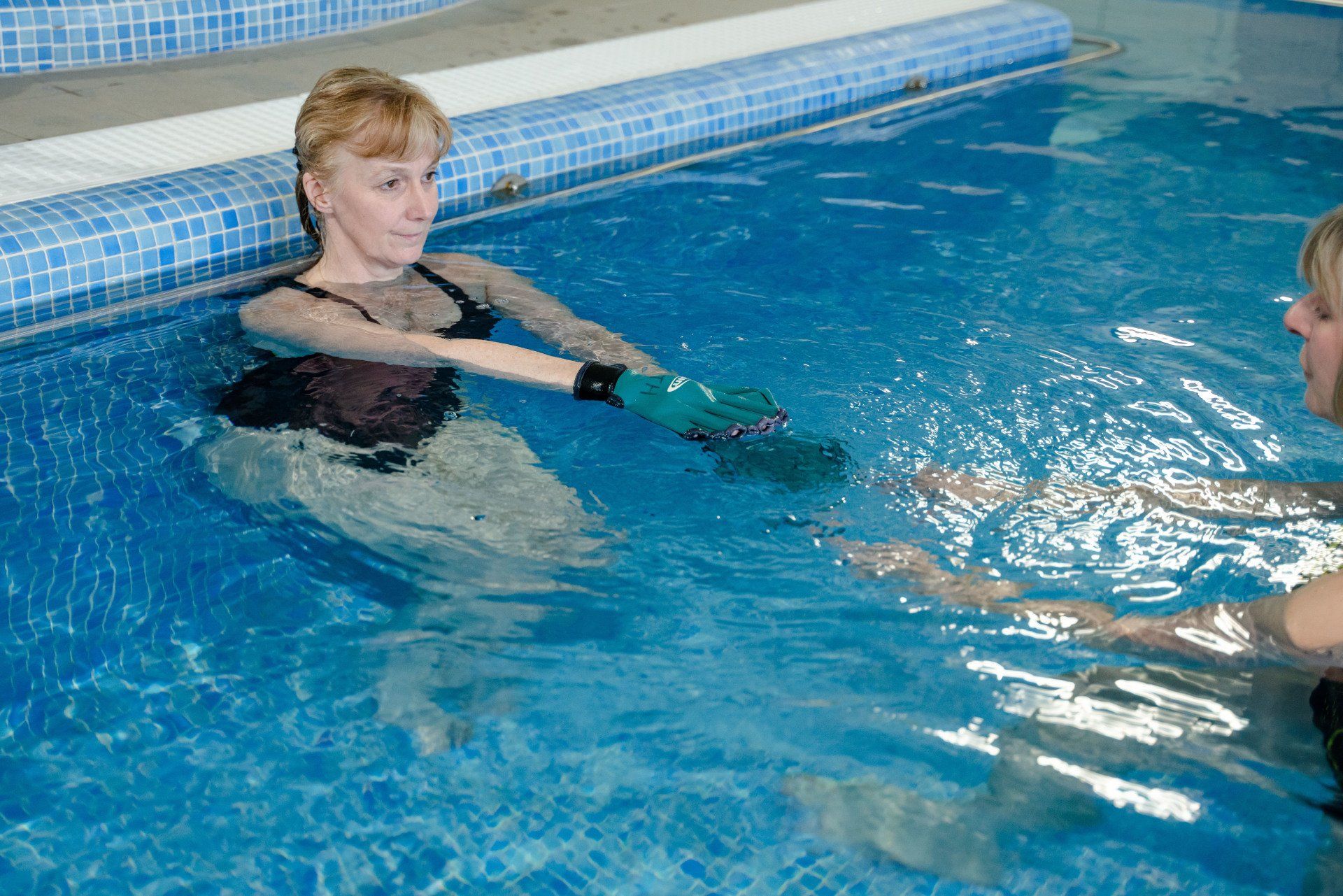
Slide title
Write your caption hereButton
Slide title
Write your caption hereButton
Rheumatological Conditions
E.g. Some of the most common are Rheumatoid Arthritis, Ankylosing Spondylitis, Psoriatic Arthritis, Fibromyalgia and Polymyalgia Rheumatica, Ehlers-Danlos syndrome.
There are many types of rheumatic diseases. Most commonly they affect the joints, but can also involve tendons, ligaments, bones and muscles, causing inflammation, pain, loss of mobility and loss of function.
A multi-disciplinary approach is taken to help patients manage these conditions, of which physiotherapy is a very important part.
Hydrotherapy is an excellent way of providing the required physiotherapy input and has a number of advantages over land based treatment:
- Freedom of movement in the water and not having to work against gravity can give patients a level of comfort and joint mobility they are unable to achieve on land.
- Warmth of water helps to relax muscles making necessary joint motion less painful, and can give patients a sense of 'thawing' as they feel a release of restricted movements.
- Warmth of water can help to reduce the constant chronic pain associated with these conditions.
- Hydrostatic pressure can help to reduce inflammation.
- Hydrostatic pressure can give a better sense of feeling and connection to affected joints, giving patients an awareness of their movements they do not have on land, allowing them to push further into restriction without causing further aggravation.
- Water resistance can be used to build strength in the weakened muscles around the joint without causing pain.
Rheumatological Conditions
E.g. Some of the most common are Rheumatoid Arthritis, Ankylosing Spondylitis, Psoriatic Arthritis, Fibromyalgia and Polymyalgia Rheumatica, Ehlers-Danlos syndrome.
There are many types of rheumatic diseases. Most commonly they affect the joints, but can also involve tendons, ligaments, bones and muscles, causing inflammation, pain, loss of mobility and loss of function.
A multi-disciplinary approach is taken to help patients manage these conditions, of which physiotherapy is a very important part.
Hydrotherapy is an excellent way of providing the required physiotherapy input and has a number of advantages over land based treatment:
- Freedom of movement in the water and not having to work against gravity can give patients a level of comfort and joint mobility they are unable to achieve on land.
- Warmth of water helps to relax muscles making necessary joint motion less painful, and can give patients a sense of 'thawing' as they feel a release of restricted movements.
- Warmth of water can help to reduce the constant chronic pain associated with these conditions.
- Hydrostatic pressure can help to reduce inflammation.
- Hydrostatic pressure can give a better sense of feeling and connection to affected joints, giving patients an awareness of their movements they do not have on land, allowing them to push further into restriction without causing further aggravation.
- Water resistance can be used to build strength in the weakened muscles around the joint without causing pain.

Slide title
Write your caption hereButton
Slide title
Write your caption hereButton
Slide title
Write your caption hereButton
Slide title
Write your caption hereButton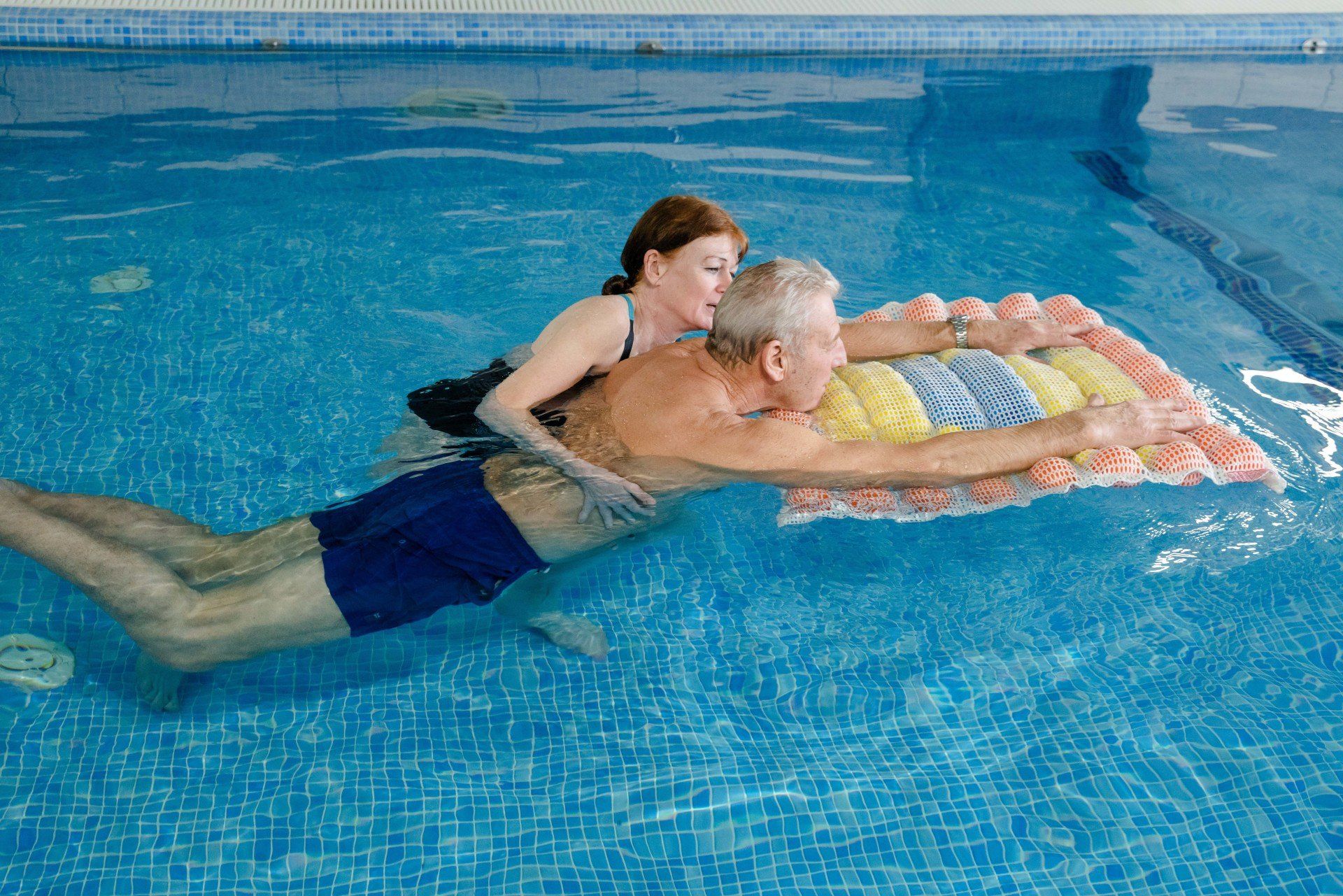
Slide title
Write your caption hereButton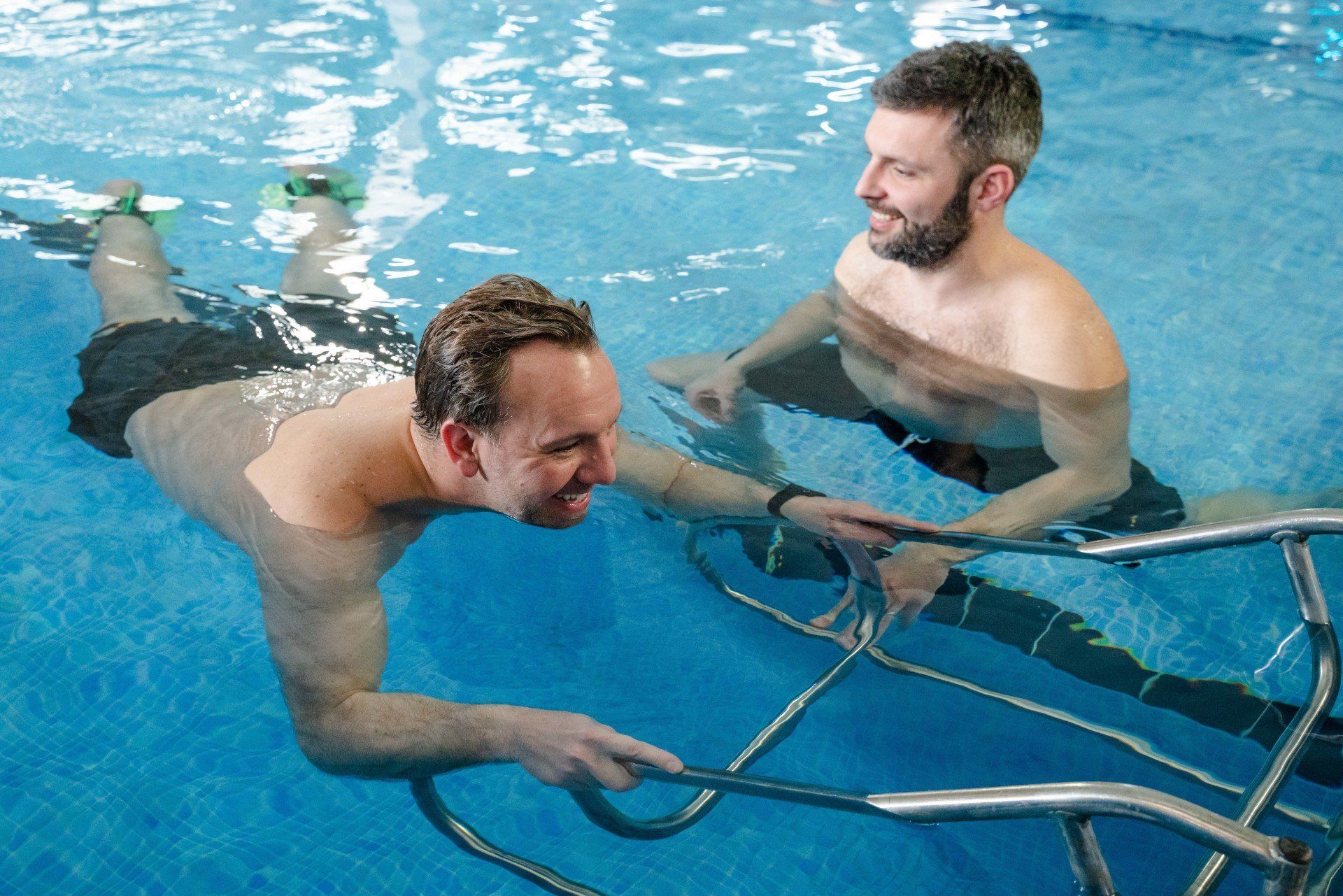
Slide title
Write your caption hereButton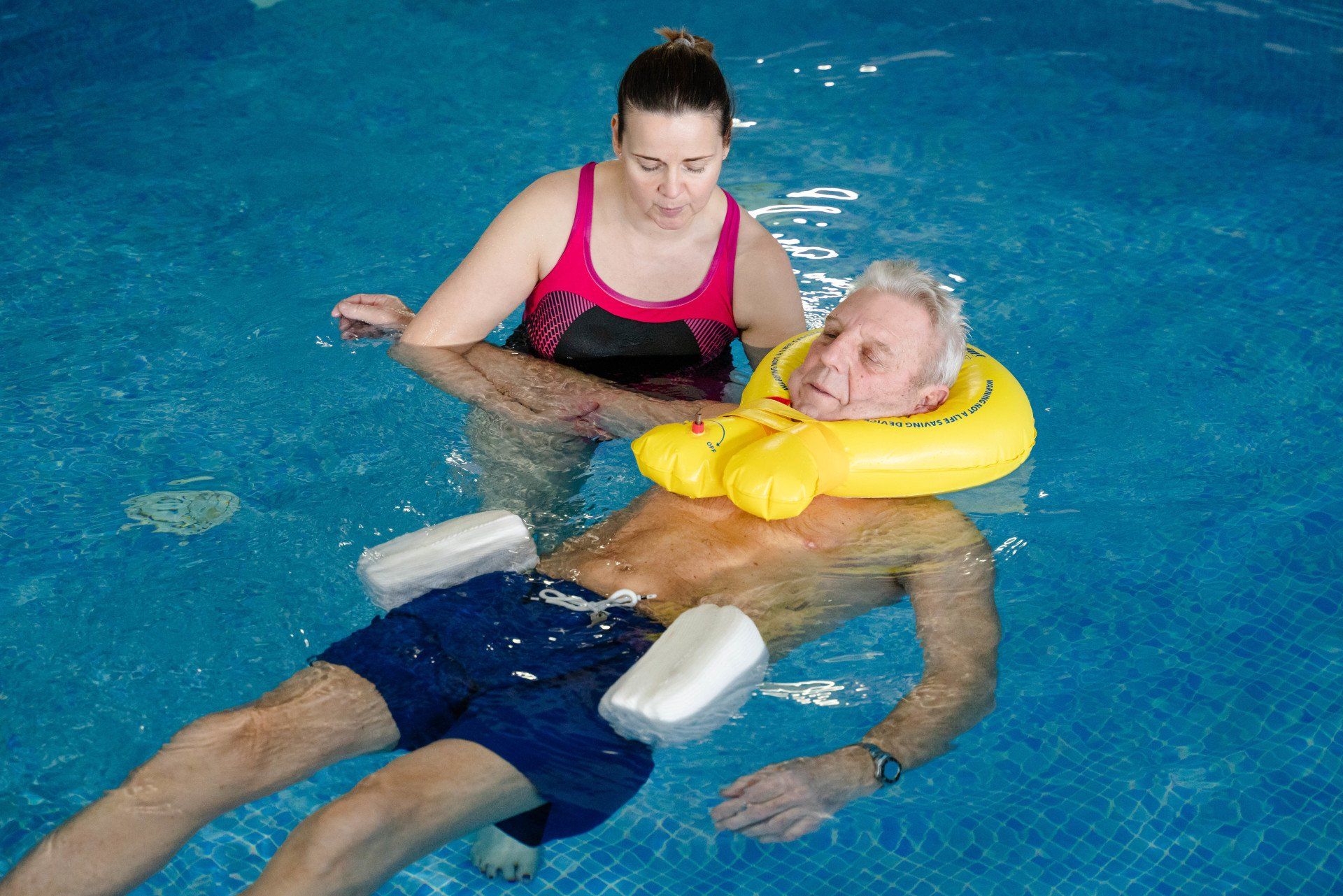
Slide title
Write your caption hereButton
Slide title
Write your caption hereButton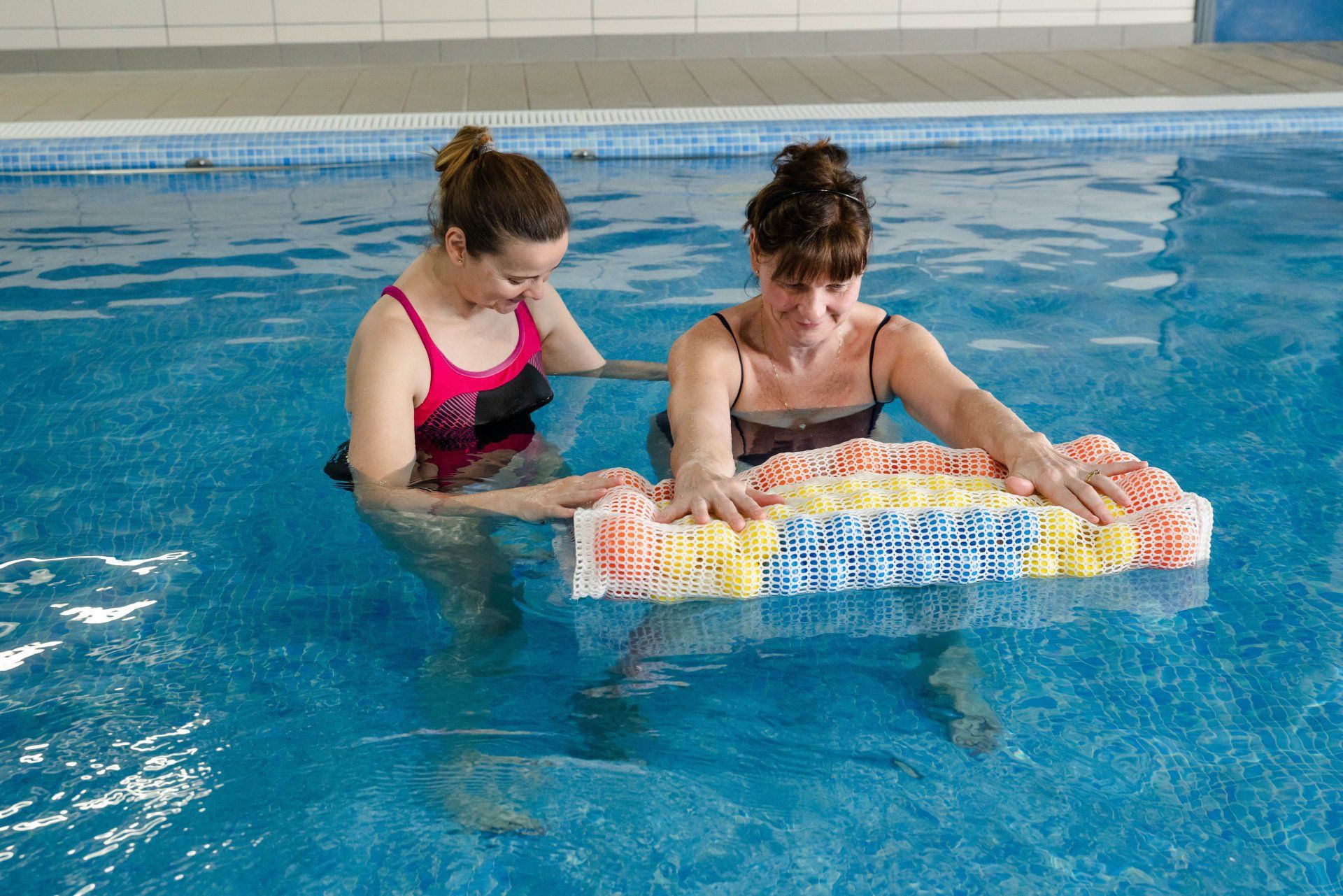
Slide title
Write your caption hereButton
Autoimmune Disorders
Eg Rheumatoid Arthritis, Multiple Sclerosis, Fibromyalgia, Lupus, Eryphematosus.
Autoimmune diseases, can cause muscle weakness, fatigue, painful swollen joints and pain, which can have devastating and debilitating consequences on everyday living – physically and mentally.
Aside from the medical treatment such as steroids and disease-modifying drugs, hydrotherapy and physiotherapy can help to alleviate, prevent or even reduce the progression of symptoms and regain confidence and function.
Hydrotherapy can:
- Reduce joint stiffness, weakness and pain by improving range of movement, core stability, muscle strength and joint stabilisation.
- The treatment can significantly improve activity and mental wellbeing. This in turn improves cardiac endurance, stamina, neurological coordination, sleep patterns and mental well-being, thus reducing stress and assisting in weight management.
- A warm, gravity eliminated environment enabling individuals to exercise and move pain free working with the resistance, support and pressure of the water.
- Guided and assisted by a specialist hydrotherapist, exercises and therapy are specifically tailored to your condition and individual needs – pain free!
- This can be progressed into devising your own tailored exercise programs for continued independent exercise.
- In addition, physiotherapy transfers these benefits from the pool work onto dry land, enabling individuals to self-manage their symptoms and enjoy a better quality of life.
Autoimmune Disorders
Eg Rheumatoid Arthritis, Multiple Sclerosis, Fibromyalgia, Lupus, Eryphematosus.
Autoimmune diseases, can cause muscle weakness, fatigue, painful swollen joints and pain, which can have devastating and debilitating consequences on everyday living – physically and mentally.
Aside from the medical treatment such as steroids and disease-modifying drugs, hydrotherapy and physiotherapy can help to alleviate, prevent or even reduce the progression of symptoms and regain confidence and function.
Hydrotherapy can:
- Reduce joint stiffness, weakness and pain by improving range of movement, core stability, muscle strength and joint stabilisation.
- The treatment can significantly improve activity and mental wellbeing. This in turn improves cardiac endurance, stamina, neurological coordination, sleep patterns and mental well-being, thus reducing stress and assisting in weight management.
- A warm, gravity eliminated environment enabling individuals to exercise and move pain free working with the resistance, support and pressure of the water.
- Guided and assisted by a specialist hydrotherapist, exercises and therapy are specifically tailored to your condition and individual needs – pain free!
- This can be progressed into devising your own tailored exercise programs for continued independent exercise.
- In addition, physiotherapy transfers these benefits from the pool work onto dry land, enabling individuals to self-manage their symptoms and enjoy a better quality of life.

Slide title
Write your caption hereButton
Slide title
Write your caption hereButton
Slide title
Write your caption hereButton
Slide title
Write your caption hereButton
Slide title
Write your caption hereButton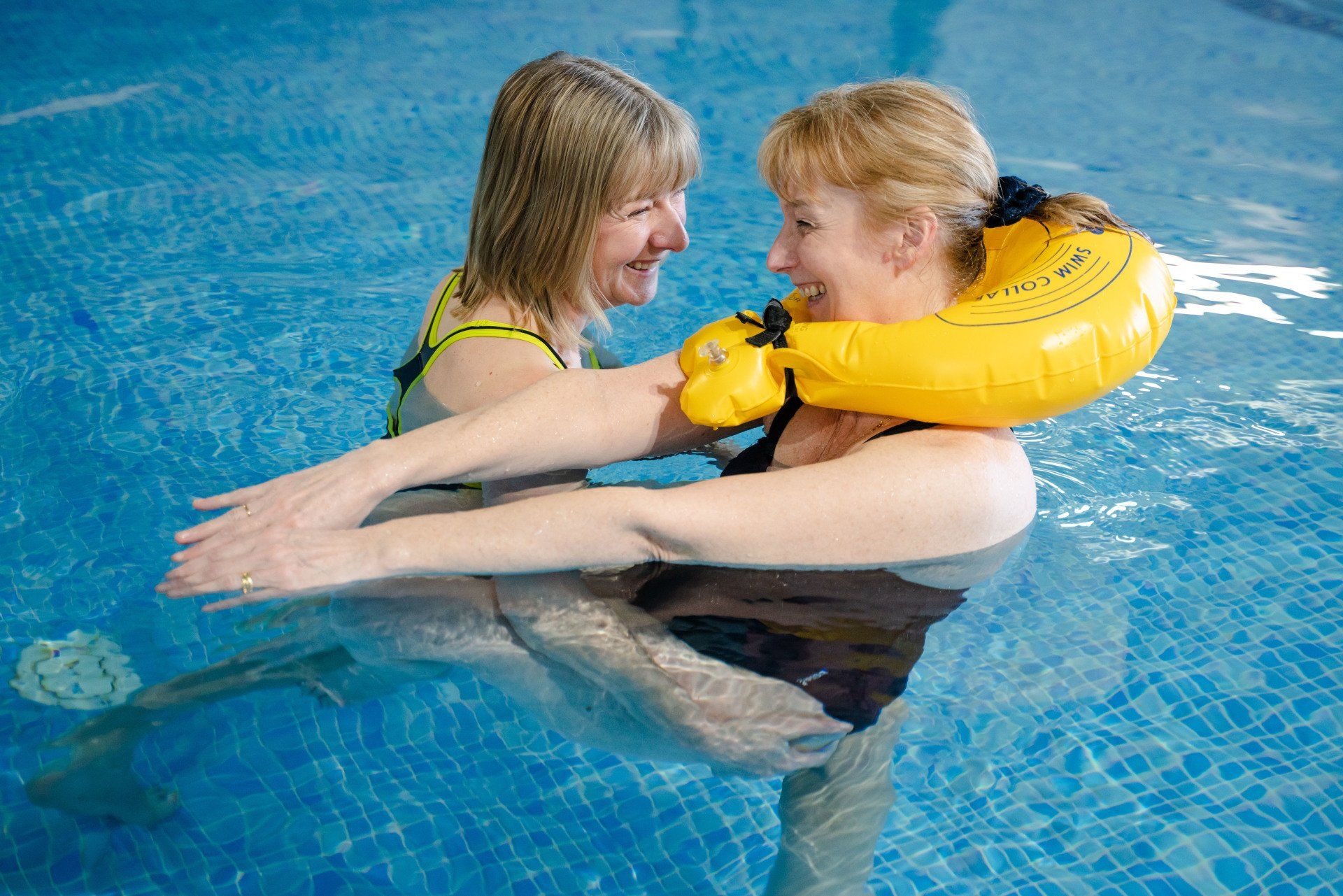
Slide title
Write your caption hereButton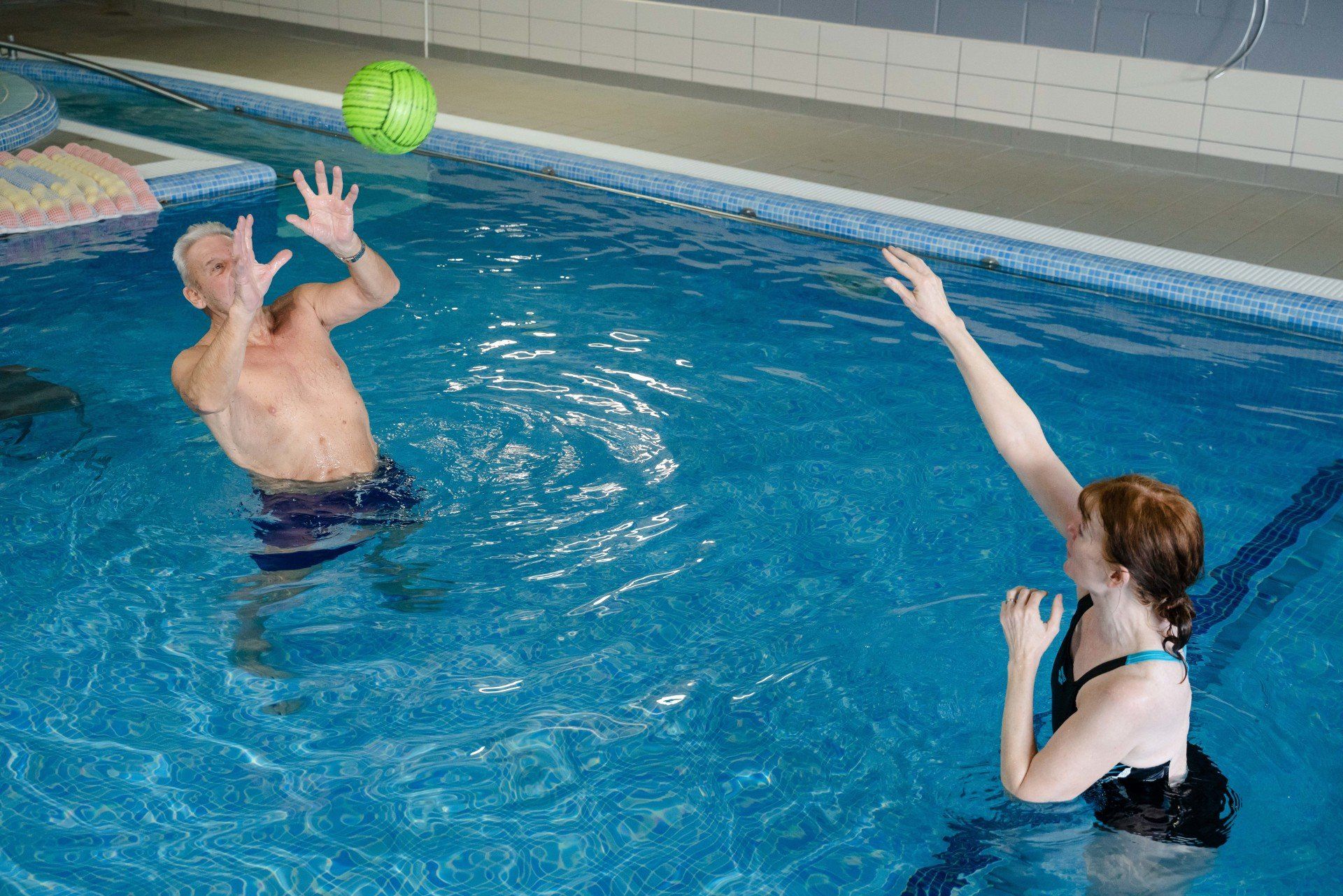
Slide title
Write your caption hereButton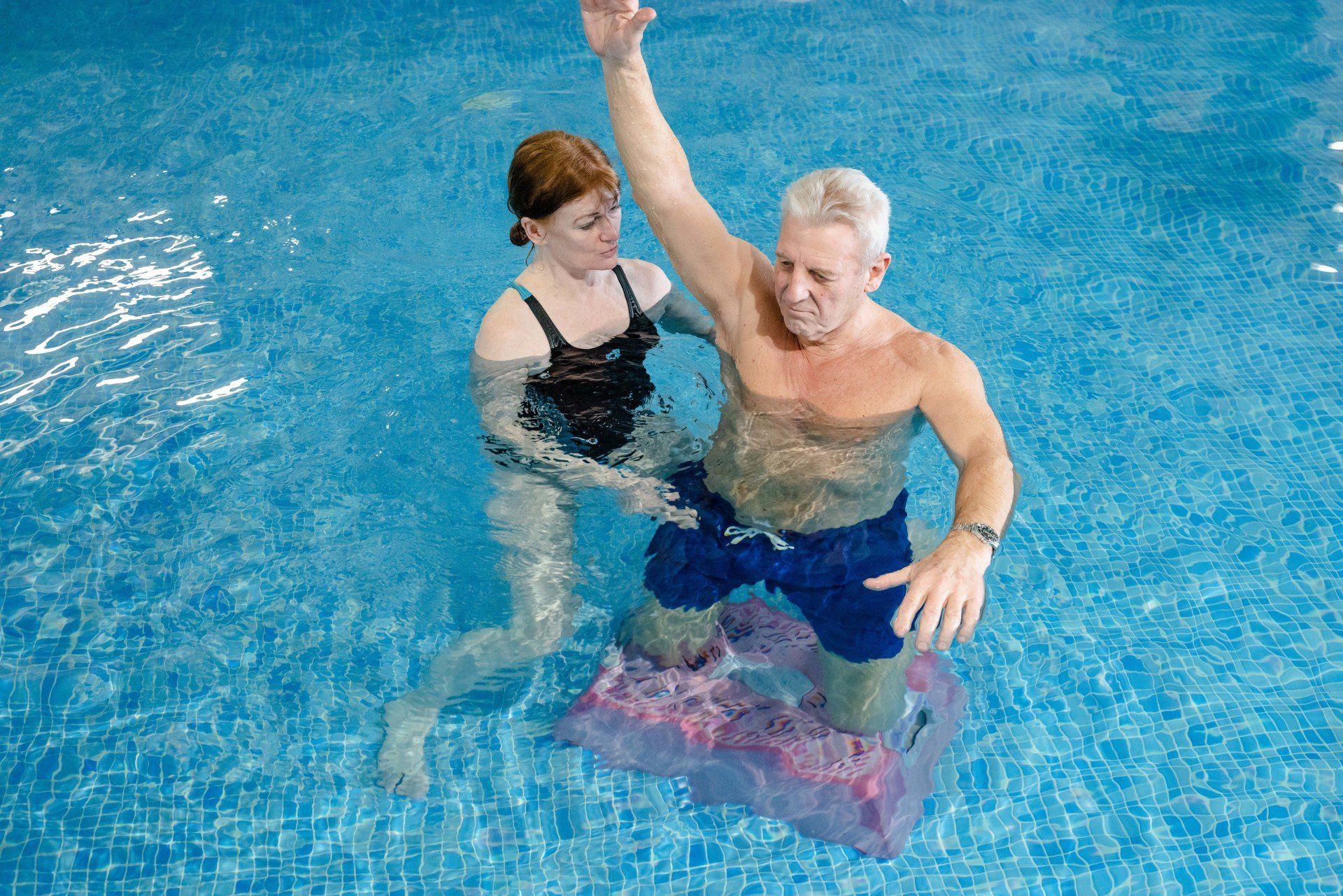
Slide title
Write your caption hereButton
Slide title
Write your caption hereButton
Learning Difficulties
There may be issues with understanding, as well as anxiety and have difficulty with movement, potentially being immobile and reliant on a wheelchair.
Hydrotherapy is beneficial:
- The warmth of the water encourages relaxation and reduces anxiety and can enhance feelings of wellbeing and enjoyment even if understanding is limited. Ability and fun are linked.
- The support it gives means that the person can easily be guided by 1 person and can experience different positions without fear in a gentle environment.
- The buoyancy assists movements that would otherwise be difficult, sometimes impossible on land e.g. standing up, walking and even running and jumping, with the benefits of improved bone /joint health and strength of muscles that that brings.
- Even with relative inactivity in the water, benefits are huge due to the hydrostatic properties - circulation improves, heart rate and breathing increase all proven benefits of exercise just by being in the pool. There are also added benefits of improved kidney function and relief of pressure areas.
- Issues such as epilepsy and continence are not a contraindication.
Learning Difficulties
There may be issues with understanding, as well as anxiety and have difficulty with movement, potentially being immobile and reliant on a wheelchair.
Hydrotherapy is beneficial:
- The warmth of the water encourages relaxation and reduces anxiety and can enhance feelings of wellbeing and enjoyment even if understanding is limited. Ability and fun are linked.
- The support it gives means that the person can easily be guided by 1 person and can experience different positions without fear in a gentle environment.
- The buoyancy assists movements that would otherwise be difficult, sometimes impossible on land e.g. standing up, walking and even running and jumping, with the benefits of improved bone /joint health and strength of muscles that that brings.
- Even with relative inactivity in the water, benefits are huge due to the hydrostatic properties - circulation improves, heart rate and breathing increase all proven benefits of exercise just by being in the pool. There are also added benefits of improved kidney function and relief of pressure areas.
- Issues such as epilepsy and continence are not a contraindication.
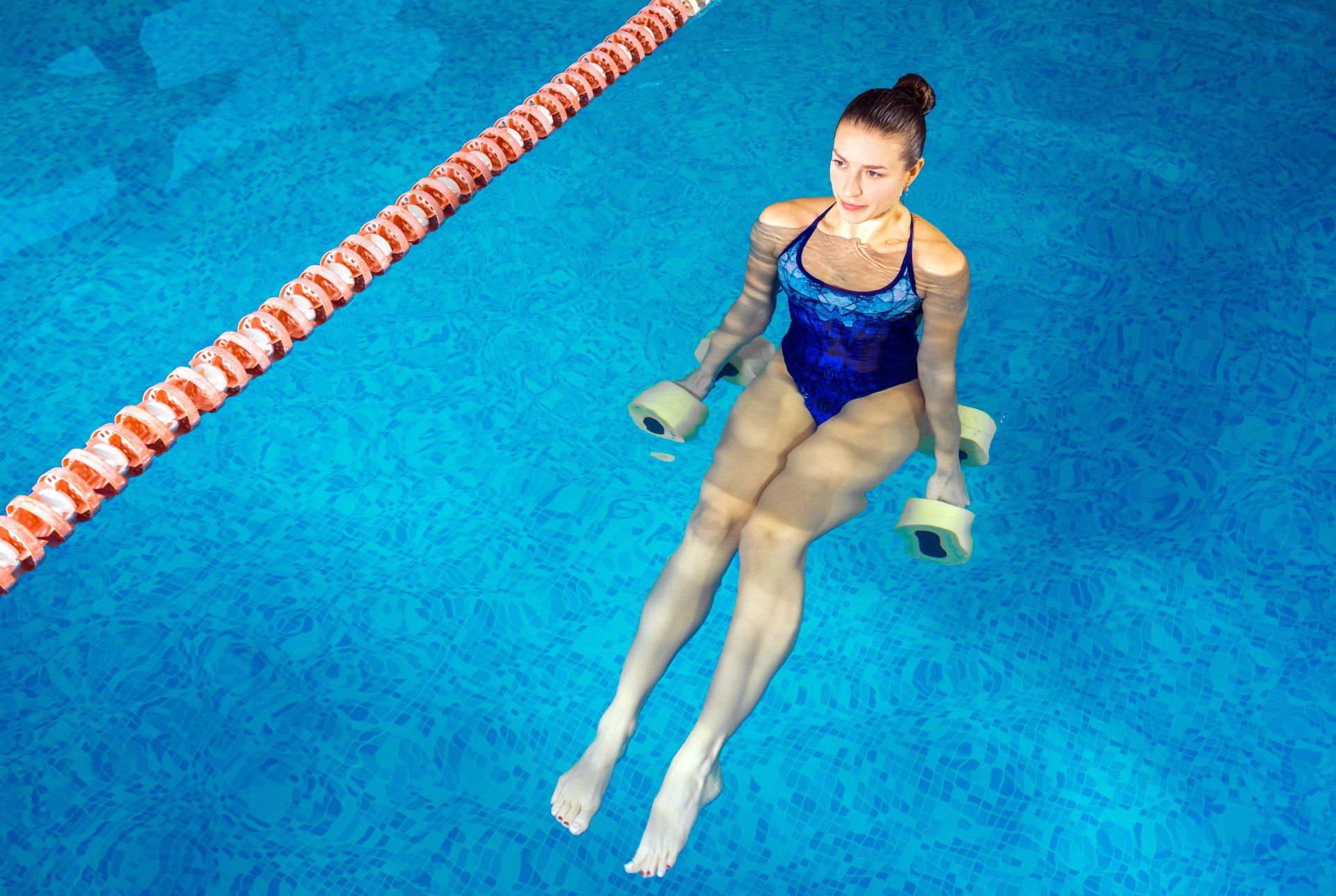
Slide title
Write your caption hereButton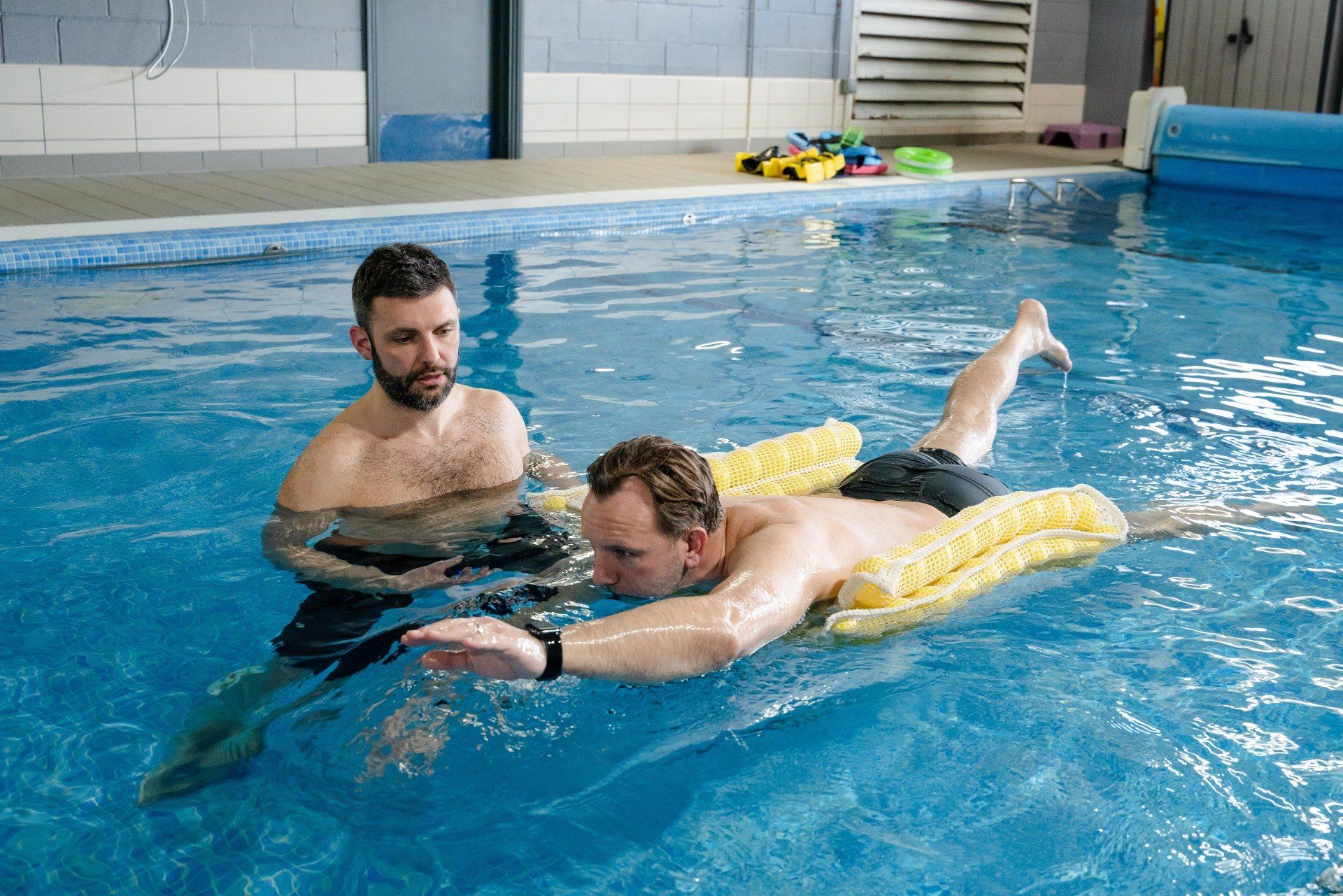
Slide title
Write your caption hereButton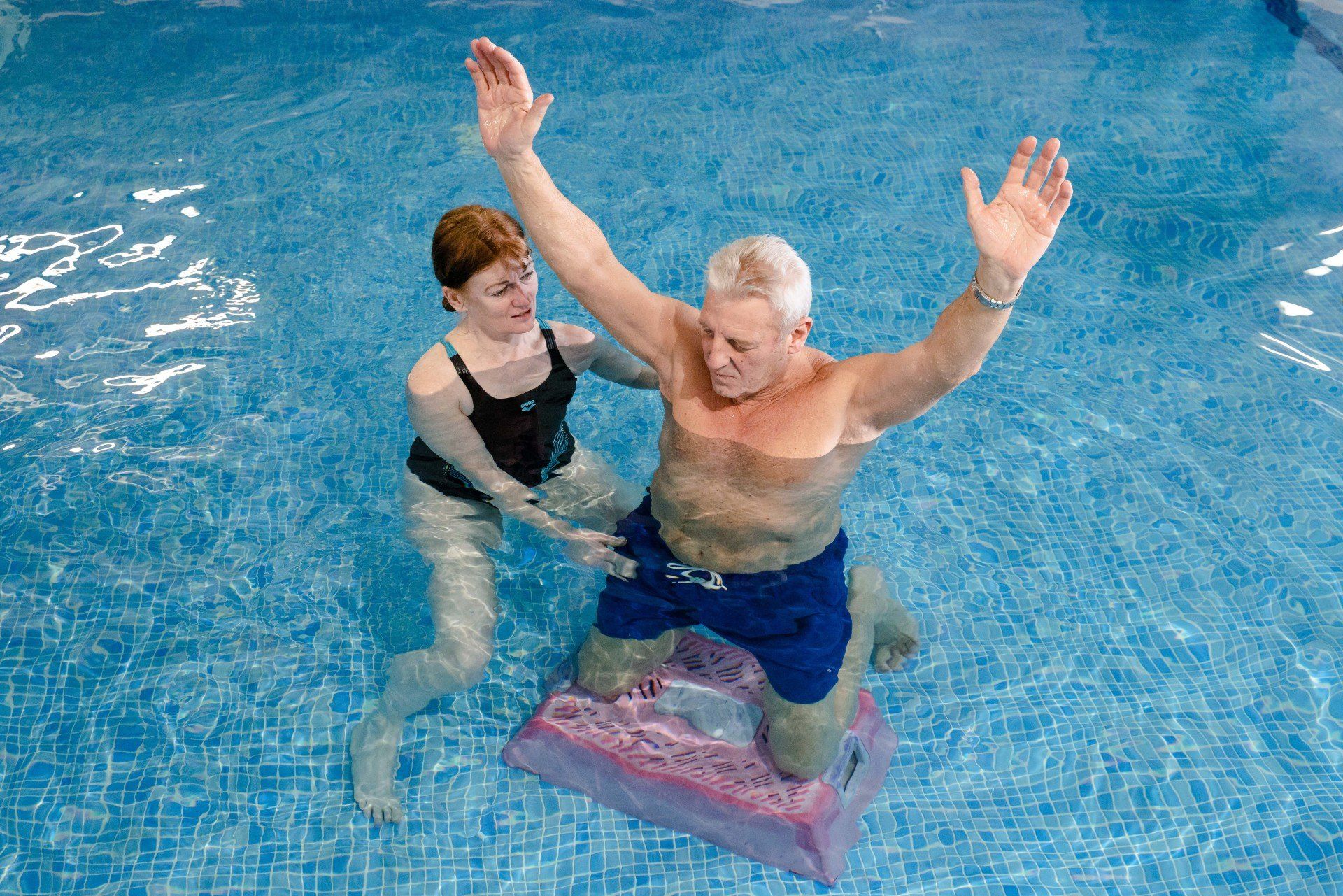
Slide title
Write your caption hereButton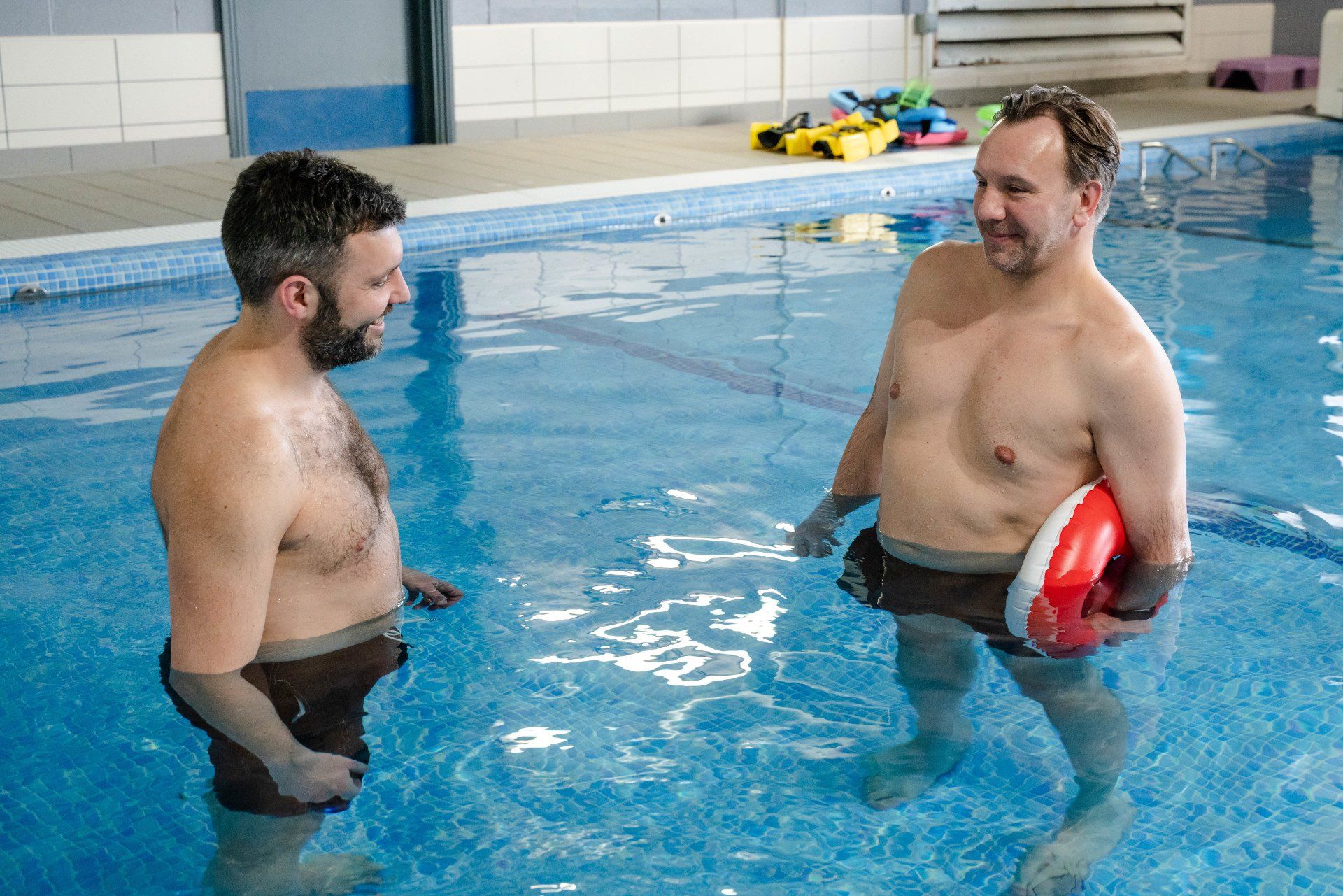
Slide title
Write your caption hereButton
Reduced Fitness
Whether this is due to injury and being unable to exercise or just from lack of exercise. Maybe because you don’t know what to do or how to do it safely and are concerned that you will cause injury to yourself. You could lack motivation or just want to get fitter. The water is an extremely safe place to start your fitness journey with hydrotherapy an excellent treatment to tackle this. Things in the water are often more achievable than on land but just as hard work and results are as effective.
- Core stability on entering the water in the upright position is challenged immediately and is the essential basis for fitness and control.
- A whole body workout can be achieved with positional changes and actions very smooth and easy in the water.
- Speed will increase resistance and is therapist guided along with differing equipment to improve stamina and fitness.
- Due to the type of muscle work in the pool there is no post exercise soreness that you can get on land after exercising.
- If you have painful joints, land exercise to gain fitness can flare up problems. In the water the reduced weight and compression through the joints allows expulsive and propulsive joint movements but with no weight bearing shock.
- If you wish to lose weight the water is an ideal place to start your fitness regime without overloading your joints.
Reduced Fitness
Whether this is due to injury and being unable to exercise or just from lack of exercise. Maybe because you don’t know what to do or how to do it safely and are concerned that you will cause injury to yourself. You could lack motivation or just want to get fitter. The water is an extremely safe place to start your fitness journey with hydrotherapy an excellent treatment to tackle this. Things in the water are often more achievable than on land but just as hard work and results are as effective.
- Core stability on entering the water in the upright position is challenged immediately and is the essential basis for fitness and control.
- A whole body workout can be achieved with positional changes and actions very smooth and easy in the water.
- Speed will increase resistance and is therapist guided along with differing equipment to improve stamina and fitness.
- Due to the type of muscle work in the pool there is no post exercise soreness that you can get on land after exercising.
- If you have painful joints, land exercise to gain fitness can flare up problems. In the water the reduced weight and compression through the joints allows expulsive and propulsive joint movements but with no weight bearing shock.
- If you wish to lose weight the water is an ideal place to start your fitness regime without overloading your joints.

Slide title
Write your caption hereButton
Slide title
Write your caption hereButton
Slide title
Write your caption hereButton
Slide title
Write your caption hereButton
Slide title
Write your caption hereButton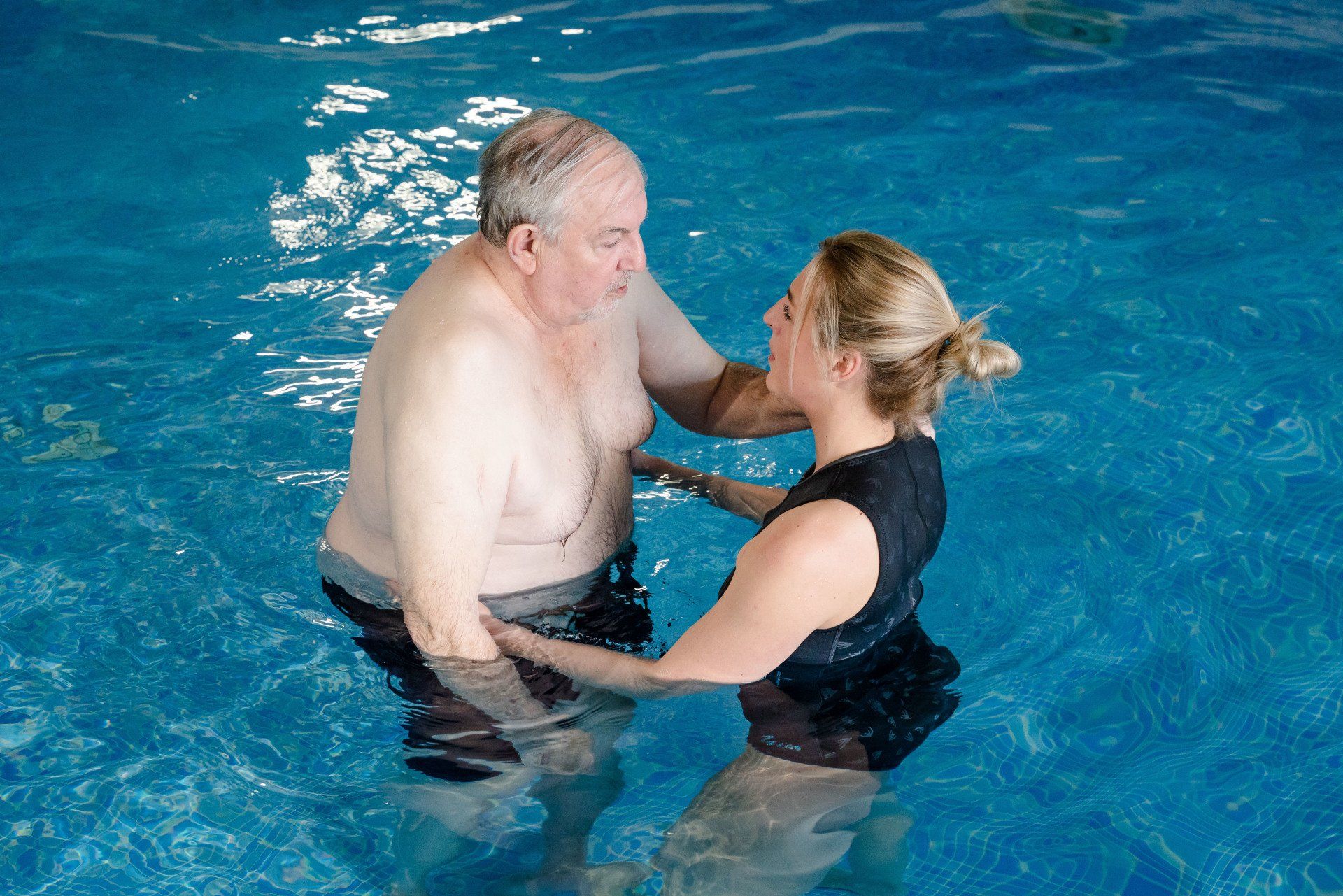
Slide title
Write your caption hereButton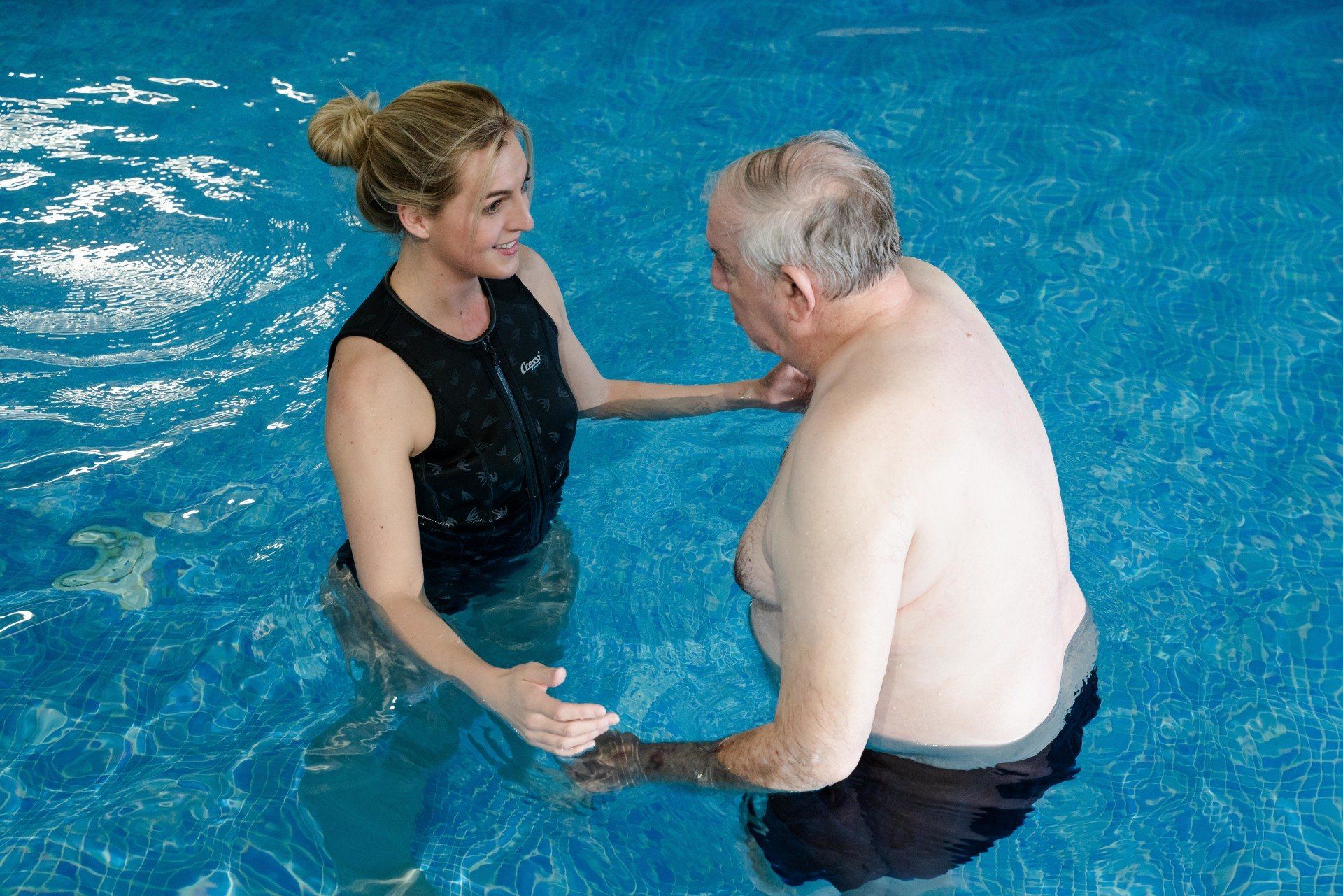
Slide title
Write your caption hereButton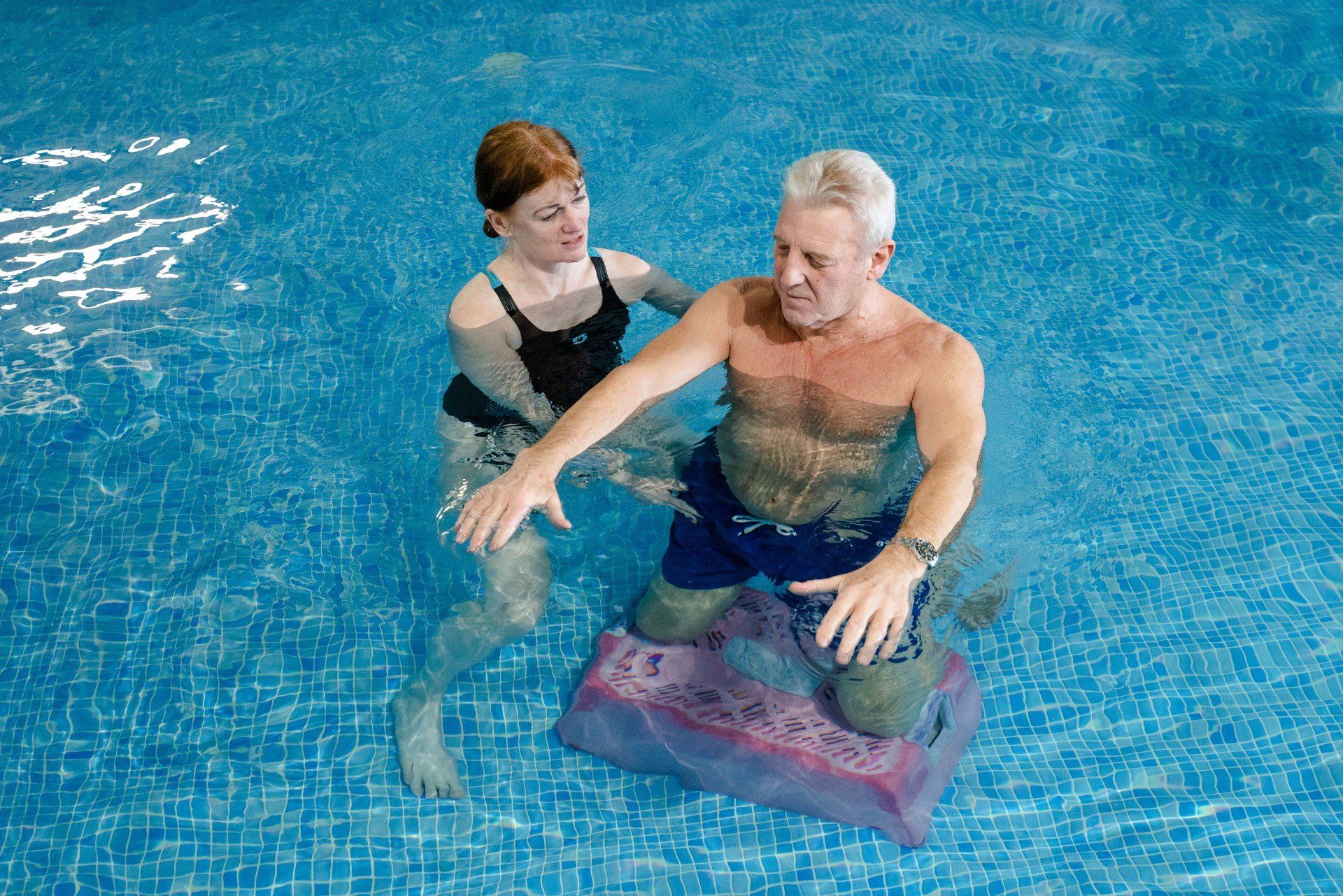
Slide title
Write your caption hereButton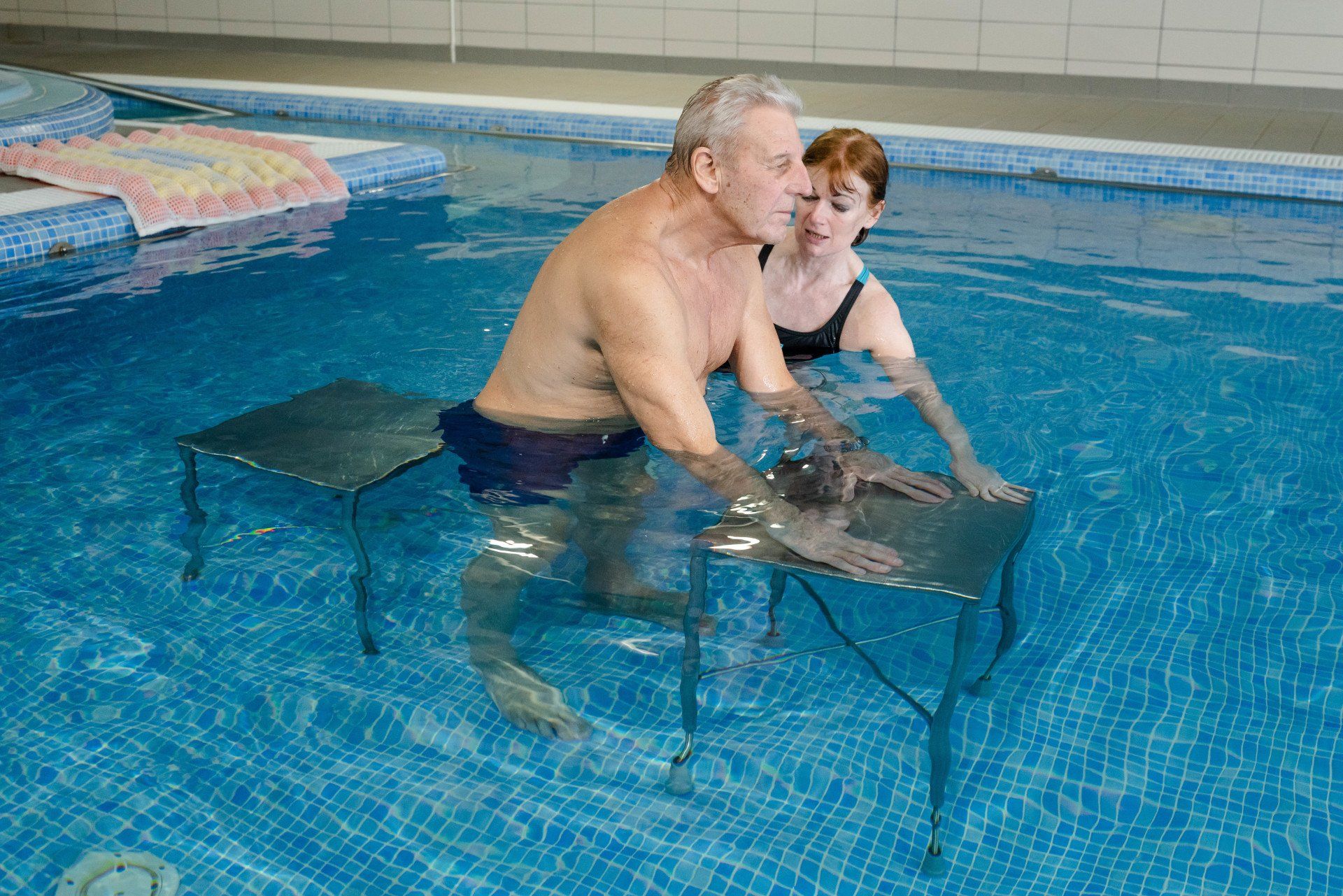
Slide title
Write your caption hereButton
Falls Management
Falls and fall-related injuries are a common and serious problem for older people. People aged 65 and older have the highest risk of falling, with 30% of people older than 65 and 50% of people older than 80 falling at least once a year (NICE guidance). However, as physiotherapists we acknowledge falls can occur at any age. Falls cause distress, pain, injury, loss of confidence, loss of independence and mortality.
How hydro helps:
- Improve mobility in a relaxing and supportive environment.
- Strengthen muscles through the resistance of the water created by drag or buoyancy.
- Improve balance and coordination through the support from the water.
- To progress rehabilitation, turbulence can be utilised for a greater challenge.
- Aid improvement of core and postural stability.
- Re-educate normal function.
- Reduce fear of falling knowing the water will always be a soft landing.
Falls Management
Falls and fall-related injuries are a common and serious problem for older people. People aged 65 and older have the highest risk of falling, with 30% of people older than 65 and 50% of people older than 80 falling at least once a year (NICE guidance). However, as physiotherapists we acknowledge falls can occur at any age. Falls cause distress, pain, injury, loss of confidence, loss of independence and mortality.
How hydro helps:
- Improve mobility in a relaxing and supportive environment.
- Strengthen muscles through the resistance of the water created by drag or buoyancy.
- Improve balance and coordination through the support from the water.
- To progress rehabilitation, turbulence can be utilised for a greater challenge.
- Aid improvement of core and postural stability.
- Re-educate normal function.
- Reduce fear of falling knowing the water will always be a soft landing.

Slide title
Write your caption hereButton
Slide title
Write your caption hereButton
Slide title
Write your caption hereButton
Slide title
Write your caption hereButton
Slide title
Write your caption hereButton
Slide title
Write your caption hereButton
Slide title
Write your caption hereButton
Slide title
Write your caption hereButton
Slide title
Write your caption hereButton
Slide title
Write your caption hereButton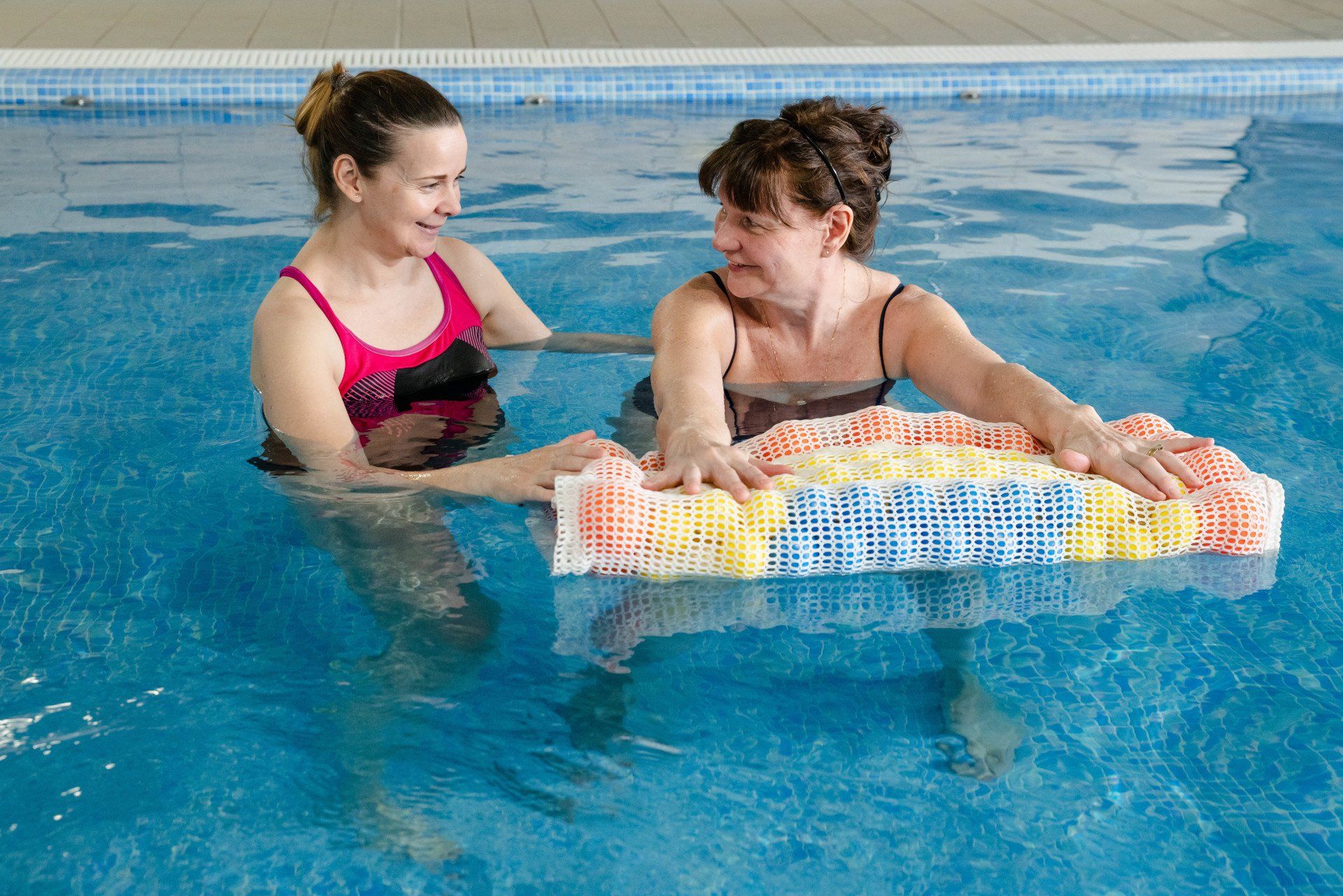
Slide title
Write your caption hereButton
Slide title
Write your caption hereButton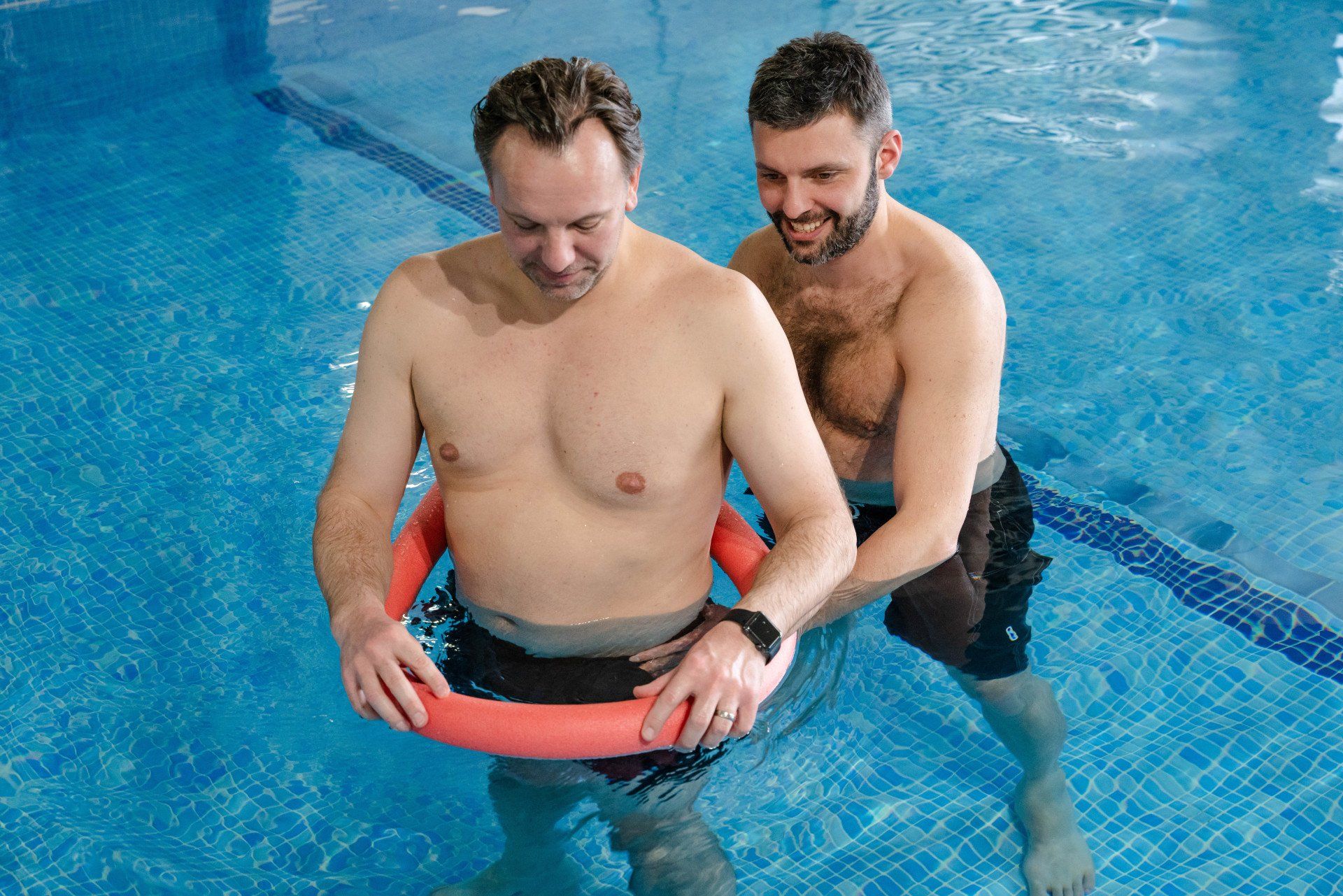
Slide title
Write your caption hereButton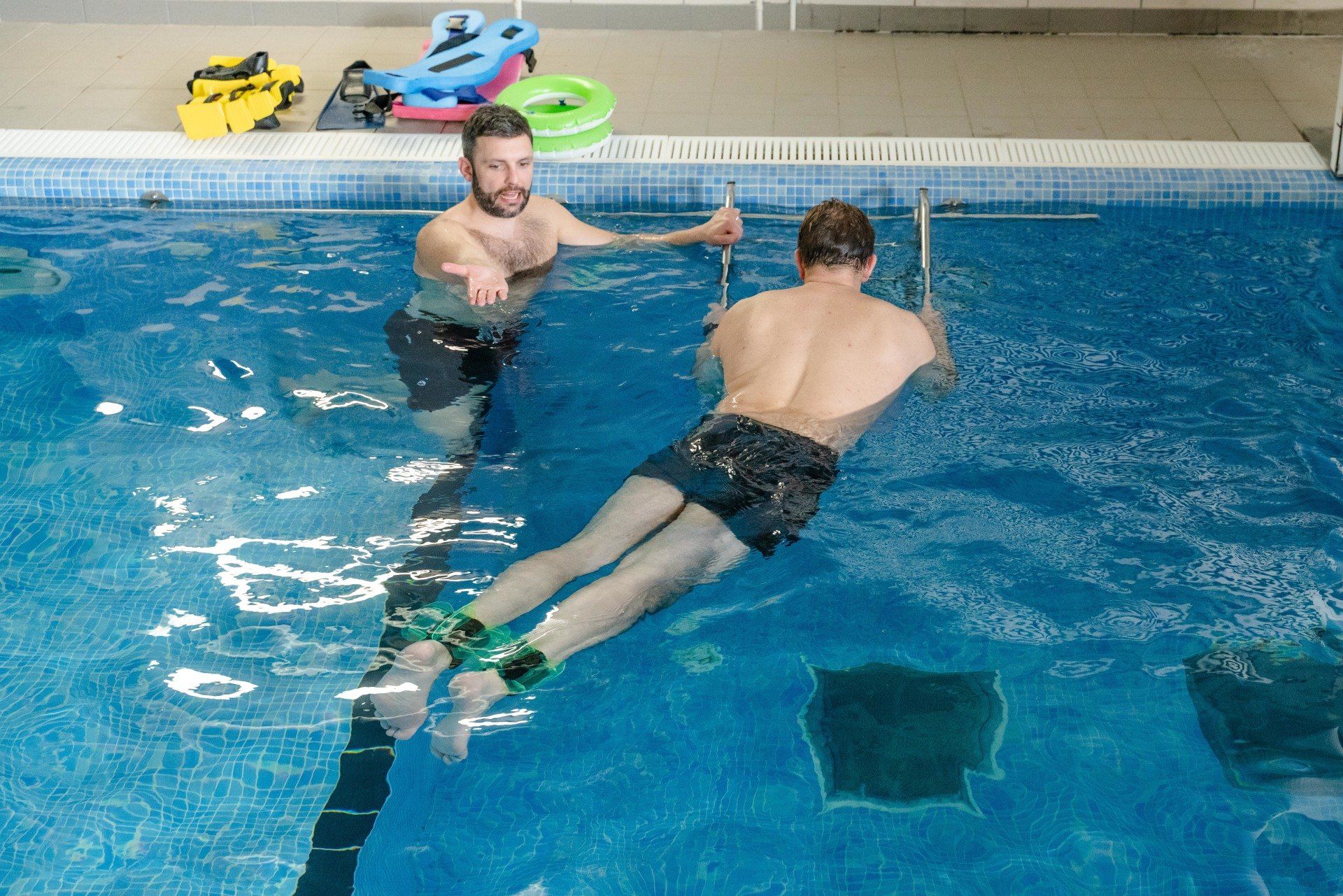
Slide title
Write your caption hereButton
Reduced Mobility & Stiffness
Are you struggling to walk around?
Decreased mobility can be caused by many physical factors such as older age, musculoskeletal and neurological conditions or even mental factors e.g. fear of falling.
How hydrotherapy helps:
- Warmth promotes relaxation and support from the water allows you to move with assistance easily and with little effort.
- Buoyancy of the water facilitates stretching of muscles and soft tissues and so increases range of movement.
- A safe environment for walking and moving with reduced fear of falling.
- Core stability and control can be achieved allowing control of upper and lower limb movements.
- Normal function can be achieved in the water and then worked on to carry over to land.
- In the water buoyancy assists upright postures and eliminates the gravity effect of land.
Reduced Mobility & Stiffness
Are you struggling to walk around?
Decreased mobility can be caused by many physical factors such as older age, musculoskeletal and neurological conditions or even mental factors e.g. fear of falling.
How hydrotherapy helps:
- Warmth promotes relaxation and support from the water allows you to move with assistance easily and with little effort.
- Buoyancy of the water facilitates stretching of muscles and soft tissues and so increases range of movement.
- A safe environment for walking and moving with reduced fear of falling.
- Core stability and control can be achieved allowing control of upper and lower limb movements.
- Normal function can be achieved in the water and then worked on to carry over to land.
- In the water buoyancy assists upright postures and eliminates the gravity effect of land.
"Thank you so much for your recent help. I really appreciate your expertise and knowledge of my situation as well as your openess."









